
The Project Gutenberg EBook of The Fantastic Clan, by
John James Thornber and Frances Bonker
This eBook is for the use of anyone anywhere at no cost and with
almost no restrictions whatsoever. You may copy it, give it away or
re-use it under the terms of the Project Gutenberg License included
with this eBook or online at www.gutenberg.org
Title: The Fantastic Clan
The Cactus Family
Author: John James Thornber
Frances Bonker
Release Date: July 1, 2014 [EBook #46155]
Language: English
Character set encoding: UTF-8
*** START OF THIS PROJECT GUTENBERG EBOOK THE FANTASTIC CLAN ***
Produced by Stephen Hutcheson, Chris Curnow and the Online
Distributed Proofreading Team at http://www.pgdp.net

BOOKS BY
FRANCES BONKER
AND
JOHN JAMES THORNBER
Copyright, 1932,
By THE MACMILLAN COMPANY.
All rights reserved—no part of this book may be reproduced in any form without permission in writing from the publisher, except by a reviewer who wishes to quote brief passages in connection with a review written for inclusion in magazine or newspaper.
Set up and electrotyped.
Published February, 1932
PRINTED IN THE UNITED STATES OF AMERICA
NORWOOD PRESS LINOTYPE, INC.
NORWOOD, MASS., U.S.A.
To the Memory of My Father
JAMES THORNBER
A Seeker After the Odd and
the Beautiful in Nature
J. J. T.
To My Aunt
LIDA PLANT TRUMBULL
A Collector of Rare and Unique Specimens
of the Weird Fantastic Clan
F. B.
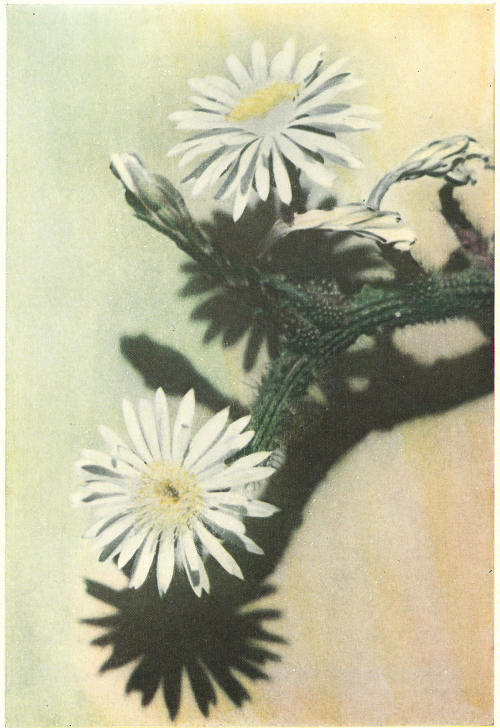
MEXICAN NIGHT BLOOMING CEREUS; REINA DE NOCHE; SERPENT CACTUS (Cereus serpentinus)
Studies of that unique and fascinating growth, the Cactus plant, treating of all the most important groups of Cacti known, with scientific accuracy, and depicting the charm of the desert land, its magic spell and wondrous lure, in the great Cactus area of the world, the American desert of the Southwest.
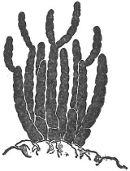
By JOHN JAMES THORNBER, A.M.,
Professor of Botany, University of Arizona
and FRANCES BONKER.
THE MACMILLAN COMPANY
NEW YORK MDCCCCXXXII
In this book we are going to introduce something new and interesting to many, the weird cactus plant life of the Southwestern desert—strange and marvelous growths which we call the Fantastic Clan; and to increase the reality and charm of the subject we will take an imaginary trip into the domain of the flowers of the desert. We shall explain here how to come to know them, and how to grow them in gardens; and we hope that, after reading, you will desire to have a cactus garden of your own, for the desert cacti are so different and so beautiful, with their symmetry of filigree and lacework, their fantastic shapes and marvelous colorings, and in many cases with a perfection of design that seems to have just come from the draughting board. We will not attempt to picture all the wondrous beauty of the Night Blooming Cereus, nor to tell how dainty the Arizona Rainbow and the California Pincushion really are. We will try, however, to treat in large measure about them, and about all the most important groups of cacti known to man, here in Mexico and our own Southwest, the great cactus area of the earth. We will show where they live and how they live, and in what manner they grow; and when you actually see them, in traveling across the Great American Desert, you will appreciate the wondrous beauty of desert creations and the flashes of brilliant color, gorgeous beyond description. No artist can paint nor pen describe the weird Fantastic Clan, as they are glimpsed peering out from under the rocks or gathered in clusters and patches surrounded with their [viii] dead-looking, drab-colored neighbors; or rearing their stately heads far above the ordinary walks of life in columnar pillars of towering strength. There is a fascination away out there on the desert; nevertheless, unlike the strange weird members of the cactus clan, we come not to stay, but only to enjoy the charm of the desert, to study and learn, and then to depart on our way.
Without help from the following persons and organizations, it would have been impossible for us to make such careful study of these plants, so widely distributed over the Southwestern deserts:
We thank Dr. James Greenlief Brown and Dr. Rubert Burley Streets of the University of Arizona for numerous photographs; Professor Andrew Alexander Nichol of the University of Arizona for rare species of cacti collected; Dr. Forrest Shreve of the Carnegie Institution of Washington for specimens of plants and photographs; Evelyn Thornber for pen-and-ink drawings of cacti; Miss Frances Hamilton, Mr. William Palmer Stockwell, Mr. Frank Henry Parker, and Mr. Barnard Hendricks for assistance in making careful studies of the cacti; the University of Arizona and the Desert Botanical Laboratory of the Carnegie Institution for help in procuring specimens of cacti for comparative study.
We are deeply indebted to Mrs. John Wilmot Estill of Los Angeles, California, for her exquisite paintings used in this book.
John James Thornber
Tucson, Arizona
Frances Bonker
Pasadena, California
October 1, 1931
We believe that many readers are interested in the mysterious plants and flowers of the desert, especially of the great Southwest. Here in our own back yard, as it were, in sunny California and also over in that great sand pile of southwestern Arizona, sometimes called the “Studio of the Gods,” time has carved and chiseled out wonderful valleys and cañons, and graced their floors with tiny streams of water like threads of molten silver on burnished sands. This desert fairyland is brimful of Nature’s most curious plants and flowers. Here in Nature’s workshop you will find plants and flowers weird and marvelous, of fantastic shapes and grotesque design, of glowing hue and exotic fragrance.
Out where rock and sand and gravel, and sagebrush and mesquite and chaparral struggle hard to hold on to life, the giant cactus, Sahuaro, the Old Man cactus known as Cereus senilis, the Prickly Pear Opuntia, and the wonderful Night Blooming Cereus live on peacefully and quietly and seem to smile down on man and beast and reptile, in the magnificent splendor of their brilliant flowers and fruit in the spring. Drought or rain in plenty seems to make but little difference to most of these, for the reason that Nature, the Great Engineer, has given these plants a unique structure which enables them to store up enough moisture in their reservoir systems to last, in some cases, as long as three years, if the rains should not come. It would tax man’s ingenuity to the utmost to beat that!
Do you know how the Cursed Cholla gets its name? or why the cactus spines are such a puzzle to the botanist? or the romance Time has woven round the Night Blooming Cereus? or why the Barrel cactus is the Indian’s friend in time of drought, the traveler’s friend when lost? or why the Fishhook cactus is called by that name? Would you know a Pipe Organ cactus if you saw one? Do you know that the Strawberry cactus or Hedgehog is delicious for food?
“The Fantastic Clan” tells you about all these things. In this book we take you on a pleasant journey through a wonderland of plant life, stopping at lonely isolated spots to view the Night Blooming Cereus cactus, whose ethereal beauty vies with the famous orchids of the South American forests. And to see this lovely queen in all her pristine beauty will make you forget the orchid and the rose! We also get a glimpse of the Hawaiian Night Blooming Cereus, so exquisitely beautiful that, for ages, in faraway Hawaii magnificent fiestas have marked the opening of the buds and the blooming of the Night Blooming Cereus.
Then we take you into the presence of the giant cactus, Sahuaro, which in a previous volume we have called the Sage of the desert; steadfast, towering pillarlike fifty feet into the air, he gives a sense of power to all who behold him, some certain realization of the grandeur and the mystery of God’s creations here on Earth.
The Serpent cacti, with their grotesque angular arms projecting like so many sinuous tentacles, claim our attention next; and the Prickly Pears, advance guard for the entire cactus clan, pass before our gaze. Many, many others, of fantastic shapes and distorted growth, freaks of nature, also numbers of God’s glorious creations, flowers of ethereal beauty, trees, majestic and noble, crowd into this picture stretched before our eyes in one vast scene of limitless sand, the Great American Desert.
Kipling once said, “When you’ve heard the East a-calling, you won’t have anything else.” And this is true of the desert. The charm of the desert, once it gets its hold on you, always brings you back. There are no fears nor dreads out there; it is the place where mankind can go and rest.
When springtime comes it is time to be on the move, to see new places, new things, to enjoy, to learn. Early in April we start on a trek or trip by automobile across the Giant Amphitheater of the Sun, somewhere on the great desert along the Mexico-California frontier and thence on into Southern California; seeking out the plants and flowers which appear now in gay spring tints and hues, scrutinizing their wondrous beauty, their colorings and fantastic shapes, their scientific make-up and their dwelling places, and occasionally their grotesque appearance.
The desert is an enormous caldron of burning sand, rolling and rising and sinking here and there. But in the spring these arid lands present a striking parade of beautiful flowers—a veritable fashion show! It is early in the morning of a cloudless April day; the night dew is on most of the blossoms, and they are fresh from its bath. There is no dust and their colors are still bright as we inhale the fragrant scent. The desert glow is brightening, for the sun is rising just over the eastern rim of the foothills, and we stop to gaze upon the first of a colony of cacti called the Cereus Group. The name Cereus is musical; we find that it is from the [2] Latin, meaning torch, and is given to this genus in the family of Cactaceæ because of the beautiful candelabralike branching of some of its members.
They are trees, shrubs, or climbers, growing erect or spreading out with ribbed branches; they are the tallest and largest of the Cactaceæ. The flowers are funnel-form, some are elongated and very showy, and we find that they bloom mostly in the darkness of the desert night. Perhaps this night blooming accounts for the softness and brilliance of their delicate colorings, as of the orchids, the most gorgeous of which as you know come from the deep shaded forests of the South American jungles. The genus Cereus is very large, comprising more than two hundred varieties. Their native habitats are in South America, Central America, the West Indies, Mexico, and southern United States.
Lower California, Magdalena Island
The first of these growths to attract our attention is the weird Creeping Devil cactus! How apropos is this nomenclature! We see it here in Lower California, Cereus eruca, creeping along the coastal lands and over the fine drifted sands of the seashore like countless thousands of caterpillars crawling over the ground, worming their way slowly across the sandy plains to the sea. This remarkable cactus grows on the coastal plains of Lower California and is abundant on Magdalena Island in very sandy soil, preferring the softer sand for its habitat and particularly the wind-drifted material, over small areas of which it forms a more or less continuous covering, broken here and there by dead stems. In [3] the clumps of this cactus the desert foxes live; for in its natural habitat it prevents the sand from drifting and offers homes for the little animals of the region.
The stems lie flat on the ground with their tips somewhat upturned, thus resembling huge caterpillars, head and body; they grow along on the ground, rooting from their lower surfaces, elongating at the tips, and dying back behind, which results in a slow forward movement of the whole plant. When this cactus meets with a log or stone the stem with its upraised tip gradually grows over this hindrance, up one side and down the other, and by the dying back of the rear end, in time passes over the obstruction. The stems, varying from three to nine feet in length and nearly as large as a man’s arm, are very spiny, with fifteen to twenty radial and central thorns of a dark brownish hue and dull tan, turning to grayish white with age, the tips translucent yellow. The flowers are bright yellow, the fruit delicious and relished by Indians and Mexicans both as a salad and as a preserve.
Lower California, Sonora, and Southwestern Arizona
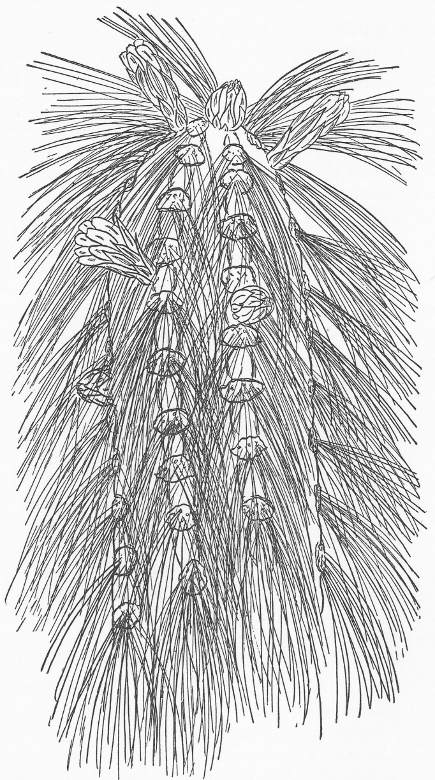
SENITA, ZINA, OR SINA (Cereus Schottii)
The next growth to attract our notice is that called by botanists Cereus Schottii or Lophocereus Schottii. It is named also for convenience Senita, Zina, and Sina. This is a remarkable cactus found in Sonora (a state of Northern Mexico), southwestern Arizona, and Lower California under the most arid conditions. It grows commonly in colonies and patches in the mountain cañons and there enjoys protection that the individual plants do not have. The young plants are equipped with silvery, short, stout spines, and the old ones with slender, long, flexible bristles, grayish or purplish gray, giving the appearance of old age—hence the [5] common popular name of Senita. At a little distance these bristlelike thorns appear like fine purplish bands, from their symmetrically twisted spiral arrangement on the five- to twenty-foot yellow-green stems, which are supported by wooden cores or scalloped cylinders. Senita plants are very striking on the arid mountain slopes, along the foothills, and in protected valleys and cañons where the winter is warm and the summer hot, their dense branches often interlocking in huge clumps twenty feet across and twenty-five feet high. Their bristly stems resemble somewhat a squirrel’s tail or bottle brush, and in Mexico the plants are grown for fences which are unique and effective. The flowers are about an inch and a half long and as wide, shaped like a bell, with very lovely cream-white and pale pink petals shading into deep pink at the tips. The fruit is a greenish brown changing to dull red when mature, and globose. The blossoms and fruit of this species are rather small for the Cereus; the flowers open in the evening and close in the morning, and while delicate are not at all showy.
Lower California, Northern Mexico, and Southwestern California
Bergorocactus Emoryi, as he is sometimes called, is a little fellow to have such a long name. He is odd and rather humble, and very much resembles the Hedgehog Cactus, another group of Cereus, entirely. He grows well on the arid hillsides near the southern coast in San Diego County, California, and in Lower California; perhaps we should call him the “Prohibition cactus,” for he likes his home place dry. A foot or two high, he grows in thick impenetrable masses ten to twenty feet across, and covered with a dense spiny coating; fifteen to thirty slender, yellowish, needlelike but stiff [6] thorns, half an inch to an inch long or longer; pale yellowish brown flowers, quite small and clustering toward the tips of the stems. As we stop a moment here in Lower California to view him, we see that he is somewhat interesting, but though a member of the noble tribe of Cereus not attractive to us as a weird cactus, having little to suggest the dignity and grandeur of the giant Sahuaro, the uniqueness of the Pipe Organ with its finest of fruit, or the exquisite blossoms of la Reina de Noche, queen among desert flowers.
Mexico
Next in line of our fashion parade comes the Cereus senilis, sometimes called by the botanists Cephalocereus senilis (a polite way of saying “old man”). For a long time he has been one of the most popular of the Cactus Clan. He grows well in cactus gardens and conservatories, here and in Europe, and is greatly in demand on both continents; his habitat is the limestone foothills and mountains in northern and central Mexico, and is rather inaccessible. We find that the radial spines of the young plants are transformed into coarse white translucent hairs from four to twelve inches long, and, being deflexed like long gray hairs, suggest the name of “Old Man Cactus.” In the varying conditions and locations where he grows, he is sometimes called the “Bunny” or the “White Persian Cat” cactus. All the spines are fragile and break easily, and hence the Old Man cactus should not be handled more than is necessary. In maturity he grows around his head a dense mass of tawny wool, sometimes longer on one side suggesting a hat cocked to left or right, which gives the tall plant a most grotesque and rakish appearance. This cactus is columnar and little branched; in some instances he grows to a height of forty-five feet, and [7] is a very imposing sight in the landscape. The stems and branches are pale green or yellow-green with a scurfy waxy coating over the surface, are not tough, and sometimes a large tree can be cut down with a small pocketknife! The rose-colored flowers are bell-shaped or funnel-shaped and night-blooming, appearing only on the older plants. The inch-long fruit is rose-colored and covered with scales and tufts of hair or short wool! How strangely at times Nature does her work!
Lower California, Sonora, and Southern Arizona
An aristocrat of the Cactaceæ claims our attention next, Cereus Thurberi, called also the “Pipe Organ” cactus. It grows well in the arid mountain regions, on the lower mountains and flats of Lower California and from Sonora in Mexico to southern Arizona, usually in colonies, seeking the rocky, gravelly soil in foothills and along the mountain cañons. Notice how it branches near the base and grows from ten to twenty feet tall; very erect and stately, the plant makes quite an appearance in green armor with a thin waxy coat. Surrounded by smaller patches of cacti where it towers well over them all, Thurberi presents a very striking picture in this setting of old Mexico or Lower California. We note that its great columns of yellow-green cuticle look much like the pipes of a giant organ silhouetted against the sky away out on the desert; hence the name Pipe Organ cactus or Pitahaya. We might even fancy that the rush of the wind through mountain and cañon, with its piercing shriek or duller roar, the song of the desert, is music emanating from the giant pipes of this great Organ cactus of Arizona and Lower California. The flowers, like those of many others of its kind, bloom in the night and are usually closed [8] by nine o’clock in the morning; growing in the tops of clusters of slender spreading grayish spines, lining the fifteen or twenty ridges of the stems, and, it is to be noted, appearing only on the tips of the stems; beautiful blooms three inches long with white margins, the delicate petals light pink with green and white bands along their edges, the innermost petals satiny white with some pink above, gradually toning into the purple-red of the sepals. The fruit of “Pitahaya dulce” as the Indians call the plant, globose, olive-green, with a crimson sweet fleshy pulp when ripe, is a rare delicacy and is highly prized by Indians and Mexicans for the making of jellies and jams, conserves, syrups, and sweetmeats. From the syrup they also make wine.
Mexico
In one of the cultivated gardens of Northern Mexico we are introduced by the hospitable natives (half Mexican, half Spanish), to that weird and striking growth, the Cereus serpentinus, known also in the realm of botany as Nyctocereus serpentinus. Any one of its long sinuous tentacles, the six to fifteen entangled stems, might easily remind one of the twisted body of a serpent springing at its intended victim! This is a Night Blooming Cereus cactus, supposed to be a native of eastern Mexico, where it grows half wild in hedges and over walls, but its habitat is uncertain. The stems, eight to fifteen feet long, grow erect for about ten feet, and then bend over or are pendent for several feet; on top of the ridges running along them are clusters of slender spreading cream-white and reddish brown spines, flexible and not stiff like those of most cacti.
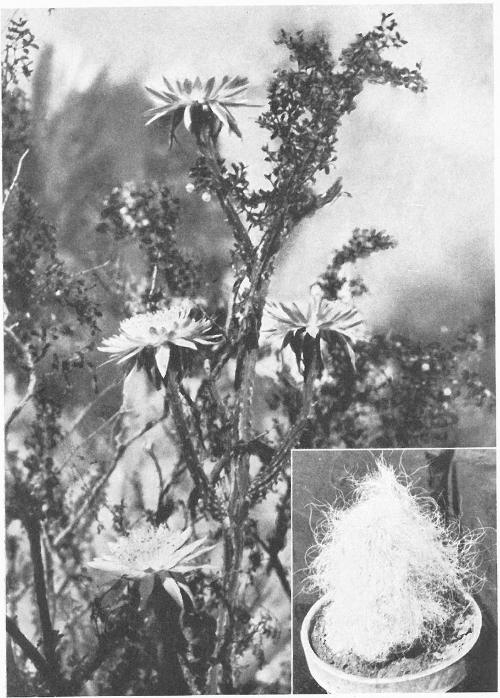
NIGHT BLOOMING CEREUS; GODDESS OF THE NIGHT; LA REINA DE NOCHE; THE QUEEN OF NIGHT (Cereus Greggii)
You must come to the desert in the soft shadows of the moonlit night to see the ethereal beauty of this rare and exquisite flower. For only one night in each year does the flower queen come forth into bloom, scenting the warm sweet air of the desert land for miles and miles, while thousands of people, Indian and white, gather for the brilliant spectacle of hundreds of thousands of waxy white blossoms. Then no more may the eye of man behold the lovely colorings, nor sense the exotic perfume of the Goddess of the Night, until her appointed time comes yet again in the Desert Land of Plants and Flowers.
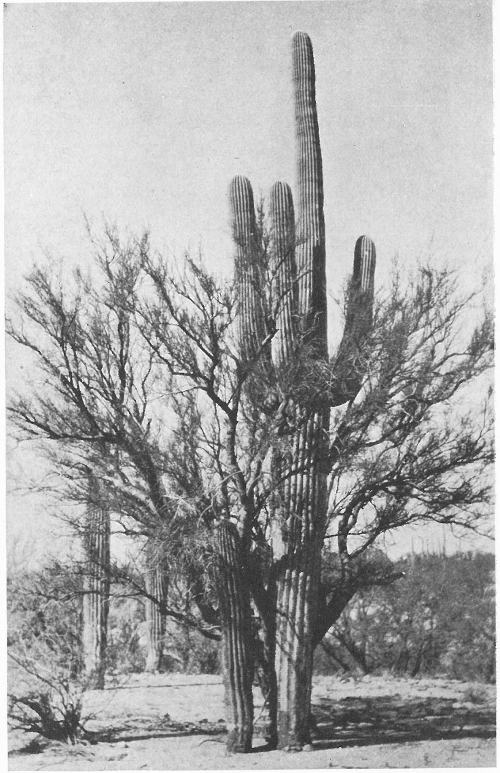
SAHUARO OR GIANT CACTUS (Cereus giganteus); AND PALO VERDE
The noble “Sage of the Desert,” towering fifty feet into the air, oldest and largest of the American Cacti, often attaining the age of two hundred and fifty years, entwining with the Palo Verde.
Why are such names as la Reina de Noche (the Queen of Night), Mexican Night Blooming Cereus, Junco Espinoso, given to this Cereus? We see the answer in the large bloom nearly a foot long and over seven inches wide, of a delicate tan-pink in background, shading into the soft cream-white of the petals, then the corona of stamens, a symphony of pale yellow and white; touches of green grace the bases of the sepals, and the whole forms a lovely picture against the background of old adobe dwellings, evanescent and brilliant in the white rays of the southern moon. And the fragrance of this lovely Cereus! The perfume from a single blossom will fill a large room or a whole yard: a pronounced spicy odor somewhat like that of a tuberose. This beautiful flower resembles that of the Cereus Greggii, our own Night Blooming Cereus. Its delicate colorings and poignancy of perfume make it one of the finest blossoms of the flower kingdom, much in demand for cactus gardens and window decoration. The showy beauties are highly prized by Mexicans and Spaniards as well, both in Mexico and abroad. Strictly night-blooming, and opening but one night in a season, the beautiful blossoms begin to unfold soon after sundown, having increased rapidly in size the day before, the loosened sepals and petals giving the flower the appearance of an inverted flask; the blossoms close soon after sunrise unless the day is cloudy, when they remain open until late afternoon. This blossoming, however, continues on different plants during April, May, and even into June. With favorable conditions the weird serpent plants run wild and grow luxuriantly, forming very striking hedges; and they are most attractive as climbers over the Mexican adobe walls.
Southern California, Southern Arizona, and Mexico
That fellow over yonder is Cereus giganteus, or Carnegiea gigantea; he is “old Sahuaro” (pronounced “sa-wáh-ro”), [10] Saguaro, or Giant cactus. Sahuaro is the “Sage of the Desert” because of the great age he attains, often two hundred fifty years or more. He is the giant tree of the cactus clan. There are Sahuaro out on the Great American Desert that were old when the thirteen colonies became a nation in 1776. Proud and dignified and stately they stand out there in the great alone, silent sentinels of a long gone past still hardy in the towering strength of their great age, with yesterday gone forever and looking to the day that is yet to come.
Near sunset we may fancy them in silent meditation as if determining some mooted question of time or weather. For in case of long continued drought the reservoir systems of these great trees store up enough moisture to last them for three years, and they will blossom and fruit just the same without fail and on time! Over the entire length of these giants, run long ridges or flutings, which serve the plants as miraculous reservoirs for water: as the ridges expand, the plant becomes water-filled; and as the great tree uses up its moisture, these flutings contract into proper position, thereby exhibiting but one of the many marvels in engineering consummated by Nature, the Great Engineer. Along his twenty or twenty-five flutings she has given Sahuaro a formidable array of long sharp spikes which defy the approach of man and beast alike: grayish black spines, clustering on the lower ridges of the plant and never bearing flowers, and clusters of yellowish thorns, on the upper part of stem and branches, that bear the blossoms and fruit.
Thirty to fifty feet tall, these sentinels of the desert tower above the baby Pincushion, the Cholla, the Creosote and Desert Sagebrush, and the other Cerei, which seem but tiny dwarfs in comparison. Columns of their massive trunks grow singly for a distance of ten to fifteen feet, then curve abruptly erect in candelabralike branches, terminating in [11] masses of waxy white blossoms, the whole giving strongly the effect of a lighted candelabra in the dazzling sunlight. Full-grown Sahuaro weigh six tons or more; they are very sturdily constructed, vigorous and hardy, caring not for wind or weather or time. Woodpeckers make their homes in the waxy green trunks of old Sahuaro, and the injuries made by birds are sealed over by a coating of tissue from the plant itself. These coverings often take form of water containers and are so used by the Indians. The spiked armor causes Sahuaro to be feared by man and bird and beast, and the bold woodpecker and the hawk are almost alone in venturing to nest in their trunks.
In flower time the blossoms are produced in abundance on the tips of stem and branches, large satiny blooms four inches or so long and half as wide, growing solitary but in such great masses of waxy white bloom as to give the effect of being clustered; as usual with the Cereus, remaining open all night and closing in the forenoon. The Department of Commerce at Washington is taking steps to develop the fruit of the giganteus as an article of commerce. Shaped like an egg and about the same size, its crimson red pulp is made into wine by native Indians and Mexicans, preserved as jam and fruit in clay ollas, and after drying in the sun served as delicious sweetmeats to the whites trading near by. In June, when the sun is blazing hot, the Papago Indians camp in forests and harvest the fruit of old Sahuaro, while the dead plants furnish material for the building of their huts and adobe dwellings, the “ribs” used for rafters and poles, and even for fuel. The ceilings of many old buildings in Tucson, Arizona, were made of Giant cactus ribs, several layers deep. Many an Indian life has been saved by old Sahuaro in time of severe drought. Is it any wonder that the Papago begins his New Year in June with the fruiting of the Giant cactus?
The beautiful blossom of the Sage of the Desert is the [12] state flower of Arizona. A hundred miles west of Tucson, Arizona, is a great forest of these noble cacti, the Papago Sahuaro Forest of Arizona, while another forest of the great trees is a little to the east of the state capital, Phoenix. The Giant cactus thrives best in the rocky valleys and foothills along the low mountain slopes and cañons, and prefers a southern exposure. He likes a sandy, rocky soil where the roots can go down deep, or run long distances underground. He begins his life under the protection of some other plant or shrub, and in time crowds out even his protectors. Near Victorville in Southern California, in northern Mexico, and through all of southern Arizona, “constellations” of huge massive Sahuaro, viewed by the traveler for the first time in the ghostly light of the moon, are a sight never to be forgotten. Like apparitions they seem in the white rays, strange and noble figures of another world appearing before us in these fantastic desert plants; it is as if a graveyard had suddenly delivered its dead! Silent and mute and still they stand; waiting and watching and never seeming to die. And here we must leave these majestic plants to their heritage of the desert, above whose blazing sands they tower serene and untouched by the life struggle silently going on around them.
Southern California, Mexico, Southern Arizona, and Texas
The fashion show of the desert is about to close, for we see approaching us in southeastern California the Cereus Greggii, the typical night blooming cereus. Have you been in the Hawaiian Islands? Have you attended any of the early Spanish fiestas? Have you heard the stories of the Night Blooming Cereus? If so, you have heard about the most beautiful, the most fragrant of flowers! No flower garden [13] or conservatory is complete without this graceful queen of the desert, whose evanescent beauty surpasses the orchid and the rose; for the delicate shadings and exquisite colorings of the South American orchid are no finer than those of this night blooming cactus. Pen or brush in the hand of the genius scarce can do justice to the loveliness of Nature’s handiwork, the Goddess of the Night. Most popular of all the cacti, she delights to grow wild on the desert mesas, where the sensuous spicy fragrance of her beautiful blossoms perfumes the air for miles around, along the bajadas in western Texas and Southern California, over the mesas of southern Arizona and far down into old Mexico. Never in abundance, this rare flower grows in twos and threes under a creosote, cat’s-claw, or other desert shrub, which affords the flower goddess protection from the hot desert winds that at times sweep over the mesas and down the cañons, and from the blazing heat of the noonday sun. She prefers a deep sandy loam along the swales or draws of the desert, at altitudes of twenty-five hundred feet and more, though sometimes she appears on the mountains as far up as forty-five hundred feet; and related varieties, Cereus pentagonus and Deeringii, even grace the plains at sea level in the swampy lands of Lake Okechobee down in the south of Florida. Another cousin, the Cereus undatus, grows wild all over the tropics, and is a great favorite among natives and whites in Honolulu; around Punahou College there, in Punahou Valley, the hedge of this Night Blooming Cereus is a half-mile long, and on a single night five thousand blossoms have unfolded! This bloom, often twelve inches long, is the best known of all the Night Blooming Cereus flowers.
Two to eight feet in height, the blackish green angular grotesque stems bearing the lovely flower queen, almost like a crooked stick or dead snake in their fantastic appearance, form a strange contrast to the ethereal beauty and fragrance [14] of her blossoms. Often mistaken for a dead stick, these loosely branched and densely fine hairy stems of the Cereus Greggii are rarely noticed on the desert; but we who are fortunate enough to have a guide can perceive that the thin half-inch base of the trunk is narrower here than a few inches higher up, almost like the slim neck of a snake. Each slender trunk consists of a central woody core one-fourth inch in diameter, covered by a series of furrows to draw up the moisture which is stored in the fleshy beetlike root, weighing fifty to a hundred pounds and buried deep in the ground where it forms a reservoir of water and food lasting for more than two years. Thus, rain or shine, the delicate flower goddess may bring forth her lovely blossoms at their appointed time. Then too, Nature has provided her favorite with finely barbed, stout stiff hairy spines, about one-eighth inch long, growing on the areola so as to resemble a small insect of the desert.
The flowers are from seven to ten inches long and about six inches across, with a delightfully spicy fragrance, which at times is quite strong. The colorings of the Greggii are a wondrous harmony of tint and hue. The background of color forms a corona of waxy white and rich creamy yellow that looks as if it had been chiseled out of a rare old marble, with no duplicate in all the world; shading beautifully into the white of the petals, with their hint of pale lavender diffused throughout with touches of tan and pink; sepals and petals recurving into a graceful cornucopia.
It is no wonder that Indians and Mexicans revere their lovely “Queen of Night,” Reina de Noche, or that, across the sea in Honolulu, a grand celebration marks the opening of the blossoms of the Hawaiian variety, which occurs but once a year! During Queen Liliuokalani’s reign many were the ceremonies to Pau on occasions of the flowering of the Night Blooming Cereus.
You must come to the desert in the soft shadows of the moonlit night to see the ethereal beauty of this rare and exquisite flower. For only one night in each year does the Cereus Greggii come forth into bloom, scenting the warm sweet air of the desert land for miles and miles with poignant fragrance. When the shadows begin to lengthen and the deepening glow of sunset approaches, the satiny blossoms begin to open (having already loosened and expanded); in an hour or so they are fully opened, and as one stands watching them curiously one can actually see them moving and lifting from minute to minute, the petals seeming to tremble, so forcibly is Nature causing them to expand. One can detect the lovely fragrance as soon as the blooms start to unfold. During the night thousands of people, Indian and white, gather for the brilliant spectacle of hundreds of thousands of waxy white blossoms; others celebrate in the popular fiestas of the Southwest in old Mexico, or the luaus of far-away Hawaii. At sunrise of the day following, or shortly thereafter, the goddess flowers begin to fold, and by nine or ten o’clock on a cloudless morning they are entirely closed. No more may the eye of man behold the lovely colorings, nor sense the exquisite perfume of the Goddess of the Night, until her appointed time comes yet again in the Desert Land of Plants and Flowers.
And now the parade of the Desert’s Fashion Show is over and night is closing in. But if you wish to see the real show and to appreciate the real beauties of the desert land in flower-time, you must go into the silent sandy wastes when the sun is gone and the moon is coming over the mountains, spreading its gossamer silvery sheen over the floor of the desert in crazy shadow-patch, and watch the blossoms come slowly open, one by one, to receive the kiss of the night dew and the gentle caress of the newborn breeze. For you have [16] not looked upon matchless beauty nor sensed the sweetest perfume, till you have been out there in the great alone, where Beauty comes and fades and dies, and is born again in the ceaseless tide of God’s evolution of men and things, in the great Eternity of Being.
In general cacti like warm or hot sunny southern exposures; they grow best in sandy, gravelly, or rocky loam or clay soils, according to the habits of the species; they succeed best with good drainage, a moderate or limited rainfall or a limited amount of moisture in the soil. They should have occasional dry periods to harmonize growth with their original desert habitats, and also all the summer heat possible. This produces the contracted growth characteristic of cacti with all their desert beauty and symmetry of colors and arrangement of spines, and their fine large showy flowers. Cacti do best in regions of limited rainfall and maximum sunshine, blazing-hot summers, and mild winters where the temperatures keep well above zero.
The bad effects of heavy rainfall can be overcome largely by including in the soil a large proportion of sand or gravel or cobblestones and by growing the plants on ridges or raised borders. The effects of fog and extreme humidity can be corrected somewhat by growing them in dry conservatories. Where the temperatures fall below the lowest temperatures given in the section on “How to Grow” for each species, cacti must be grown in warm greenhouses in winter and preferably throughout the year—with the exception of the hedgehog cacti, which rarely grow successfully in greenhouses. With the specific information given under the heading “How to Grow” for each species, it is possible to grow cacti successfully in the tropics and over a large part of the [17] temperate zone. The important things are: warm sunshine, protection from too low temperatures, the right kind of soil, and limited watering or irrigation.
Cacti may be grown out of doors in the entire southwestern section of the United States, in Mexico, Central America, and South America (except the southern part), where the temperatures are never colder than fifteen to twenty-five degrees below freezing. Also, they can be grown successfully out of doors in parts of Spain and Portugal, and in the region immediately bordering the Mediterranean Sea, over much of Africa lying at the lower altitudes, in Arabia, Persia, India, southern China, extreme southern Japan, and the northern half of Australia, in addition to the islands of the Pacific, nearly all of which lie between the 33° parallels, north and south (except where the temperatures are modified by mountains or other natural features).
They can be grown indoors generally in the north and south temperate zones between the 34° and 54° parallels, north and south, where the temperatures reach as low as twenty to thirty degrees below zero. This includes the northern two-thirds of the United States, the lower half of the Dominion of Canada, Great Britain, Ireland, France, Germany, Austria, the northern half of the Chinese Republic, Japan, and the southern part of South America.
Many species of this group can be identified by the beautiful candelabralike branching of the plants. They are trees, [18] shrubs, or climbers, and grow erect or spread out, the tallest and largest trees or plants of the cactus family. They are the “torch flower” cacti, are tropical or subtropical, the stems growing single or clustered, with prominent ridges or flutes which in many instances expand or contract as the plant fills with water or loses its moisture. The tubercles are not conspicuous and grow in rows on the ridges. There are no leaves nor spicules. The spines are of one or two kinds, sharp and dangerous in some species, inconspicuous in others, growing from one-fourth inch to twelve inches in length. The flowers are funnel-form, of brilliant or delicate colorings, large and showy, and unlike many cactus blossoms are fragrant, often with a pronounced spicy odor. In some instances they crown the candelabralike branches in a becoming aureola of light, giving the effect of a lighted candelabrum; hence the designation “torch flower” cacti. Most species bloom only at night. As a rule the calyx tube is found to be very long. The fruit is usually quite large, has shallow tubercles, and is covered with many scales, but is rarely spiny.
Only a few of the different kinds of the Cereus Group grow well from cuttings, including Cereus serpentinus. Set the cuttings of such plants as this Serpent Cactus a few inches deep in moist sandy soil and irrigate sufficiently to keep the soil moist. The cuttings grow best in part shade. Cereus plants grow readily from seeds sown in sandy loam mixed with a small amount of pulverized charcoal and some leaf mold; plant in pots or flats one-fourth inch to one inch deep in the soil in partial shade, and keep the soil moist. The young plants can be transplanted to pots when one-half inch to one inch tall. They grow indoors or out; a southern exposure is preferable, being warmer and more sunny.
(Named “eruca,” or “caterpillar cactus,” because the stems turn upward at their tips, resembling a caterpillar, head and body)
The prostrate stems, three to nine feet long, lie flat on the ground with their tips upturned, resembling huge caterpillars. They grow in light sandy soils or sand, and root from below, the tips of the stems elongating and growing forward, the bases of the stems dying; thus the plant slowly moves forward over the sand. These prostrate stems, two or three inches in diameter, are very spiny, with fifteen radial and four central spines clustering an inch or so apart on the twelve to seventeen ridges which run lengthwise on the stems. These fierce, sharp thorns are dark brown and dull tan and turn white with age; the tips are translucent yellow. The radials are less than an inch long and flattened, the centrals grow to two inches in length, one very stout and strongly flattened, resembling a dagger and with a white body. The large flowers are bright yellow and grow four or five inches in length, narrow and funnel-shaped, about two inches across. The fruit is very spiny; but the thorns fall away at maturity, and it becomes quite edible and is relished by Indians and Mexicans.
Plant in sand or sandy soil, preferably fine sand, with the tips slightly upward, and keep the sand lightly moist. The plant requires a hot, sunny location and will grow out of doors in the Southwest where the temperatures do not drop more than a few degrees below freezing, and in hot dry [20] conservatories and greenhouses where the temperatures drop lower.
(Named from its appearance of old age, and for F. A. Schott, a botanical explorer of western United States)
These plants grow in colonies or patches in the mountain cañons, twenty to fifty stems in a clump, the dense branches interlocking in huge clusters twenty-five feet high and twenty feet or more across. The yellow-green stems are scalloped and cylindric, five or six inches in diameter, growing four to twenty feet or more in height, with five to nine ridges running lengthwise from top to bottom. On these ridges cluster the spines, silvery stout thorns about one-fourth inch long on the young plants; the older spines are really dense bristles, slender, flexible, symmetrically twisted, appearing like fine purplish gray bands, one and one-half to three inches long, and giving the appearance of old age. The flowers are shaped like a bell an inch and a half long and about as broad, pale pink and cream-white petals shading into deep pink at their tips, opening only at night. The fruit is globose, an inch or more in diameter, of a deep reddish tinge, and fleshy.
Plants may be grown from seed in sandy soil in flats or pots; young plants may be transplanted in spring in sandy, gravelly, or rocky soil. Water during dry weather enough to moisten the soil well. The plants can be grown out of doors only where the coldest winter temperatures are but a few degrees below freezing. In other parts of the country, grow in hot, dry conservatories or greenhouses.
(Named in honor of Lieutenant Colonel Emory, who was in charge of the Mexican Boundary Survey)
This is a low-branched plant a foot or two high, growing prostrate with erect branches in thick impenetrable masses ten to twenty feet across. Numerous stiff, needlelike thorns form a dense spiny yellowish coating over the entire mass. There are many pale yellow to yellow-brown flowers an inch and a half long which cluster near the tips of the stems. The fruit is globose and densely spiny, an inch or so in diameter. The plant is not attractive nor very cereus-like.
This species can be transplanted in the spring by digging rooted stems, planting in gravelly clay soil, and irrigating sufficiently to moisten the soil in dry periods; or by digging a shallow hole and partly covering the stems with soil kept moist but not wet. The plants will grow out of doors and endure only a few degrees of frost; where the temperature drops more than fifteen degrees below freezing they must be protected outside, or grown indoors or in a warm, sunny greenhouse.
(Named from the long white hairs or beards found on young plants)
This cactus is columnar, and some mature plants reach a height of forty-five feet. It is native to Mexico and not [22] easily accessible. The trunk is usually unbranched, cylindrical in young plants, two or three inches in diameter, yellow-green with a scurfy waxy coating; and it is not tough. A large tree can be cut down with a small pocketknife in some instances. The twenty or twenty-five radial spines are changed over into long coarse white hairs, four to twelve inches long or even longer, and form a dense covering; hence the common and specific names, Old Man Cactus and senilis. These radials are crooked, flattened, and twisted, while the one to four central thorns are easily pulled out, all spines very fragile. In maturity a dense mass of tawny wool appears around the head of the plant. The rose-colored blossoms are two inches long, shaped like a bell or funnel, and appear only on the older cacti. They open at night and close in the early morning. The fruit is about the size of a large strawberry; it, too, is rose-colored and covered with scales and tufts of wool.
Plants may be grown from seed in flats or pots, but the seed is rare and difficult to get. Commonly young plants are purchased and grown in pots in gravelly, sandy limestone soil. Water sufficiently to keep the soil slightly moist. A bright sunny location is best. The plants are tender to frost and thrive best in warm conservatories or greenhouses. The Old Man Cactus is a popular plant for rock gardens and is found in many homes both in this country and abroad.
(Named in honor of George Thurber, botanist of the Mexican Boundary Commission)
These are large, columnar, symmetrical plants ten to twenty feet tall; the large columns of yellow-green stems, [23] in six to thirty branches ascending from near the base, look much like the pipes of a great organ at a distance. The stems are from six inches to nearly two feet in diameter and are cylindrical, with fifteen to nineteen ridges lined with clusters of slender, spreading, grayish spines. The flowers, which appear only at the tips of the stems, are three inches long and half as wide, and open always at night; their delicate pink petals are suffused with green and banded in white or green, and their purple sepals are tinged with red. The fruit is very delicious, sweet and juicy, olive-green, globular, with scarlet fleshy pulp. The Pipe Organ Cactus is shown on the cover of this book. It is one of the finest of the Cactus Clan.
Sow seed in sandy soil in pots or flats with partial shade; young plants may be transplanted in spring or early summer in rocky or gravelly soil and watered during dry spells once a month to moisten the soil well. The plants can be grown out of doors in the Southwest where the lowest winter temperatures are only a few degrees below freezing. In other parts of the country they may be grown indoors in rock gardens or in warm sunny conservatories.
(Named specifically from the snakelike stems)
The six to fifteen entangled stems of this weird cactus resemble a serpent. They are eight to fifteen feet tall, about an inch in diameter, generally growing erect for about [24] ten feet, then bending over and climbing for several feet. Each bears a dozen or so low ridges lined with clusters of slender spines a half-inch or so long, translucent white or dull cream color. The large brilliant blooms are eight to nine inches long and when fully open five to seven inches across, with soft cream-white petals and pink and tan sepals touched with green, both strongly reflexed. The strong spicy fragrance is much like that of a tuberose. Each plant blooms at night and only one night in the year. The different plants blossom from April into June. The plants run wild in Mexico and form a luxuriant growth; they are prized as rare beauties by the Mexicans and Indians.
Set cuttings about a foot long in moist soil, and water weekly; or lay the stems down and cover with moist sand or soil. When grown outside in sunny exposures but in the protection of dwellings the plants are not injured by twenty degrees of frost. In colder weather than this they may be grown in warm, sunny conservatories.
These are majestic trees thirty to fifty feet tall, with columnar massive trunks which grow singly ten to fifteen feet, then curve sharply erect in branches like a giant candelabrum. Twenty to twenty-five ridges run the entire length of the trunk, and these flutings expand as the plant fills with water and contract as it loses its moisture. They are covered with long sharp spikes which stick out like diminutive swords closely packed along the tops of the ridges. The flowers are night blooming, four or five inches long and [25] half as wide, growing solitary but in such masses as to appear clustered, with large satiny, waxy white petals strongly reflexed. The fruit is about the shape and size of an egg, with crimson pulp, palatable and prized highly by the Indians. The Giant Cactus is one of the largest cacti in the world and can blossom and bear fruit for three years without rain, using the reservoir of water that Nature provides.
The plants grow readily from seed sown in sandy soil in pots or flats and may be transplanted when a half-inch tall. The soil should be kept moist but never wet. Transplant young plants one to six feet high in spring, taking two feet of the roots with care not to injure them, and set in gravelly clay soil, irrigating once a month during dry seasons. Giant cactus plants one foot tall or taller thrive out of doors and will endure a temperature twenty degrees below freezing without injury. Where the weather is colder than this they must be protected in winter, or grown in dry sunny conservatories or indoor rock gardens.
(Named in honor of Dr. J. Gregg, student of cacti and plant explorer of Northern Mexico)
One of the most beautiful of all cactus flowers. The plants grow two to three feet tall, rarely eight feet, the blackish grotesque stems densely fine hairy and loosely branched, resembling a crooked stick or a snake. They are very slender, a half-inch or so in diameter, and are fluted with four to six blackish gray-green ridges, lined with spines [26] less than a fourth-inch long. The latter are arranged in such manner as to resemble a small insect, and have thick bulbous bases. Each slender trunk is supported by a central woody core. There is a fleshy root a foot or so below the ground, weighing fifty to a hundred pounds, which acts as a reservoir for water and food, so that the Greggii blossoms every year, rain or no rain. The flowers are from seven to ten inches long and about six inches across, showing a beautiful combination of coloring, a background of soft waxy white shading into pale lavender in the forty or more petals, with touches of pink and tan in the sepals, forming into a cornucopia. The stamens form a corona extending beyond the petals. The fragrance is delightfully spicy, strong, and persistent; the plants blossom only one night each year, generally in the latter part of June. This most beautiful of all the cacti in our Southwest usually grows in the lee of a creosote or other desert shrub in sandy loam.
Grow plants from seed in pots or flats, in sandy loam with partial shade, or transplant without injuring the large fleshy root, setting the top of the root about a foot below the surface in loamy soil in the protection of shrubs; mature plants will blossom within two years of transplanting. Water well during the growing season, in dry weather about once a month. Do not cultivate. Plants grow out of doors or indoors and will endure a temperature of twenty-five degrees below freezing without injury. In localities where the winter weather is colder than this the plants must be protected or grown under glass.
And now we will pause in our trip across Cactus Land to take up the many peculiar features which characterize and differentiate these odd desert plants, and to tell of those individual and unique growths, the terrible swordlike thorns of the strange Fantastic Clan.
Cacti are not closely related to any other family of plants, and there is no certainty as to which group of plants they developed from. Their immediate ancestors perhaps have disappeared in the hazy past. They stand, therefore, alone. In this respect few other plants resemble them; only one or two other families, for instance the Ocotillos or Fouquieriaceæ, are in a like position.
Cacti are generally thought of as limited to North and South America and the outlying islands. However, about eleven species of one genus, Rhipsalis, grow, apparently native, in South Africa, Madagascar, and Ceylon, though these are identical with the same species growing in South America. There is a strong belief that these species were distributed in Africa by birds eating their ripe fruit in South America and then flying across the ocean to Africa, and there dropping the seeds, which germinated and grew into plants on another continent. The most widely distributed of the various groups of cacti is the prickly pear group of the genus [28] Opuntia. The prickly pears grow wild from Argentina through Central America, Mexico, and the United States to British Columbia, within four or five hundred miles of the Arctic Circle. Prickly pears may be regarded as the advance guard of the cactus invasion of the United States from Mexico, and there are nearly as many kinds in our country as in Mexico. Prickly pears are most abundant in the temperate zones; the species grow larger in tropical parts than in cooler temperate regions.
All told, there are more than twelve hundred species or kinds of cacti, of which about two hundred twenty-five occur in the United States and the rest in Mexico, Central America, South America and outlying islands. Of the two hundred twenty-five species occurring in the United States, about one hundred are native of Arizona, the premier cactus state, and nearly two hundred grow in the four southwestern states, California, Arizona, New Mexico, and Texas, with a few in Nevada and Utah. Arizona contains almost one-tenth of the cacti of the entire earth. Our four southwestern states together with Mexico constitute the great cactus area of the world, not alone in numbers but in variety and weirdness of types, containing many of the most peculiar and fantastic forms of these grotesque plants.
Doubtless because the cacti are such odd, weird, fantastic growths, they have been popular with mankind since the earliest times. To-day forty or fifty species are known only in cultivation; and they have been under culture so long that their native habitats and original distribution have been forgotten, and are no longer known. This is due largely to the fact that several very popular species have been dug up and removed from their own haunts to cultivated lands, or planted in gardens to such an extent that the last specimens have been taken and they no longer grow wild or under natural conditions. This uprooting is taking place continuously, [29] doubtless much faster now than formerly, and in future we shall have many additional instances to record, as it is quite likely that new species are originating under experimentation through careful selection and ingenious plant breeding.
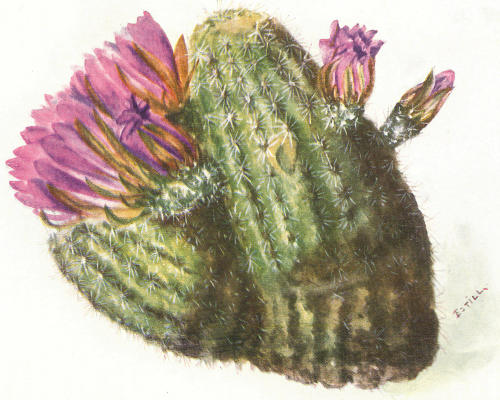
SHORT SPINED STRAWBERRY CACTUS (Echinocereus Bonkeræ)
A new and handsome little strawberry cactus, named in honor of Frances Bonker for her writings depicting the beauty and charm of the desert land.
The spines of cacti are ever an interesting subject for study, and the very name “cactus” is suggestive of thorns. It is generally known that cactus spines develop from their bases and that they are impregnated with resin or a resinlike substance, while the spines of nearly all other plants (as for instance the plum) grow from their tips and are not resinous in character. A young growing cactus spine has a very soft yielding base while the tip is hard and sharp, and the sides retrorsely barbed. Because of their resinous nature the thorns persist on the desert long after the cactus body has disappeared, and often fragments of the thick cuticle remain with them, still firm, sharp and translucent. Such spines about a spot where a noble Sahuaro or Giant Cactus has fallen and gone back to Nature as dust may persist for a long period unchanged, without crumbling or otherwise disintegrating; this is true also of those of the bisnaga or barrel cactus. Thorns grow on the Giant Cacti for a hundred, even two hundred years, unalterable, sharp and hard and dangerous. Some species of cactus have as many as three kinds of spines: centrals, the inner thorns, usually the largest and stoutest; radials, the outer spines; and what are termed “bristles” but are more accurately described as “antennalike” spines. In some groups, as the bisnaga, the spines are cross-ridged or marked transversely, with the tips smooth, straight, or hooked. Many cactus spines are marked with brilliant colorings, and some are transversely banded with bright variegated “zones” of color. When held to the light they [30] are translucent and show beautiful colorings: red, orange, yellow, brown, and purple. Generally cactus spines are glabrous, that is, smooth and without hairs, but the spines of some cacti are densely fine-hairy or distinctly hairy; and this can be seen easily with a pocket lens or the unaided eye: their pubescence commonly produces a grayish layer overlying the true color of the spines beneath. The thorns of Cholla differ from those of other cacti in that they are covered with sheaths which can be removed very easily, and then are not replaced. The significance of these sheaths is not clear, except that they help form a barrier against the intense heat of the sun and the burning desert sands.
We find, too, that the cacti with most pronounced thorny growth live in the hottest parts of the desert, where the thermometer often registers 130° Fahrenheit during the long summer days and sometimes up to 150°! Their dense layer of spines becomes a shield of lacework, protecting the plants by cutting off over twenty per cent of the light, and reducing the terrible heat by raising the humidity within the network of spines, which in turn reduces evaporation from the plant. If it were not for their thorns and sheaths cacti would be scalded by the burning temperatures of even one summer day in the great desert amphitheater of the sun. Being resinous, cactus thorns are very inflammable, and if ignited they all burn to a cinder before the fire ceases, for one cluster of spines will set others aflame and so the fire sweeps over the entire plant, rapidly changing the beautifully colored, symmetrical and translucent spines into ugly charred masses.
The cactus is encased in a thick cuticle which is continuous over the whole surface of the plant, except at the numerous, small, rounded or oval areas of growth called areolas. In the cactus all growth, of leaves, spines, spicules, flowers, and even roots (in the case of cuttings) and branches, takes place from these areolas, which are truly areas or centers of [31] growth; and if all these areolas are cut away on the stem and its tip cut off, the plant ceases to grow and dies. Spines are generally understood to represent branches, since they grow from the tissues of the plant under the epidermis and not from the epidermis. The inordinate multiplication of spines in cacti is not well understood by botanists. Some cacti add thorns to their spine clusters in the areolas each year, and thus in time the cluster may come to have as many as fifty or even a hundred spines on old stems and large branches. Occasionally cactus spines replace themselves in areolas after the former thorns have been destroyed or burned off. The thorns of some cacti may grow as long as six inches and even longer, and as broad as one-fourth inch at their bases. After they complete their growth toward the close of the season and the bases become hard and firm, they do not elongate farther nor make further growth.
The flowers of cacti are generally large and showy and are quite responsive to light in their opening and closing. They have many stamens, from thirty or fifty to as many as three thousand in the Giant Cactus. This development of stamens is rare among flowering plants, and is due to a splitting process that takes place early in the development of the stamens of the embryo flower. The stamens of many cacti are sensitive to touch and when being worked by insects for pollen are constantly moving backward and forward. Cactus flowers differ also from nearly all other flowers in the number of sepals and petals, which is variable and relatively large, and in the fact that their sepals and petals are not distinct in character. Rather there is a gradual transition between the bracts of the ovary, if such are present, and the sepals; and likewise a gradual gradation in form, color, and size between the sepals and petals. There are usually several whorls or circles of petals in the flower; commonly such flowers are spoken of as being double.
Out in the vast desert land in ages long gone by, the stifling sun had burned everything to a cinder. This seeming annihilation was but part of that great plan wherein the desert regions of the earth have been transformed into the greatest flower garden of all creation; where Time has chiseled out the filigree of lacework and pattern for the hills and valleys; where erosion has painted the beautiful pictures on the faces of mountains and hills; where volcanic action has juggled the rocks and mountain sides into fantastic shapes and designs, piling them up and leveling them out again for ages untold, until the Divine decree was accomplished. For God has walked amidst all this seeming turbulence, and with infinite patience has brought forth verdure and flowers the like of which do not exist anywhere else on earth; and to-day when Man ventures into the great arid wastes it would seem that he little anticipates the hidden loveliness to be found there—the wonder of desert creations, flowers and then more flowers, blossoms of rare and seductive beauty, of exotic and sensuous fragrance. Flowers that cannot be painted by brush or in coloring to do justice to the delicate waxlike originals. Flowers that seem like delicate souls wrapped in somber lifeless bodies, trying to gain expression through their beautiful colorings and evanescent perfume in the dry atmosphere of their monotonous existence, out in the great [33] stillness of the arid spaces with only the midnight blue of the heavens to caress them, and the dew of the night zephyrs to kiss them when the torrid sun has gone.
Early in the morning of a fine April day near Needles, California, on the Arizona border, we continue our journey into the desert. Before us stretches a panorama the like of which few among us have ever beheld; a picture majestic, tremendous, suggestive of the grandeur of Nature’s workshop, the vastness of those great sweeps of arid lands, covered with symmetrical, cross-patch, lacework, fantastic growths, of every size and shape and color imaginable. The Cholla are there, Giant Sahuaro rear their great trunks high into the air, and fantastic Joshua Trees lean toward us, their weird grotesque arms with long grasping fingers all pointing in one direction as if to guide the weary traveler on his way. And peering forth from among rocks, in the lee of a Giant Sahuaro or growing in a forest of the grotesque Joshua whose fantastic arms seem to engulf these tiny cacti, we find the Baby Pincushion, our Mammillaria (Coryphantha) or Cactus Mammillaria. He is a funny little ball-like plant, two or three inches in diameter, full of star-shaped spines, with an extra-long one in each star cluster and rather hooked over on the ends. These little aristocrats of the desert often cling together in groups, like a colony of sea urchins, and are very dainty when in bloom in the balmy month of April, when all the desert life is arraying itself in gay spring color and blossom.
Out on the desert mesas and along the bajadas, or mountain slopes, we find so many fantastic objects that it is hard to decide just where to start. Nature has provided many wonderful mysterious growths for her desert land of plants and flowers, and she has been careful to place them where they will be able to thrive and to evolve. Many will be found hidden away under rocks and in deep cañon recesses; others out [34] on the foothills, where it would seem that the sun would burn them up; still others are placed boldly on the mesas where wind and rain and sandstorms play hide and seek around them. Naturally the question of growth, which is next to the most vital problem of all “Where do they get their moisture?” now presents itself. We will begin at the bottom of the ladder, to-day, and will select the Baby Pincushion, the smallest of the cactus family.
Several natural groups or genera go to make up the Pincushion Cacti, and of these the two most important in the great desert of the Southwest are the interesting plants of Coryphantha and Mammillaria. The name “Coryphantha” alludes to the plant’s habit of bearing the flowers at its top; Mammillaria is from mammilla, a nipple, referring to the tubercles or knobs of the plant. They are the smallest of the large and important cactus family (Cactaceæ), the Fantastic Clan, and their stems are single or in clusters and from one to twelve inches in height and diameter, often as broad as long, or broader. Often, too, the upper surface is almost flattened, while the main part of the plant is a carrot-shaped fleshy root, which Nature, the great Builder, has made a reservoir of food and water for this, her baby of the Fantastic Clan, to withstand the drying desert winds that sweep across the mesas and up the cañons, and the months of drought and fiery heat in the desert sun, when no rains come to freshen and beautify the earth and to gladden the hearts of native dwellers on the desert. The stem is studded with tubercles spirally arranged, and each crowned with an areola bearing a cluster of slender but stout spines, often hooked like the tines on a spear; and usually with hairs. This spiral arrangement gives the plant a very attractive appearance. Some [35] species have a thick milky juice in their stems, others a colorless watery sap.
The flowers are day-blooming, both opening and closing with surprising rapidity. Mammillaria blossoms are relatively small, while those of Coryphantha are much larger, often two or three inches across; yellowish, white, pink, rose, red, or purple. There are usually many sepals, petals, and stamens, all beautifully and symmetrically arranged, and the harmony of color in the flowers is often commented upon with delight. While the flowers last at most but a few days, many of the different plants are in bloom for a considerable length of time, and some blossom two or three times a year during the spring and summer. The fruit of Pincushion Cacti are naked and smooth, rarely with a few scales in some species, and when mature red, green, yellowish, or dull purplish, and club-shaped or nearly globose. They are borne at the bases of the tubercles; in Coryphantha, at the bases of young tubercles near the top of the plant, so that they appear terminal; in Mammillaria, at the bases of old tubercles some distance from the top of the plant.
Pincushion Cacti are very popular for window gardens and miniature cactus gardens on account of their smallness, their symmetry and beauty, their fantastic shapes and designs, and their bright-colored dainty flowers. They are considered to be among the most highly developed of the cacti, inasmuch as the greatest reduction of the plant body has taken place, the plants having no leaves nor even trace of leaves. In the evolution of cacti the tendency of the different groups and species is to become leafless, and most cacti either are without leaves or have leaflets that soon disappear.
Baby cacti grow readily from seed, preferably new seed, which is Nature’s method for their reproduction. For this gallon tin cans or large flower pots, with holes in the [36] bottom for drainage, half or two-thirds filled with gravel and sand and the remainder with light sandy soil, or wooden flats twelve by twelve inches or larger and three inches deep, filled to a depth of two and a half inches with fine light sandy soil, answer well. The soil must be free from alkali, but may contain some finely divided organic matter. Level the surface of the soil firmly to prevent water from collecting, sow the seed an eighth of an inch deep, cover carefully, set in a sunny location, and give just enough water to keep the surface moist but not wet. (Out in the open, cover the frame with glass painted white or with white cheesecloth, and raise the glass slightly to insure ventilation.) The seeds should be sown in warm weather, and they should begin growth within one to three or four weeks. After the plants have grown a half-inch or more, transplant to two-inch pots, using paper pots or the usual flower pot, and with the soil somewhat heavier but drainage good. From this time their growth is more rapid and far more interesting, and they should be kept in a sunny location and given frequent light waterings, and, later, less frequent but heavier waterings. Do not attempt to force growth by heavy watering or heavy fertilizing. Once established and having grown to a considerable size, many of the Pincushion Cacti propagate by means of offshoots from the axils of tubercles below the surface of the ground, and thus form clumps of several larger plants with numerous smaller ones about them.
Southern California, Northwestern Arizona, and Southern Nevada
The desert is noted for its many forms of mirage, and because of the rarefied or clear atmosphere due to lack of moisture, things are not always what they seem there. In the [37] distance ahead numberless baby foxes appear to be moving slowly toward us, their heads and bodies hidden from view, their white and reddish tails waving in the hot desert breezes. Now our guide smiles, and as we drive closer and stop he points out several clumps of short cylindric Foxtail Cacti, covered with dense masses of stiff radiating spines, white or whitish with darker tips, and stout central spines white at their bases, then black, shading into reddish brown, the whole resembling a fox’s tail and creating a striking appearance. Light pink are the dainty flowers, and when full open (only in the brightest sunlight) nearly an inch and a half wide and long, the sepals hairy and the beautiful petals narrowly lance-shaped. It is no wonder that our baby cacti are so popular for winter rock gardens with their almost perfect symmetry, and their wonderful uniformity of spines so often beautifully mottled, with exquisite patterns of color and design, brilliant, cross-patch, symmetrical, running through the individual thorns. Care should be taken that such rock gardens are arid gardens, and that the soil is not enriched, with just sufficient water to encourage a natural, compact, symmetrical growth. A heavy flooding occasionally is good. If over-watered, or fertilized too much, or if shaded, these tiny cacti make a rapid artificial growth, usually non-symmetrical in part, called “storied” or “zoned.”
Western and Southern Arizona, and Northern Sonora
Especially is this true of the Cream Cactus, a very odd and interesting Pincushion, with a thick conical fleshy root which transplants easily and grows with little care from the hand of man. This fellow is broader than he is tall, four to ten inches in diameter, only two to six inches high, having a flat head around which radiate his clusters of thirteen or so [38] cream-white short stout spines, and one or two pale red central thorns with purplish brown curved tips and yellow bulbous bases; into this harmony of color come the flowers in bloom, twenty-five or more cream-colored or light yellow petals recurving into a lovely cornucopia effect, very pretty in the dazzling sun of spring and summer on the desert. When injured by small rodents or other enemies, MacDougalii yields a thick creamy fluid which immediately heals the wounds, and is pleasant to taste. Hence his name.
Southern Arizona and Northern Sonora
Hidden under a crevice in the rocks along our dusty track, we spy that little fellow, Coryphantha recurvata, with his dense coat of interlocking thorns, stout but slender and often hooked on the ends, recurving downward and inward toward the plant body with yellow and orange-brown hooks, and almost hiding the plants from our view. Rightly are the Pincushion Cacti named: with their tiny compactness and beautiful symmetry, they resemble nothing so much as an old-fashioned pincushion, with twenty or more sharp stout needles stuck into each brilliantly colored, soft downy cushion. Although among the larger Pincushion Cacti, this little fellow grows only six inches tall, more often four inches, and is three to six inches wide, a broad and rounded dwarf, flattened and depressed on top; often as many as fifty of his companions, their heads occasionally peering over one another, grow in a clump two or three feet across and half a foot high. The blossoms with their tan and brownish sepals and the inner petals lemon-yellow, tone into the brown and orange-brown spines, the sharp needles of our pretty [39] pincushion; the whole producing a happy symphony in brown and orange, so that many feel tempted to purloin this prize and take it back to adorn conservatories at home. And how many are transported and grown in our homes in lovely rock gardens! For recurvata is much in demand for cactus collections and is very easy to transplant. Plant him in sand or among rocks, and let him have plenty of bright sunshine and occasionally a little water, and he will thrive with neither care nor trouble to any one.
Southern Arizona, Southwestern New Mexico, and Northern Sonora
The Devil’s Pincushion is our largest and finest, resembling a pineapple in color and appearance, with his cone-shaped stems three to nine inches tall and three to six inches across, his big tubercles in spirals of thirteen or more rows, coarse yellowish thorns, and large fruit and seeds. The dozen or so spines in a comb-like radial arrangement from a common center, the areola, and graduated, are not alone beautiful and symmetrical, but provide a coat of mail for robustispina protecting him against excessive light or heat and cold. It is from this armament of stout wide-spreading thorns that he is so aptly named “The Devil’s Pincushion.” However, this cactus is endowed not only with a strong set of needles, but with lovely patterns in flower array as well: beautiful, showy blossoms, two or three inches long and wide, of a brilliant yellow against their reddish brown background of thorns, coming forth in one glorious splash of color for but [40] a day, then fading away from eye of man, and no more to be seen until another year has passed.
Southern Arizona
The Slender Pincushion Cactus, typical native of the desert, is commonly so called because of the tiny slender stems an inch or less in diameter and seven or eight inches tall, growing in dense clumps of fifty to two hundred or more plants of all sizes; some growing from seed, some from offshoots of the axils near their bases. Out from the dozen or so rows of tubercles spring the white thorns with their black tips, and the central hooked spine twisted from its bulbous base; then the funnel-shaped pale purple and pink blossoms, giving a decidedly pinkish cast to this whole lovely pincushion. The bright scarlet berries, while they are odd, are pretty and also are edible. This plant was first discovered by Lieutenant Colonel Emory in 1846; it was never seen again until 1902, when it was rediscovered by one of the writers and Mr. Orcutt, along the Gila River in Arizona, from which the Gila monster is named.
Southern Arizona and Northern Sonora
This gayly decorated Pincushion we see peering over solitary rocks and gladdening the hearts of the tired travelers along the desert track, with his pink and white daintiness of blossom and comb of brown and white thorns is another “Cream Cactus”; for it is said many an Indian has owed his life to the thick milk-white fluid which this unique growth yields to those who know the secret. This fat fellow looks like a huge coconut, with a green body, and stout thorns curved both upward and downward. Little bells are the flowers peeping out in a circle at the bases of the old tubercles and laughing up at us gayly as we motor slowly along the hot dusty road.
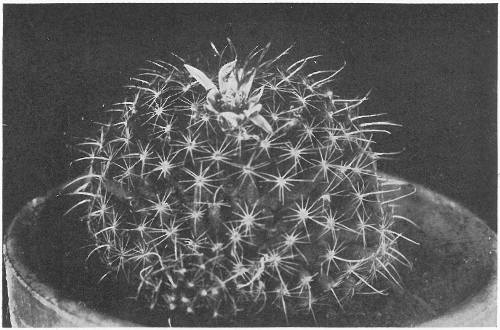
HORNED TOAD CACTUS (Mammillaria Mainæ)
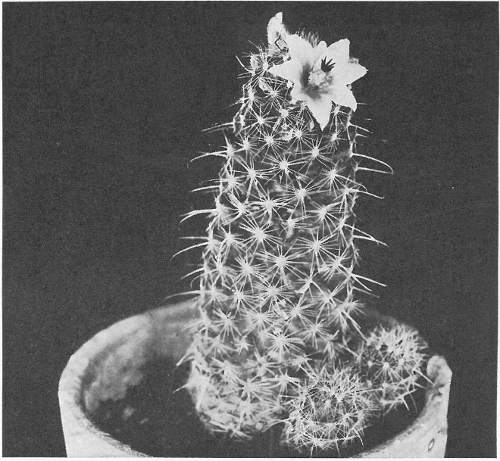
SLENDER PINCUSHION CACTUS (Mammillaria fasciculata)
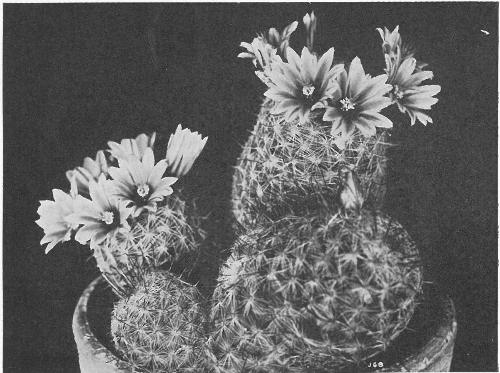
SUNSET CACTUS (Mammillaria Grahamii)
The bright pink and rose tints of the bell-like blossoms tone into the pink glow of the desert sunset in a circle of full open, brilliant flowers, their many brightly glowing segments spreading out like so many iridescent rays of the setting sun.
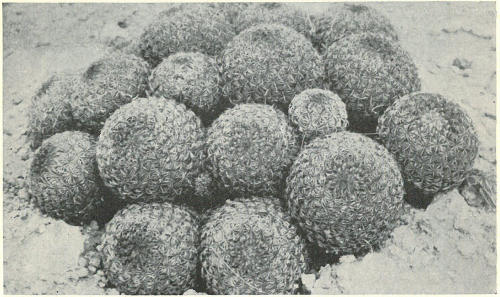
BENT SPINE PINCUSHION (Coryphantha recurvata)
Southern Arizona, Western Texas, Southern California, Southern Utah, and Mexico
We have come more than two hundred miles on this second springtime trek across the ocean of sand and sagebrush and mesquite, with its brilliant flashes of color and fragrance, and still the clumps of dainty pincushions attract us almost against our will. As the sun completes his journey across the western skies, one of the most beautiful of all Nature’s creations claims our attention; this pincushion has earned a title appropriate to its lovely self, the bright pink and rose tints of its bell-like blossoms toning into the pink glow of the desert sunset in a circle of full open brilliant flowers, their many brightly glowing segments spreading out like so many iridescent rays of the setting sun. What name could be more apropos than “Sunset Cactus”? With her evanescent beauty and delicate perfume she is one of the most popular as well as the most abundant of the Mammillaria, ranging from Mexico through Southern California and Arizona to southern Utah. From two to ten inches tall, only a little more than two inches in breadth, she grows more slender than her brothers; her twenty rows of compact tubercles are set in a beautiful gray-green symmetrical spiral, and bear twenty or so slender grayish white radiating spines with dark tips, a half-inch long or less, and two central thorns sticking out stouter than the others, their bodies pale pink and their sharp [42] tips curving upward in a transparent golden fringe of color.
Southern and Southeastern Arizona
The Brown Pincushion is one of the most attractive of the southwestern cacti, and is a rare creation indeed. This tiny cactus is two or three inches tall and about as broad, with a beautiful halo of red-brown thorns covering the whole plant, the hooked central spines and whitish radials slender, sharp, needlelike, with pointed tips. Through these the tiny flowers peep in two rows of thirty-five or forty bright purple or pink petals, recurved into the pretty cornucopia effect that we have seen so often among the clumps of Pincushions on our way across the desert. But beware of pressing the fingers against this dainty pincushion too hard, for if the sharp points of the central spines get hooked into the hand it is only with great difficulty and discomfort that one can get free. When the first offenders are released other spines hook into the flesh, and the plant seems to play with the victim for some time to see just how far it can go in provoking one so lacking in desert knowledge.
Southern Arizona and Northern Sonora
This rare little cactus was found in Arizona for the first time in 1931. Two or three inches high and nearly as broad, he seems to be sitting up in front of us like a horned toad, looking us over, his head flattened out in a slightly grotesque posture, pale green tubercles in thirteen or more spiral rows covering his flabby body, from which spring the dozen or so white and yellow radial thorns and the hooked central spines, also forming into a regular spiral twist. The brown and red striped flowers, an inch or so long, are not the lovely showy beauties of his brother baby cacti. Perhaps his easy life in grassy lands away from hottest sun and arid habitat [43] needs not the compensation of the beauty afforded his less fortunate brothers and sisters. Does Nature make up for the hot aridity of the desert and the barren wastes of sand and more sand, by brilliance of flower and wealth of fantastic design? It would seem so, for nowhere else in the world are to be found the weird, grotesque shapes, the flaming splendor and fragrance of blossom, the kaleidoscopic changes of color and pattern which are created far out on the dry expanses, under the burning sun and during seasons of inconceivable drought.
Southern Arizona
Next we see Oliviæ, the rose-tinted Snowball Pincushion, clad in a white coat of twenty-five or thirty radiating spines crowded together in a comb-like arrangement pressed closely against her body and looking like a snowball lying on the hot sand before us; the delicate rose-colored blossoms edged with a narrow band of white form a beautifully designed pincushion; even the stamens are deep rose, the styles light pink with olive-green stigmas, the fruit bright scarlet, and the seeds black. Is it any wonder that this riot of color, a rare desert form of the Mammillaria Grahamii, is also called the Sunset Cactus?
Southeastern Arizona (Globe)
The Green Flowered Pincushion would make a lovely addition to my lady’s bower in a window rock garden. Not a desert species, it inhabits the higher mountain levels, often in oak woodlands; it is a rare beauty, difficult to find. Two or three inches in length and diameter, its stem and tiny bell-like [44] flowers are both green, the radial spines loosely interlocking over the body of the plant, slender flexible thorns, white or reddish brown with sharp hooked tips. It is a near cousin to Mammillaria Wilcoxii.
Southern Arizona, Western New Mexico, and Northern Sonora
A handsome baby cactus, aggregata occurs usually in clumps, is two to five inches tall and almost as broad, with twenty or forty sharp needlelike thorns a half-inch or so long, tan or light pink, their ends forming twisted tips of white or reddish brown, and intermixed with fifteen or more rows of angled tubercles which bear the spine clusters. Beware of getting a “retrorsely barbed” thorn into the hand! Laceration ensues and much difficulty in extraction, for Nature has given these, her baby cacti, sharp and relentless protectors. A popular fellow for rock gardens is aggregata on account of his symmetrical and globose head, forming a cushion of bright pink or rose-purple blossoms which come forth to greet the world for but a day, then fold their dainty petals and are no more.
Northern Arizona (Kingman, Phoenix)
We have traveled over halfway across the premier cactus state, and are approaching the mighty Grand Cañon of the Colorado, that great fissure in the earth’s surface worn by water erosion throughout the ages. Hereabouts several new colonies of cacti are to be seen. The Arizona Pincushion is a conspicuous but not at all common fellow, easily recognized [45] by his abundant dark-colored spines, in fact almost hidden by this dense growth of stout dangerous-looking reddish brown and black thorns, borne on the tubercles and about half an inch long. Arizonica is the tiniest of all the baby cacti, scarcely more than an inch tall and just as broad; occasionally reaching the height of two or three inches. The flowers, clustering in groups of three and five blossoms, are like a dainty bell, the petals and sepals narrow and lance-shaped, occurring in attractive rose or rose-purple and tan shades.
Northern and Central Arizona, Southern California, Southern Utah, and Southern Nevada
Heading southward from the Grand Cañon we find in the area north of Phoenix, Arizona, a most beautiful distinctive Pincushion which we recognize as native to California. Indeed so abundant is it in the foothills back from Los Angeles, on the road from Big Bear Lake and out on the Mojave Desert, that this round cactus is known as California’s Pincushion. Two to twelve inches tall, about two and one-half inches broad, it has eight rows of tubercles set in a symmetrical spiral over the pale green body, protected by forty to sixty delicate white radial thorns, slender as a needle, covering the entire plant, and one to four reddish brown hooked central spines, surrounded by a dark halo of deep purple blossoms. Bright scarlet is the fruit, but not edible as are the fruits of several related species.
Northern Arizona (Phoenix, Kingman)
Again the sun is fading over the western rim of the foothills, leaving a flood of glory in his wake, and we are glad [46] to sight the famous old Superstition Mountains, which are not far from Phoenix, Arizona. We hope to find one more baby cactus before the twilight passes into the deepening shadows of night, for then the end of our long hot trek is at hand. Milleri is a handsome fellow of mesa and foothill, boasting rose-purple or pink flowers, a showy Pincushion, reflecting the brightness and beauty of Nature around him, especially the flaming rays of a gorgeous desert sunset; indeed, he most clearly resembles our Sunset Cactus. Seldom alone, he and his companions form in symmetrical clumps, two to nine inches high and two or three inches across, encased in weak slender white spines with swollen pink bases, often curved and bent on their dozen or so spiral rows of interlocking tubercles, the firm hooked central spines of a rich brownish red, appearing black at a distance.
Along the highway from Lake Arrowhead in Southern California toward Victorville and Palm Springs, out on the Mojave Desert, southward to San Diego and old Mexico, we may find these odd little baby cacti blossoming forth in early spring into striking clumps of variegated bloom, dotting the landscape far and wide—their only mission in life, to look beautiful. For above the ordinary tourist trails as high as five thousand feet, farther down in sandy and gravelly places on the foothills and bajadas or mesa-like mountain slopes, and along the lower levels around Los Angeles, California Pincushions make their homes. In sunny exposures where Nature’s boon of rain is scarce, preferring common sand and rock, these tiniest of the Fantastic Clan thrive best.
Out on the great Arizona desert the Pincushion Cacti appear in abundance; the vast stretches contain a surprise for the tourist and the wearied student in these bits of desert [47] growth, peering from between rocks and cobblestones or lying in clumps in crevices of the rocks among the foothills. All colors of the rainbow, it would seem, are woven into exquisite patterns by Nature in her baby cacti, their brilliantly painted flowering segments spreading out in spring array like so many gilded rays of the spectrum and creating the mirage of a gayly tinted rainbow, dazzling the eyes of the traveler as he speeds along the highway across the desert. Deep in the recesses of the Grand Cañon of the Colorado, northward into southern Utah and Nevada, and southward again around the Superstition Mountains in Arizona and the Santa Ritas (near Tucson), these dainty cacti, when in bloom, color the landscape far and near, on the mesas and along the bajadas into Southern California, and far south into old Mexico, where they come forth in dozens of flowering varieties. And here we must leave our tiny symbols of the Cactacea clan, for the shadows are beginning to lengthen; the sun has finished his journey across the western heavens and we bid farewell to our baby cacti, beautiful rainbows of the desert, for to-morrow we continue our journey over sandy arid lands, and travel a different way among the weird Fantastic Clan.
These are funny little ball-like plants, an inch to a foot in diameter and height, often broader than they are tall, the upper surface almost flattened, while the main part of the plant is a carrot-shaped fleshy root. The stems are mostly simple, sometimes branched; they grow singly or occasionally in clusters, and are not ribbed but studded with numerous tubercles spirally arranged. These are the smallest of the [48] Cactaceæ, hence called the Baby Cacti, and are full of star-shaped spines with an extra-long one in each cluster, all thorns hooked over on the ends. The spines are slender but stout, mostly of two kinds and generally less than a half-inch long, sharp and needlelike, and usually with hairs. There are no spicules nor leaves. The flowers are small or medium-sized and open in the forenoon, closing in the afternoon of the same day. The fruit is rather small, is smooth and has no tubercles, scales, nor bracts. These dainty cacti often cling together in groups, and the symmetrical arrangement of the flowers and spines, the brilliant harmony of colorings in both, and the spirally arranged tubercles give the plants a most attractive appearance.
Transplant at any season, preferably early in spring, to a southern exposure if possible, in soil similar to that of the native habitat of the plant, irrigate once in two or three weeks sufficiently to keep the soil lightly moist but not wet. Provide some shade for species growing in their native habitats at high altitudes or in partial shade. These plants grow easily from seed sown a quarter- to a half-inch deep in sandy soil mixed with a small amount of ground charcoal and leaf mold in flats or pots, kept slightly moist in part shade. When a half-inch tall they may be transplanted to small pots. They grow indoors and outside.
The Foxtail Cactus grows as a single stem or in clumps. The stems are cylindrical and two or three inches in diameter, with tubercles nearly an inch long and also cylindrical. The [49] whole plant is covered with a dense growth of white radial spines with dark tips, and a group of six to a dozen central spines whitish below, and with the upper half black shading off to a reddish brown. This gives the plant a striking appearance. All of the spines are very stiff. The flowers are straw-colored, about an inch and a half long, and have light pink tips. The petals are lance-shaped and narrow.
Plants may be grown out of doors where the temperatures in winter are not lower than fifteen or twenty degrees below freezing, that is 12° to 17° Fahrenheit. In colder climates than this the plants must be protected in winter or grown in sunny, warm conservatories. They may be grown from seed in pots in sandy soil with partial shade and with enough watering to keep the soil moist but not wet. Transplant larger plants in sandy or gravelly soil in bright sunny exposures and give only occasional irrigation during dry periods.
(Named for Dr. D. T. MacDougal, collector of western plants and Director of the Desert Botanical Laboratory of the Carnegie Institution)
The Cream Cactus grows from solitary stems or heads, and in many instances in clusters four inches high and six inches in diameter. The tops of the plants are flattened with the centers depressed, or often growing level with the ground. The older plants are much taller and broader. The tubercles are placed spirally and are a half-inch long. If injured they yield a white creamy fluid. There are eleven to thirteen radial spines with one to three centrals whose bases are yellow and bulbous. The spine body is a pale red [50] with brown or purple-brown tips. The flowers are a little more than one inch long and one inch wide, and of cream color to light yellow. The fruit is a deep rose-red and the seeds are reddish purple. This plant likes the gravelly clay loam soils best.
These plants can be grown nearly anywhere with temperatures no lower than twenty degrees of frost; but with zero temperatures protection should be given, or the plants grown in rock gardens in sunny conservatories. They grow easily from seed in sandy or gravelly clay loam soil with partial shade and enough irrigation to keep the soil moist. Plants transplant readily to rocky or gravelly clay soils at almost any season, if the thick fleshy roots are not injured in digging. Water moderately once a month, and where convenient set plants among rocks.
(Named recurvata from the spines, which are bent down against the plant)
The Recurved Spine Pincushion grows in clumps about three feet across, sometimes less, and has several stems four to eight inches long, which are globose, that is, longer than broad. These stems bear twenty-seven or so spirally arranged rows on which appear the angled tubercles. These rows or ridges also have the twenty-five radially grouped spines and one light yellow or translucent grayish yellow central spine. This arrangement of the spines forms a dense impenetrable mass or layer over the surface of the plant. [51] The flowers are about the length of a walnut and have lemon-yellow petals and brown sepals. The fruit is quite small and is light yellow-green. This species differs from the others of the group in that the flowers are borne in a circle two or three inches in diameter about the center of the plant.
These plants will endure twenty degrees of frost without injury; where the winters are colder than this the plants should be covered or grown indoors, preferably under glass. They may be grown from seed in sandy soil or sandy loam in pots with partial shade and with enough watering to keep the soil moist. Field plants may be transplanted at almost any season in gravelly or clay loam soils and given enough water to moisten the soil during dry spells.
The Pineapple Cactus is the largest of the Pincushion cacti, with its large tubercles and coarse spines. It grows as high as nine inches, and six inches in diameter, single or several stems in clumps. They form in hemispherical mounds as wide as eighteen inches, with the larger stems suggesting a pineapple. The spines are straight and stout and slightly curved, and grow in groups of eleven to fifteen, one of which, a central, is a little longer than the rest; erect, and of a dull straw color fading to yellow-tan. The bases of the spines are bulbous. The flowers, about two inches long, are yellow or straw-colored or yellow-brown and are very showy, remaining open all day. The fruit is large, about two inches, and narrow or oblong and of a yellow-green with large light brown seeds.
Plants will endure twenty degrees of frost without injury; where the winters are colder than this, protection must be given or the plants must be grown under glass. They grow readily from seed in sandy or clay loam in pots or flats, with just enough water to keep the soil moist, not wet. Large plants transplant with difficulty; the roots should not be injured in digging, and the plants should be set in gravelly clay and watered occasionally during dry spells.
(Named fasciculata from its habit of growing in clumps; Thornberi in honor of one of the authors of this book, who rediscovered it)
The Slender Pincushion Cactus grows in the form of slender stems in dense clusters of fifty to two hundred plants of many sizes, all crowded closely together. The stems are four to seven inches tall, and an inch or so in diameter. They seem to be thickened a bit in the middle and taper off toward the bases and tips. The tubercles are arranged in eight to twelve spiral rows, all less than a quarter of an inch long, and somewhat four-angled in shape. The flowers are an inch or more wide and as long, with the inner petals broad and acute and of a purplish pink color. The fruit is club-shaped, a half-inch or so in length, and of a scarlet hue.
This Pincushion is difficult to transplant. Plant in partial shade or in the protection of shrubs in very sandy soil. Water frequently to keep the soil barely moist. It is best set in clumps as it grew in the field. The plants will endure [53] twenty to twenty-five degrees of frost without injury; with colder winters they must be protected or grown under glass or in conservatories.
(Named for Ivan M. Johnston who collected the plant in Sonora)
The Cream Pincushion Cactus grows from solitary stems having several thick roots, which, however, are not deeply implanted. In outline the stems are hemispherical or depressed globose and have a deep green color. There are many angular tubercles, all spirally arranged, and as many as thirteen white radial spines with brown tips. The central spines are about a half-inch long and red-brown; one is directed upward, and the other downward. The flowers are bell-shaped and are formed in a circle about the center of the head, having white margins and pink or pink-tan centers. Like Mammillaria MacDougalii, the tubercles when injured exude a thick white milky fluid.
Plants may be grown out of doors where temperatures are not lower than twenty or twenty-five degrees below freezing; where the winter weather is colder than this, the plants should be grown in conservatories. They grow from seed in clay loam in pots with enough water to keep the soil moist, preferably with part shade. Large plants transplant quite readily if the roots are not injured. They grow well in [54] gravelly soil or among rocks and should be watered once a month.
(Named in honor of Colonel J. D. Graham of the United States Corps of Topographical Engineers)
The Sunset Cactus, or Common Pincushion Cactus, is one of the most popular of the Pincushion Cactus species, perhaps because of its wide range from Texas to California and into old Mexico. It is quite symmetrical and small. It grows as a stem from two to ten inches tall and as much as two and one-half or three inches in diameter, in single stems or several together in a clump. They are cylindrical or globose and bear the tubercles closely set in a spiral arrangement of twenty to twenty-three rows; these tubercles are about a quarter-inch long and gray-green. There are about seventeen grouped radial spines a half-inch or so long, of a dull white with darker tips, and one or two central spines which are longer and stouter, whitish, with purple-brown or red-brown tips which are curved sharply upward. The flowers are formed in a circle near the tops of the stems and are about an inch long. The petals are rose-pink with pink or white margins, while the sepals are purple-brown with pink or white ciliate edges. The fruit is club-shaped and scarlet, about an inch long.
These plants are not injured by temperatures of twenty or twenty-five degrees below freezing, and where the winter temperatures drop as low as zero they grow easily in warm, sunny conservatories. Plants grow readily from seed in pots or flats in moist clay loam, with part shade, and transplant easily at any season, growing well in sandy or gravelly [55] soils with watering once or twice a month during the dry periods.
(Named in honor of General Timothy A. Wilcox of the United States Army, who collected many plants in Arizona and other western states)
The Brown Pincushion Cactus grows with flabby stems, two or three inches tall with as great a diameter. It is hemispherical or subglobose, and somewhat depressed at the top. The tubercles are loosely set and spirally placed, narrow and conical. There are eighteen to twenty sharp, slender, needlelike, wide-spreading radial spines which interlock with those of the other spine clusters; they are white with the tips a bright reddish brown. There are two to six slender but much stronger central spines which are spreading and erect with the hooked ends turned in several directions. These are a translucent red-brown throughout, which gives to the plant a reddish brown halo over the mass of the white radials. The light pink flowers are a little more than an inch long, and when full open are wider than they are long. There are from thirty-five to forty petals, narrow lance-shaped and somewhat recurved. The fifteen or twenty white sepals form in fringes.
These plants will grow outside in temperatures nearly as low as zero. With colder winter weather they should be covered or grown in greenhouses or conservatories. Plants grow easily from seed in fine sandy soil in pots or flats, with part shade and with occasional watering to keep the soil [56] moist. They transplant readily in gravelly clay with watering twice a month during dry spells, and should be set in partial shade.
(Named for Mrs. F. M. Main, who first collected the plant near Nogales, Mexico)
The Horned Toad Cactus grows from single stems, or several in loose clumps and is depressed globose or hemispherical, growing as short as two or three inches, with a diameter of three or four inches. The tubercles are of a pale green, arranged in thirteen spiral rows with compressed bases tapering above and upturned. The texture of the plant is flabby and loose. There are not many spines in this species, twelve wide-spreading yellowish radial spines and one central which is much stronger than the radials and somewhat twisted and curved. The flowers are quite slender and about one inch long, both sepals and petals pointed. The former have a brownish center while the latter have reddish centers with white-fringed margins. The style is much longer than the stamens. This plant is not conspicuous because it grows quite close to the ground and is not easily seen with its light-colored spines.
Plants grow outside in twenty degrees of frost, but with colder weather than this they must be protected or grown in warm conservatories. They grow easily from seed in the usual way in pots with part shade and with occasional watering to keep the soil moist. They may be transplanted at any season in sandy or gravelly clay, and given enough [57] water to moisten the soil well once in two or three weeks during dry months.
(Named Oliviæ in honor of Mrs. C. R. Orcutt, who shared her husband’s interest in these plants)
The Snowball Pincushion is covered with a dense coat of white spines, looking much like a snowball lying on the ground. It grows on solitary stems or in some instances in clumps, is globose, and has twenty-five to thirty-five thorns. The plant is covered with radially placed spines about half an inch long, translucent white and somewhat twisted. There are four centrals in the spine groups. The flowers of this plant resemble those of the Sunset Cactus, and are pink and pink-rose with the margins fringed in white. They are very showy and about an inch long. The pink flowers contrast well with the glistening white spines, making this cactus one of the handsomest of its kind, growing on the deserts and foothills of southern Arizona.
The same care and treatment is suggested as for the Sunset Cactus.
(Named from its green flowers, which are very uncommon among cacti)
The Green Flowered Pincushion Cactus grows from single stems or in small clusters and is cylindrical or globose. The [58] stems are two to four inches long and as much as three inches in diameter. This plant, also, has a flabby texture, with the tubercles arranged in eight to twelve spiral rows, which are disposed rather loosely. The radial spines, slender and needlelike and wide-spreading, loosely interlocking with those of the other spine clusters, are white with brown tips. The central spines are hooked and slender, longer and stouter than the radials, about two inches in length, brown and brown-red. The flowers are not at all showy and are less than an inch long and wide; the sepals and petals are green. The fruit is ovoid and less than an inch long, with a dull purplish or green-purple color.
Plants will endure outdoor temperatures of twenty or twenty-five degrees below freezing. In colder climates they will thrive in warm, sunny conservatories. Plants grow readily from seed in sandy loam with occasional watering and part shade. Transplant older plants in gravelly clay with enough water to keep the soil moist. Watering once in two weeks during droughty spells is sufficient. This cactus is very attractive as a potted plant, and outside should be given some shade.
(Named from the plant’s habit of growing in clumps)
This plant is a fine and showy Pincushion cactus growing from single stems or in clumps, six to fifteen inches in diameter across the top of the clump, the stems globose or cylindrical, two to four inches in diameter. The tubercles are arranged spirally in fifteen to seventeen rows, with twenty [59] to forty radially placed spines in two series like the teeth of a comb. They are less than a half-inch long. There are six central spines in the more mature plants, and all the spines are of a translucent white, toning into the reddish brown tips. The flowers are very showy and are formed around the center of the plant, two or three inches in diameter and bright pink to rose-purple. They remain open all day, and are quite abundant in southeastern Arizona and New Mexico on prairie lands and bajadas.
Plants grow outside and are not injured by temperatures as low as zero. They grow easily from seed in sandy or clay loam in flats or pots with some shade; transplant at any season in almost any soil; give enough water to keep the soil moist during dry spells, about five gallons of water at a time.
This cactus grows in dense clumps six inches to two feet or more across, with the heads close together. They are shortened, globose or cylindrical, one to two inches in diameter, and as high. The plants are almost hidden by the dense growth of reddish brown or almost black spines. There are from fifteen to thirty radially placed spines and three to seven stouter central thorns, all of which have yellowish bulbous bases, with red-brown or almost black tips. The flowers are about an inch and a half long and as wide. The petals and sepals are narrow and lance-shaped, and from tan-purple to rose or rose-purple. The fruit is oval and light green. This cactus grows in the prairie lands and on foothill slopes, and needs a little modern irrigation.
This Pincushion is not injured by temperatures of twenty to twenty-five degrees below zero and hence is well suited for growing in cactus gardens throughout the country. It thrives also in the warm Southwest. Young plants grow readily from seed in pots or flats, in sandy or loamy soil, with enough irrigation to keep the soil moist; part shade is desirable. Large plants prefer sandy or loamy soil, especially limestone soil with irrigation about once a month, and some shade.
(Named tetrancistera in allusion to the four central spines)
The California Pincushion grows from single stems a foot high and two and one-half inches in diameter, or several in a cluster. Sometimes the stems are branched and cylindrical with a loose flabby texture. The root is narrow, conical, and fleshy. The tubercles are usually less than a half-inch long and loosely set in eight spiral rows. There are from forty to sixty-five radial spines placed in two whorls, slender and white with red-brown tips; also one to four central spines which are strongly hooked, dark reddish brown or blackish. The flowers are usually about two inches long and are purplish. The sepals and petals are ciliate and covered with many fine hairs.
This pincushion is not injured by temperatures fifteen or twenty degrees below freezing and hence grows indoors or out; it thrives in hot, sunny conservatories or greenhouses. The plants grow easily from seed sown in sandy soil with [61] partial shade, the soil moist but not wet. Plants may be transplanted at any season in sandy, stony, or gravelly soil, and watered once in two or three weeks during dry spells.
(Named for Dr. Gerrett S. Miller, Jr., who first collected it near Phoenix, Arizona)
The Black Spined Pincushion, another of the Mammillaria genus of Cactaceæ, grows from single stems or several stems in clumps which are sometimes branched, and from two to nine inches high, two to three inches in diameter. The stems are globose or cylindrical with the tubercles crowded close together on their lower parts. These tubercles are about one-third of an inch long, and are arranged symmetrically in eleven to fourteen rows. There are from seventeen to twenty radially placed spines, widely spreading and about a half-inch long, with a white body and reddish brown tips; also one to three central spines with upturned hooks, brownish red appearing black at a distance. The flowers are purple fading out to a pink, and bell-shaped. This handsome desert species strongly resembles the beautiful Sunset Cactus, but has much stouter and darker central spines.
This plant should be treated similarly to the Sunset Cactus. Young plants grow readily from seed in moist sandy or loamy soil in pots or flats in part shade. Older plants may be transplanted at almost any season in rocky or gravelly soils and watered once or twice a month during dry seasons. They are not injured by temperatures twenty or twenty-five degrees below freezing, but with greater cold than this must be protected or grown in warm sunny conservatories.
The lover of plants and flowers which thrive on the desert wastes has often but little conception of the mystic beauty which lingers there, wrapped up in the delicate waxlike coverings of these wondrous blossoms. Exotic and strikingly beautiful, some of them are. It would seem that Nature, the Great Gardener, has caused the mountains to grow their huge trees bedecked in evergreen, snow-crowned and haloed in gorgeous golden sunsets with tints of spectral beauty; the humid plains to grow their grasses, somber and uninviting, the providers of mankind, and their trees, low and squatty, with shade for the tired herd and the dusty traveler, and also their velvet grassy slopes lovely to look upon.
But what of the desert! Well, we do not intend to paint you a picture of desolation, where no living thing can grow. Out of the débris of worlds in the making, so to speak, there was left the great Amphitheater of the Sun where the scorching rays beat down. In this hot caldron of alkali and sand and rock Nature went to work, and soon there appeared tiny spiny shoots, leafy but devoid of color. All were hungry and thirsty, and soon rain came, and then the transformation! Water appeared under the surface, and slowly rose saturating the tiny roots. The hot winds of the day turned to cooling zephyrs of the night which gently kissed each plant and flower until the coming of the sun. With each kiss of the dew-laden night air came the delicate perfume and the wonderful color scheme which make all the cacti so attractive to the eye and so stirring to the senses. From crannies and [63] nooks, crevices and rock-cracks, along the foothills and on the slopes, began to appear the haciendas of the flowers; in time they thrived and multiplied. To-day on the great deserts of the Southwest along the Arizona-California line and eastward, there are vast stretches of cacti of every weave and pattern imaginable, as symmetrical in design as though each were first wrought on the Infinite Draughting Board and then carefully and wisely planted by the Great Gardener to live forever.
Our third trek starts from one of the beautiful California or Arizona sites that dot the Colorado River bounding these two states, leading into the gullies, draws, or cañons that are so numerous there, in search of a peculiar and striking growth commonly known as the Hedgehog Cactus. Since the species are very thorny, the comparison to the little animal so full of bristles is an apt one. The scientific name, Echinocereus, taken from the Latin echinus, hedgehog, and cereus, torch, or the Hedgehog-Torch.
The Hedgehog cacti are of the easiest culture in out-of-door gardens, blossoming and fruiting profusely, but in greenhouse cultivation they rarely flower; they thrive in any ordinary clay loam with some gravel or coarse sand and with good drainage, and the desert species will even tolerate some alkali. The fruit looks like a mass of enormous bright red strawberries, and when cooled in the refrigerator, sliced and served with cream and sugar is delicious, and sought after as a great delicacy by the Indians and Mexicans. This marked resemblance has earned for Echinocereus Cacti the common name, also, of “Strawberry Cactus.” When the berries ripen, their spine clusters fall away or may be removed with the least effort. The writers have tasted this [64] delicious fruit served cold and also as a sauce and made into jam.
Strawberry Cacti are among the most popular plants for southwestern cactus gardens and rock gardens because of their fine showy flowers, and their profuse blooming and fruiting. A single plant in the University of Arizona Cactus Garden during the present year had fifty full-blown flowers at one time and continued in blossom for fully two weeks. In culture the plants may be watered regularly once a month in the absence of rain during the growing season; they require little other care. They may be transplanted at any season provided the roots are not seriously injured, and when transplanted early in spring they blossom during that same season. Like other desert cacti, the Hedgehog or Strawberry Cactus grows best in sunny locations. The plants grow with single stems or in clumps, and from three inches to a foot and a half tall; others are solitary, and some in large flat masses or hemispherical mounds. The flowers are crimson and scarlet and pink and deep purple, and grow in heavy masses; some are funnel-shaped and bell-shaped.
As we start on our journey early in May, we travel down a long, broad, well paved highway, straight toward the rising sun. It is still quite cool, but the day will be blazing-hot before long. In the distance a blue haze hovers over Superstition Range for whose almost roadless cañons and draws we are bound. As we proceed along the highway, the cacti get thicker and thicker, and as far as the eye can see are many kinds of Cholla, Pincushion, and Barrel cacti. Here and there is a stranger to us. We are at last in a veritable museum of desert cacti and their flowers. It might be called the “Parade of the Cactus Flowers,” for they are all around and about us. We are hunting for the little Hedgehog, and indeed we find him in plenty. There are about sixty different varieties of this particular group of the Cactus Family—all very beautiful and interesting, and some of them hide away [65] so carefully and select such forbidden haunts that it takes a long time to find them.
Southeastern California, Southern Utah, Southern Nevada, and Northwestern Arizona
The California Hedgehog Cactus, or the Mojave Hedgehog, we espy first, and how could one miss seeing the scarlet bloom suffused with nopal red of this strange and beautiful Strawberry Cactus? The flaming blossoms, two or three inches long and an inch or so across, with short broad thick petals, borne singly though many grow on a single stem, remain open for several days at a time, and cause the California Hedgehog to become one of the most brilliant of the Strawberry group. The massive mounds of white-spined stems, two to six or seven inches long, often several hundred in a clump, covered with flashes of crimson flowers form a bright-colored zone which in full blossom is a splendid sight, and at a distance suggests a fire burning, with nothing to burn and sans smoke. This species is called the Desert-Afire, or Burning Cactus, or the Mojave Hedgehog as it was discovered on the Mojave Desert, and the name Echinocereus or Torch Cactus was first given to it. A close cousin is the Crimson Flowered Hedgehog Cactus of northern Arizona and New Mexico and Utah.
Southeastern California, Western Arizona, and Northern Mexico
Here in Southern California thrives the Golden Spined Albino, a foot or so in height; the two-inch stems are furrowed [66] with a dozen or so ridges, on the sides of which appear interlocking scallops, of a yellow or medium deep greenish cast. It has golden or light yellow spines like the pale yellow or cream-colored hair of the albino, hence the common name is quite apropos. It is to the circle of eight to thirteen radial spines with their lovely golden hue that the specific title chrysocentrus refers. The Golden Spined Strawberry Cactus with its pink and lavender-pink flowers is a rare and beautiful sight on the desert here before us, set in the dull tan or brown background of sand and rocks, and with scarcely a green leaf or other color now in sight. The inch-long fruit is densely spiny, covered with long, slender golden thorns, edible and sweet; it ripens in August, a month or so later than the fruit of the Echinocereus Engelmannii, its nearest relative.
Western Arizona, Northern Mexico, Southern Utah, Southern Nevada, and Southern California
Here is the Echinocereus Engelmannii, or Engelmann’s Hedgehog Cactus. This fine Strawberry Cactus may be found clinging to the foothills and low mountains in arid, sandy or gravelly desert land, growing in clumps of a few to twenty or more stems, six inches to a foot or more high and two or three inches through, rather cylindrical. This fine species is very appropriately named in honor of Dr. George Engelmann of St. Louis, one of the greatest authorities on cacti. Deep purple-pink flowers appear in early spring, seeming at times to be clustered because of the masses of brilliantly tinged blossoms three to four inches long; though in reality they grow singly on the stems, and bloom for several days, opening in the forenoon and closing toward evening. The thirteen to seventeen stiff awl-shaped radial spines, one-fourth inch to one inch long, and the three or four stout firm central thorns remind one of stiff tousled medium brown hair partly turned gray, the colors being grayish, tan, and brownish, all mixed together. The fruit, enormous “strawberries,” is covered by many spine clusters which at maturity are easily rubbed off, leaving it quite smooth, of a deep purple-red, with many small black seeds set in a pinkish mass of sweet tender pulp. The Pima and Papago Indians are very fond of this luscious cactus strawberry when fully ripe and served with cream and sugar or cooked into the most delicious conserves and jam; they gather it in considerable quantities and occasionally one can buy the fruit or preserves in their markets, in Arizona, Southern California or old Mexico. And so Dr. Engelmann’s Strawberry Cactus has earned the name, also, of the Indian Strawberry Cactus, or “Desert Strawberry.”
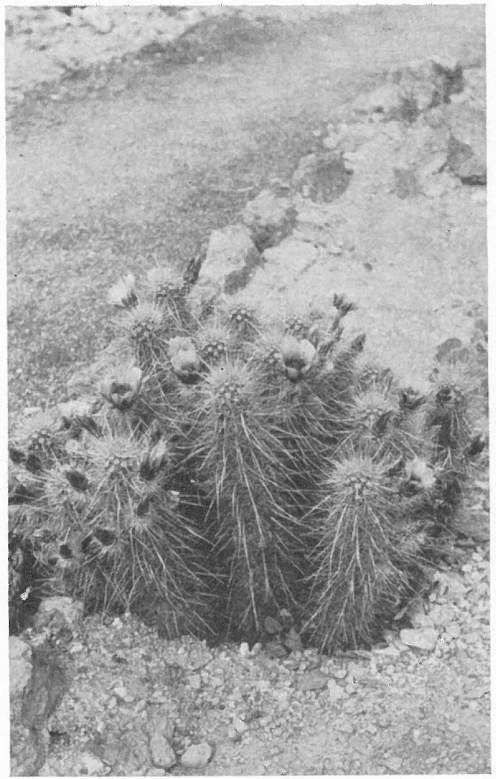
GOLDEN SPINED STRAWBERRY CACTUS (Echinocereus chrysocentrus)
Lovely strawberries on the end of an armored stick, delicate colorings, enticing, inviting.
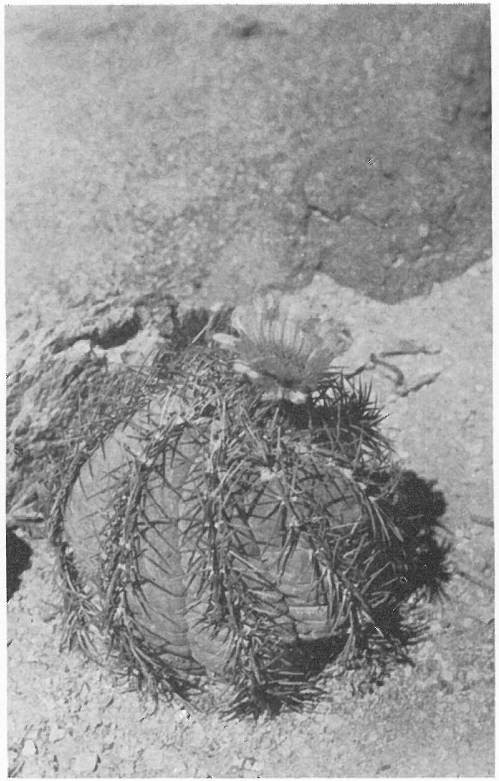
TURK’S HEAD (Echinocactus horizonthalonius)
Quite like a Turk’s head when in flower with the pinkish purple tassel at the tip.
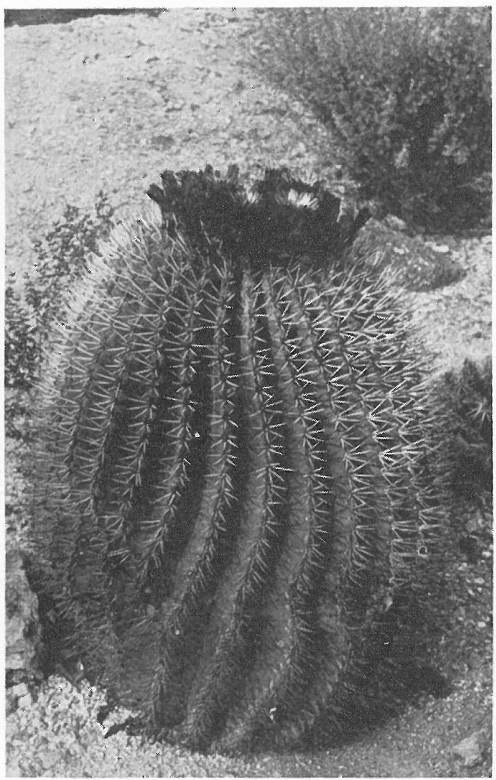
TRAVELER’S FRIEND; CANDY CACTUS; TRAVELER’S COMPASS (Echinocactus Covillei)
If one gingerly cuts off the top of the plant, crushing the fleshy part, cool refreshing water is revealed.
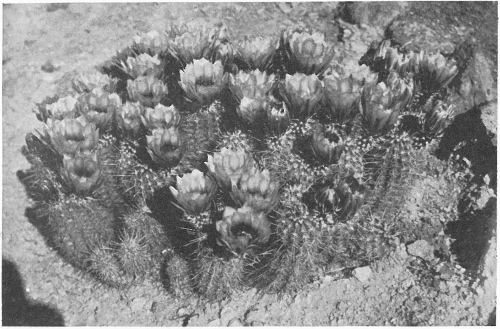
DESERT STRAWBERRIES; FENDLER’S HEDGEHOG CACTUS (Echinocereus Fendleri)
A large plant bears one or two quarts of delicious “cactus strawberry” fruit.
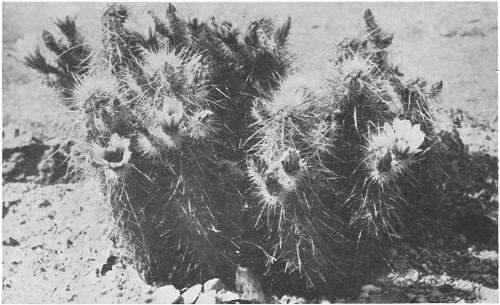
INDIAN STRAWBERRY CACTUS; ENGELMANN’S HEDGEHOG CACTUS (Echinocereus Engelmannii)
The Pima and Papago Indians are very fond of this luscious cactus strawberry when sliced and served cold with cream and sugar or cooked into the most delicious conserves and jam.
Northern Mexico, Southern Arizona, and Texas
It is in Northern Mexico that we glimpse the Spiny Hedgehog Cactus, or, as the scientist names him for his many spines, Echinocereus polyacanthus, a fierce thorny little fellow. He has fifteen sharp stout spines, somewhat flask-shaped at the bases, and spreading, at first pale yellow, then becoming pinkish gray or grayish purple with the tips mostly darker, deep yellow to blackish shades. His flame-red blossoms, sometimes tinged with orange, are called single though they seem to be clustered when abundant—large striking flowers, several blooming at one time in early and late spring, and remaining open for days, not closing up at night. Though not specially abundant, polyacanthus is one of the [68] commoner varieties of the low mountains and foothills on the desert.
Northern Mexico
A lustrous mass of flame-colored blossoms attracts our attention next, as we speed along the highway intent on making camp for the night across the United States line from Mexico. It is the Salmon Flowered Hedgehog Cactus, whose large, wide-spreading petals (two or three inches across the flower), are of a brilliant salmon hue, showy and attractive, and remain open for several days at a time in the spring, not even closing at night. The blossoms are borne near the tips of the stems, and as many as ten or twelve are in bloom at a time. Though not native to the United States, the Salmon Flowered Hedgehog is occasionally found in cactus gardens in Arizona and California, and is well known to cactus connoisseurs and gardens in Europe. The species was named Leeanus in honor of James Lee of England, who presented the type specimen to the Royal Botanic Gardens at Kew about 1842.
Southeastern Arizona, Texas, New Mexico, and Northern Mexico
We have crossed the boundary line into the United States at Nogales, Arizona, and now in the early morning sunlight are approaching the low Gila Range in southeastern Arizona. We have come to study a cactus which closely resembles that fierce little fellow, the Spiny Hedgehog Cactus, from which it differs in having very short and sparse hairs on the fruit and [69] calyx tube. It has been described only recently, and thrives in western Texas, southern New Mexico, old Mexico, and southern Arizona, along the bajadas in rocky or gravelly soil, sometimes in sandy soil on the dry mesas and low mountain sides. Growing in clumps of fifteen to forty stems, four to ten inches tall, pale green or blue-green, it has fourteen or more firm needlelike radial and central spines, pinkish and brownish gray, and bright scarlet flowers bearing six hundred or more stamens, purple anthers, and dull scarlet filaments. Unlike most cactus flowers these blossoms remain open for several days and nights in succession, in April, occasionally blooming into May. The berries ripen in June, dropping their spine clusters then. The fruit of Rose’s Hedgehog Cactus is about an inch long, greenish purple when ripe, edible, with a pleasant, tart, gooseberrylike taste.
Southeastern Arizona, Mexico, Western Texas, Utah, and New Mexico
Like many of his kind Fendler’s Hedgehog Cactus blooms during the day and folds up his petals at night. There are eight to thirteen stout radial spines, spreading and occasionally appearing comb-like in arrangement, white fading to gray, and usually tipped with brown; also a very stout central thorn or two, sometimes an inch and a half long, dark-colored and curving upward. He has deep pink, rose and rose-purple bloom nearly four inches long and about as wide, appearing in April and May. This is one of the finest and most abundant of our Strawberry or Hedgehog Cacti; occasionally plants will have as many as fifty blossoms open at a time. Amidst desert surroundings with the gray or brown of the great arid spaces for a background they make a [70] glorious sight, and one wonders how it is possible for so fine a flower to grow on the sandy gravelly foothills without any attention or care from the hand of man. Here again it is Nature, the Great Gardener, with her marvelous science and daring ingenuity, who enables her plants to receive life and sustenance through the miraculous reservoirs of root and stem, even amid the burning sun and drying winds of the great desert of the Southwest.
The fruit, about an inch and a half long, is armed with numerous clusters of short brown-tipped spines. When ripe it is light yellow, pink, or purple-red, and the thorns, then, are easily rubbed off leaving the surface entirely smooth. The mature fruit served with cream and sugar is delicious and suggests strawberries; it is used as an article of food and for barter among the Indians and Mexicans. A large plant bears one or two quarts of the luscious fruit, in late May or early June. Hence this cactus, too, is called the Indian or Desert Strawberry Cactus. The species is named in honor of August Fendler, who collected extensively in New Mexico and Arizona in the early days.
Southeastern Arizona and Sonora
Here is a real beauty, Echinocereus rigidissimus, the lovely Rainbow Cactus, so called from the many colors of her spines arranged in bands a half-inch to an inch wide, one following another in quick succession extending around the plant. This beautiful desert growth is a great favorite in cactus collections, but unfortunately, when removed from her natural habitat, she pines away and is short-lived. The scientific name rigidissimus refers to her spines, which are noticeably stiff.
Among rocks and stones on hillsides in exposed and sunny [71] locations, we find the beauteous Rainbow, her bright rose-purple flowers with their yellowish eyes, large and showy and funnel-shaped. Solitary they are, and grow only a few on a plant; and the rose-pink and purple petals and stamens, with their orange-red anthers forming a circle about the rose-purple style and olive-green stigmas, are a sight truly admired by every one fortunate enough to see it in full bloom. The Mexicans have nicknamed her Cabecita del Viejo because she clings to the foothills and rocky mountain slopes. Four to fifteen inches tall, at a little distance she appears banded with white or cream-colored, yellow, rose-purple, pink, or maroon-purple bands, while the two dozen or so ridges appearing vertically around the stems about a half-inch apart are green and yellow-green in hue. The beautifully mottled thorns, a half-inch or so long, are pressed closely against the plant, arranged mostly in two comb-like groups and forming a continuous dense spiny layer over the entire growth. The last spines of each season are rose-purple or maroon, the earlier ones pink, yellowish, or whitish; and thus are formed the zones of color extending around the plant, the brighter or deeper hues of the spines appearing during periods of slow growth, the yellow or whitish coloring during the time of faster growth in the spring. The inner part of the stems of rigidissimus, along with the sweet and pulpy ripe fruit, is relished and eaten by Indians and Mexicans, who consider it a rare delicacy.
Southeastern Arizona
We are nearing the beautiful Pinal Mountains in southeastern Arizona, nearing also the end of our journey over the broad expanse of the Arizona-California desert. After [72] all it is one desert; California, Arizona—what are mere geographical lines or names in the desert land of plants and flowers, in that vast natural amphitheater of the great Southwest? Here in the long low rays of the afternoon sun we see at a distance the purple haze gathering over the mountain peaks, and we know that our day’s work is nearing completion with the coming of the beautiful sunset hour. And here it is, four thousand feet up in the rocky foothills, that we espy the rare little beauty Echinocereus Bonkeræ, named for Frances Bonker, one of the authors of this book. It is a new Strawberry Cactus, growing in the foothills and low mountain ranges of southeastern Arizona, and was discovered only last year in the Pinal Mountains and also near Oracle, Arizona. It differs from all other species of its kind in that all the spines are very short, and its fruit is sweet and more nearly the size of a strawberry than any of the others; also the spines do not suggest the Hedgehog Cactus, so that the common name of Short Spined Strawberry Cactus is given to Bonkeræ, as more nearly resembling a strawberry in its fruit than any other of the Strawberry Cactus clan. The juicy, luscious berries, less than an inch long, are delicious as jam or served cold with cream; they are always the first to appear in the spring.
Often but two inches tall, sometimes reaching six or eight inches, this little Strawberry Cactus grows in clumps of two or three to ten stems which are densely ridged and tubercled. The flowers, nearly three inches long and about the same in width, are a deep rose-purple, and appear in April, the first of the purple-flowered species to bloom. It is easily recognized by its many ridges and very short spines, all less than a half-inch long, which are whitish or yellowish when young and reddish brown when mature, and by its bright purple blossoms, borne well up on the stems, which open in the forenoon and close in late afternoon, lasting for several days. Under cultivation the larger plants grow as much as three inches in a season.
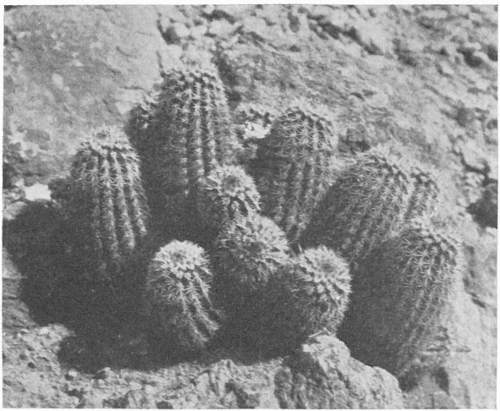
SHORT SPINED STRAWBERRY CACTUS (Echinocereus Bonkeræ)
A new Cactus species named in honor of Frances Bonker.
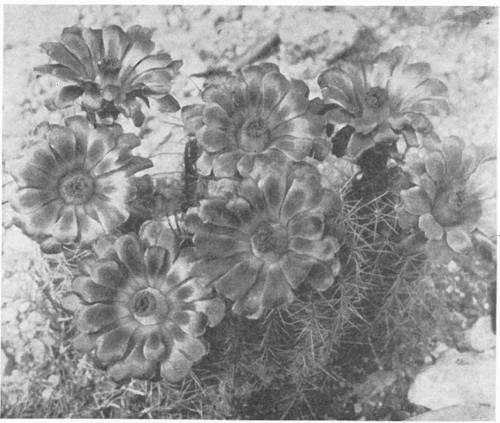
SALMON FLOWERED HEDGEHOG CACTUS (Echinocereus Leeanus)
A lustrous mass of flame colored blossoms. The species was named in honor of James Lee of England who presented the type specimen to the Royal Botanic Gardens at Kew about 1842, and is well known to cactus connoisseurs and in gardens in Europe.
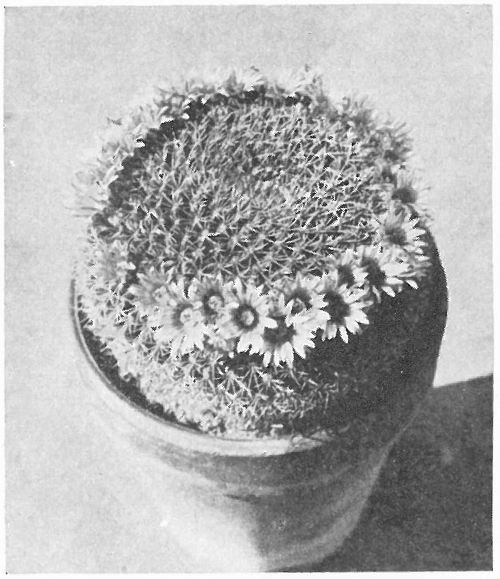
CREAM PINCUSHION CACTUS (Mammillaria Johnstonii)
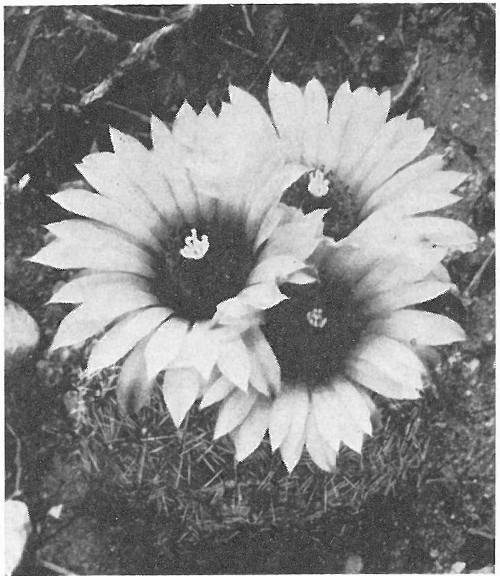
SHOWY PINCUSHION CACTUS (Coryphantha aggregata)
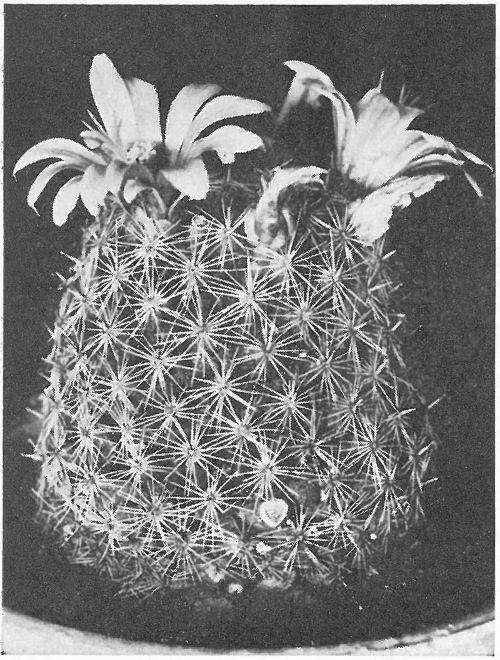
SNOWBALL PINCUSHION (Mammillaria Oliviæ)
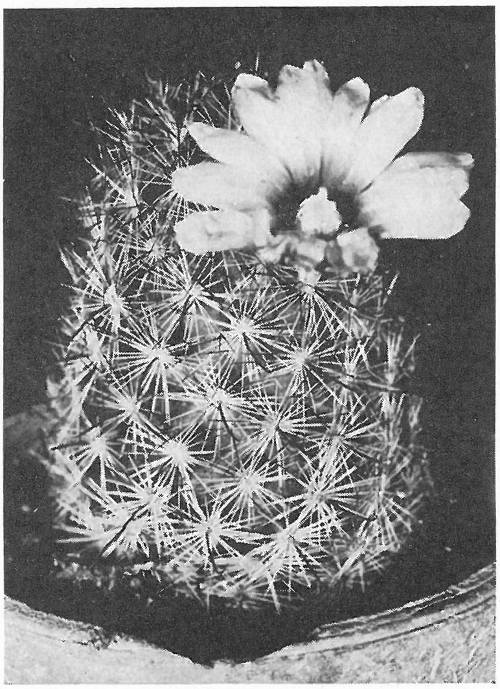
CALIFORNIA PINCUSHION (Mammillaria tetrancistera)
Our journey is almost ended, and our notebooks are filled with much interesting matter about cacti heretofore unknown; we have found and studied many interesting specimens of the cactus family perhaps never before seen by the majority of travelers. We know now that it is necessary to see them from both far and near to appreciate the loveliness of these weird desert growths; and it seems very strange to us that so much glorious color and beauty has to be hidden away out here underneath the midnight blue of the sky, for only a privileged few to enjoy.
Northern Arizona, New Mexico, Utah, and Colorado
Yet one more of the lovely Strawberry group must be added to our list, growing far up in the towering mountains of northern Arizona and hence not included in this present trek. The Crimson Flowered Hedgehog Cactus is this flaming cactus flower, which grows generally at altitudes of five to seven thousand feet, its scarlet blossoms flashing here and there over the mountain slopes, or dotting the oak, juniper, and pine formations in dense masses of brilliant hue, compact clumps one to six feet across of twenty to three hundred stems all closely set together; usually growing in rounded mounds which exclude all other growth, and sometimes comprising an important part of the pine and juniper plant coverings. The stems are five to seven inches high, green and yellow-green, forming a pleasing contrast to the crimson blossoms. The translucent whitish spines, about a dozen in number, are flask-shaped at their bases and spreading, while the flowers are slightly fragrant, a rare characteristic [74] among the Echinocereus group. The fruit is spiny, and grows from densely felted masses which remain as scars on the stems for years. This Hedgehog Cactus may be easily distinguished from Echinocereus Rosei by its white or yellowish white spines.
And now the desert flower parade of color and beauty has passed in review. One is not sorry to have come, for even when the days are hot and dusty, the cooling desert winds appear with the approach of night. We recall having read a great deal about the magic and lure of the desert and its wondrous plants and flowers, and we realize now that one must come and see them to appreciate the beauty that lives and thrives away out there underneath the stars, forever guarded by that All-seeing Providence which placed them there so carefully and wisely that they might tell us something of His Plan of things entire, wherein the smallest blade of grass receives from Nature as does the wisest seer; for the Infinite Mind of Nature is no respecter of persons or things, and treats plants and animals and humans without favor or prejudice, portraying therein God’s eternal care and watchfulness over all.
Plants grow with single stems or more often in clumps from three inches to a foot and a half or so tall, sometimes in large flat masses or in hemispherical mounds. The stems are simple, rarely branched, tubercled, and covered with a series of ridges running lengthwise from top to bottom; these ridges are almost hidden by a dense network of spines spreading out over the entire plant, and causing such a marked resemblance to the hedgehog that the group is [75] named the “Hedgehog Cacti.” The Hedgehog Cacti can be distinguished from young Sahuaro by the fact that the thorns of Echinocerei form a lacework extending across the ridges, almost hiding them, while in the Sahuaro the network of spines is along the tops of the ridges and does not extend across them. The thorns are mostly of two kinds, centrals and radials, growing from less than half an inch to three inches long. There are no spicules. The flowers are funnel-shaped and bell-shaped, crimson and scarlet, also occurring in pink and deep purples, large and showy, and growing in heavy masses. They open in the forenoon and close in the afternoon, lasting several days, or remain open for three or four days or longer without closing. The fruit looks like a mass of enormous bright red strawberries and is delicious served with cream and sugar; hence the name “Strawberry Cacti.” The unripe fruit is exceedingly spiny, the thorns generally falling off at maturity or easily dislodged. It has small tubercles which bear the spine clusters and bracts.
The Hedgehog Cacti are of the easiest culture in out-of-door gardens, blossoming and fruiting profusely; in greenhouse cultivation they rarely flower. They thrive in any ordinary clay loam with some gravel or coarse sand (even tolerating a little alkali), and with good drainage. The plants may be watered regularly once a month in the absence of rain during the growing season; they require little other care. They may be transplanted at any season provided the roots are not seriously injured; when transplanted early in spring, they blossom during the same season. Sometimes Hedgehog Cacti can be grown from cuttings made from the stems; the cut surface should be allowed to dry and the cutting set about two inches deep in moist sandy soil. The [76] usual method is to grow these plants from seeds sown in sandy soil mixed with a small amount of powdered charcoal and leaf mold, a quarter-inch deep in flats or pots set in part shade and with enough water to keep the soil moist. When a half-inch high, the seedlings are transplanted to small pots, and later from there to the garden. A southern exposure is very desirable.
(Named for the Mojave Desert where it was discovered)
The stems of the Mojave Hedgehog Cactus are as long as seven inches and of a pale green. The structure of the stems furnishes a dozen or so ribs, and this arrangement provides the necessary strength for support. The plant is covered with a whitish system of spines, slender and bent and in age becoming gray. The spines are radial; they are not long but are dangerous to touch. The flowers of this little plant are scarlet and remain open for several days; they are rather small, not more than an inch and a half across. The petals are mostly thick and broad and have obtuse tips that are sometimes notched, while the ovary has white felted areolas covered with short needlelike spines for protection. The fruit is elliptical, about the size of an English walnut, and ripens in May and June. We have found that the plants grow in loose clumps, forming into mounds among the shifting sands, a conspicuous feature on the desert and foothills with their flaming bloom, hence called also the Desert-Afire.
These plants will grow outdoors where temperatures descend to twenty or twenty-five degrees below freezing; in colder climates they may be grown in hot, dry conservatories [77] or rock gardens. Like others of this group the plants may be transplanted at almost any season, and if planted in early spring they blossom the same year. They grow in sandy or loamy soil with enough water to keep the soil moist during the growing season; they endure prolonged drought in their native habitats and hence should not be watered excessively in cultivation.
(Named “chrysocentrus” from its beautiful golden or light yellow translucent spines)
The physical structure of the Golden Spined Hedgehog Cactus consists of cylindrical stems to fifteen inches in height, tapering off towards the ends or tops and covered with many scalloped ridges on which the radial spines are placed—which, by the way, as usual in all cactus plants, are dangerous because they are so sharp and so thickly intertwined. The scallops of adjacent ridges are interlocking, and light green or yellow. It is here that the areolas, or centers of growth, appear, densely covered with tiny hairs. The spine system is grouped and spreading, with four to seven central spines sometimes three inches in length, often crooked or twisted, and surrounded by smaller radials scattered along the stem ridges, not more than a fourth-inch to an inch long, all thorns of a beautiful golden or light translucent yellow. The spines often vary in their general characteristics, long and short, twisted and bulbous, straight and bent and twisted, flat and grooved, tough and easily broken. The flowers are about the length of a large duck egg, and consist of the usual sepals and petals. The colorings vary from a light pink toning into beautiful deeper lavender tints, then lavender [78] filaments and yellow anthers and stigma lobes of deep green, presenting a very beautiful color combination. Golden Spined Cacti grow well in clumps along the arid gravelly slopes of the rocky foothills of southeastern California, western Arizona, and Sonora.
Plants can be grown out of doors, and are not injured with twenty degrees of frost. They grow readily from seed in pots or flats in moist sandy soil, preferably with part shade for the first few months, but with a dry atmosphere. Large plants can be transplanted late in winter or early in spring in gravelly or rocky soil with a sunny exposure, and watered once or twice a month during the growing season to keep the soil slightly moist.
(Named in honor of Dr. George Engelmann of St. Louis, one of the greatest authorities on cacti)
The Indian or Desert Strawberry Cactus, like others of the Hedgehog clan, has a system of cylindrical stems which grow about fifteen inches tall, with a diameter of two to three inches, and the usual ridges along which are placed the many sharp spines. The stems are yellow or greenish yellow and of course fade a little with age. Quite regularly along the ridges there are radially placed spines an inch long or less, and these make a formidable armor against intrusion. The stout, firm, erect, or spreading central spines are twice as long as the radials. All these thorns have bulbous bases and most are grooved, curved, and twisted; the colors are whitish to red-brown. The large flowers are [79] about the width of a teacup, the sepals and petals usually bright pink with beautiful light purple tinting, while the filaments are pale lavender and the anthers yellow—another striking color scheme of Nature’s combination. The fruit is elliptical, of the size of a very small egg, and quite spiny. This cactus grows well in groups of twenty or so on the sandy gravelly mesas or along the rocky slopes, and is a very characteristic species on the arid southwestern deserts.
These plants grow outside without injury from twenty or twenty-five degrees of frost; in colder climates they should be protected out of doors or grown in a dry, hot, sunny glass house. Large plants are transplanted easily in early spring, with care not to injure the roots or stems; they thrive in gravelly, stony soils with occasional watering to keep moisture in the soil during the growing season. Young plants grow easily from seed with the usual care, moist sandy soil, partial shade, and a dry atmosphere.
(Named polyacanthus from its many spines, though it is not as spiny as some other species)
The Spiny Hedgehog Cactus consists of a cylindrical system of stems growing to ten inches in height, about two inches in diameter, with the usual system of ridges, nine to eleven or so. It has the same spine clusters along these ridges, radially arranged, and with the central spines the longer, nearly two inches in length. In this case the spine bases are flask-shaped and spreading. At first the colors are pale yellow, later becoming grayish, pink-gray, or purple-gray with darker tips. This change denotes the age of the plant. [80] The flowers appear near the tips of the stems and are about three inches long, with eighteen petals that are thick and firm and spatulate, colorings ranging from yellowish green bases to flame or orange-red blades. There are six sepals of orange-red. The ovary has yellow spines with dense tufts of long cottony hairs in the areolas. The plants grow on foothills and low mountains from western Texas to southeastern Arizona in clumps of ten to twenty or more. They often form in compact mounds, and they bloom during April and May.
Plants are not injured by temperatures as low as zero, but in lower temperatures they require protection. They may be grown in cool, sunny greenhouses, but they blossom best with outdoor planting. The plant may be set out at almost any season—but early spring is best—in gravelly loam or among rocks, with care not to injure the root or stem. The seed grow readily in sandy loam in pots or flats, in diffused sunlight, with just enough water to keep the soil moist. In cactus gardens the plants should be given only enough water to keep the soil moist during dry spells, and growth should not be forced.
(Named Leeanus in honor of James Lee of England, who presented the type specimen to the Royal Botanic Gardens at Kew about 1842)
The Leeanus, or Salmon Flowered Cactus, is identified by the general characteristics of the entire Hedgehog Group. It is cylindrical, with the stems tapered toward the tips, about four inches through near the base, and with ten to [81] twelve rounded ridges with acute apexes. Along these ridges the usual system of spines is placed, with the shorter ones radially arranged and very sharp. These radial spines are unequal in length and are spreading from their bases, while the centrals are stouter, the lowest two inches or so long, all thorns having bulbous bases and a tannish brown color scheme, toning off to gray. The flowers are among the largest of the salmon or scarlet forms—when opened, about the length of a large egg—and have twenty-seven broad thick petals, the tips well rounded; or the petals may be notched or tipped with a short point. The general colorings are from orange-red to a flaming salmon; hence the common name. There are many stamens of about the same length as the style and stigmas. The style branches are light green and are incurved. The stems of this cactus grow singly or in loose clusters, and thrive well in sandy or gravelly loam.
Little is known about growing this species under cultivation; it transplants readily at almost any season and thrives in sandy or gravelly loam with occasional irrigation to keep the soil moist during dry periods. It may be grown outside in temperatures not below twenty or twenty-five degrees of frost; in colder weather it should have protection. It grows well in cool conservatories, but does not blossom freely there.
(Named for Dr. John Nelson Rose, Associate in Botany, United States National Museum, Washington, D. C.)
Dr. Rose’s Hedgehog Cactus is also of the cylindrical stem variety, has nine to a dozen obtuse ribs in its structure, and is pale green or bluish green. The usual ridges prevail and are armored with clustering radial spines of unequal length, [82] very sharp and needlelike. Both radials and the longer centrals are pinkish to brownish gray and have bulbous bases which spread at the roots. In most of the other Hedgehog species the colorings of the thorns vary somewhat. The bright scarlet blossoms are about three inches long and remain open for several days and nights. The petals are broad and spatulate and a bit thick, not opening wide. The filaments are dull scarlet, the anthers purple, and the stigma lobes bright green. The scarlet hue in the color scheme gives the plant a striking appearance on the desert, beautiful to see. The fruit is elliptical and very spiny, a greenish purple, and has a pleasant tart, gooseberrylike taste. The stems grow in clumps of as many as forty, and range from the low foothills and dry bajadas of southwestern Texas to southern New Mexico and eastern Arizona.
These plants grow well out of doors and are not injured by zero temperatures. They will grow in cool, sunny greenhouses. Transplant early in spring without injuring roots or stems, in gravelly clay or rocky soils; give enough water to keep the soil moist but not wet. Plants may be grown from seed in the usual way, in pots or flats in sandy or loamy soil in part shade, with enough water to keep the soil moist.
(Named in honor of August Fendler, who collected extensively in New Mexico and Arizona in the early days)
The Indian Strawberry Cactus, also, is built up of cylindrical tapered stems, in groups of ten or twelve, of uneven heights up to a foot, with a dozen or so wavy ribs and clustered radially formed spines, a half-inch or so in length, wide-spreading [83] and lying close to the stem. The stems are a medium deep green. The radials are of a white cast toning into brown at the tips, the stout centrals dark brown and curving upwards. All the thorns have swollen bases and are more or less variable in color. The flowers are of deep purple and about three inches broad and long. There are as many as twenty petals and fourteen sepals varying from rose-pink to purple shades. The petals are spatulate and somewhat broad, the margins finely toothed. The stamens are rather short, and the anthers are yellow, while the filaments are of a light pink, toning off to green. The flowers open in the forenoon and close in the afternoon for several days in succession. The fruit is not large, no larger than a very small egg, and matures in May, when the colorings range from pink to red or yellow. When fully ripe the little spine clusters are easily rubbed off, so that it is not hard for natives to handle the fruit.
Larger plants are not injured by zero temperatures; in colder winter weather plants require some protection or may be grown in cool, sunny glass houses. They may be transplanted at any season in gravelly or loamy soil irrigated enough to retain moisture during the growing season. Young plants grow easily from seed sown in flats or pots in sandy or loamy soil with some shade and with enough water to keep the soil moist.
(Named rigidissimus from the stiff spines)
The rigidissimus, or Rainbow Cactus, another of the cylindrically formed cacti, is easily identified by the noticeably stiff [84] spines, which are very numerous. The stems grow to about fifteen inches tall, four inches or less in diameter with a rounded-off top, singly, or branched above. The cylinder is composed of about twenty-four ridges well covered with very sharp radials, but with no central spines, a characteristic uncommon in the Hedgehog group. There are great numbers of radially placed spines, closely pressed to the sides of the stem. They are arranged in two comb-like groups, one on each side of the areolas, and interlock with thorns of adjacent spine clusters. This makes a dense spine layer over the entire surface of the plant. These spines are less than a half-inch long, and have swollen bases. They form in many colored zones, or whitish, yellow, rose-purple to maroon-purple bands about the plant. The flowers are about three inches long and as wide when full open, and have some forty petals and thirty sepals. The petals have pointed tips and are bright rose-purple with yellowish bases. The fruit is covered with many spines, is about the size of a strawberry, fleshy and sweet. The rigidissimus invariably grows along the rock ridges and rocky foothill slopes at altitudes of thirty-five hundred to fifty-five hundred feet, the roots growing among the rocks. Its distinguishing characteristic is the many colored bands of the spines around the plant, suggesting a rainbow.
Rainbow Cacti are not injured in zero temperatures out of doors, but with colder weather than this they require some protection. They may be grown in cool, dry, sunny conservatories. The Rainbow is one of the most difficult of the cacti to grow under cultivation. Unless planted in rocky soil, preferably early in spring, it will grow for only a year or two. Young plants transplant more readily than older ones, and neither the roots nor the stems should be injured in digging. Give enough water to keep the soil moist during the growing season. Plants may be grown from seed in moist sandy soil in part shade or diffused sunlight. When mature plants are used and transplanted in early spring they blossom the same season.
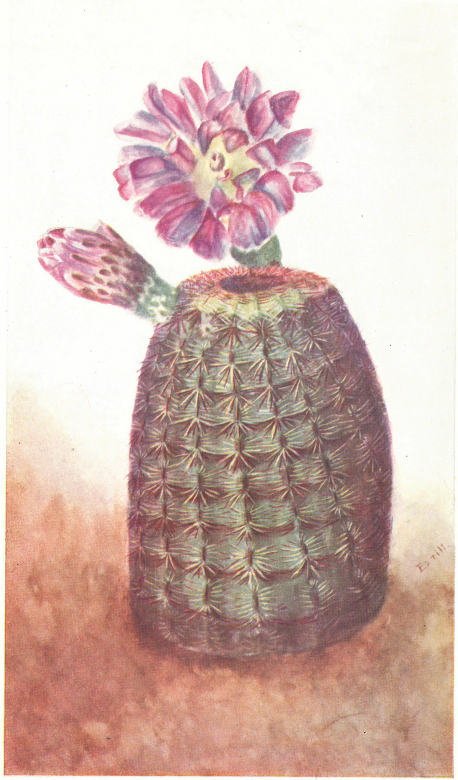
RAINBOW CACTUS (Echinocereus rigidissimus)
A popular beauty, named from the brilliantly colored spines arranged around the plant in many-hued bands or “zones.” Called by the Mexicans Cabecita Del Viejo.
(Named for Frances Bonker, one of the authors of this book)
Bonkeræ, or the Short Spined Strawberry Cactus, is oblong-cylindrical with the tips somewhat depressed. It has low obtuse ridges, fewer than twenty, of a light green. These ridges are covered with a network of radial spines, the younger ones whitish, fading to gray-white, yellow or yellowish brown in age. The centrals are yellow-brown changing to red-brown in older thorns. All the spines are less than a half-inch long and vary in coloring, with brown bulbous bases and translucent tips. This cactus is to be found in clusters of from two to ten stems, and is very attractive with its rose-purple to deep rose-purple flowers nearly three inches long, and its many stamens, stigmas, and filaments in bright and light green. The fourteen petals and nine sepals have obtuse tips and short points; the styles are longer than the stamens. Plants grow along the dry foothills and low mountains in clumps of a foot or less across.
This species grows outdoors and is not injured by temperatures twenty or twenty-five degrees below freezing; in colder climates than this it must be given some protection or grown in cool, dry, sunny greenhouses. Plants may be [86] grown at any season in gravelly or sandy clay soils with light irrigation every two or three weeks to moisten the soil during the growing season or in droughty periods. Or they may be grown readily from seed sown in sandy loam in flats or pots, with partial shade and with enough water to keep the soil moist. The species is a handsome one for rock gardens, as yet little known. Mature specimens transplanted early in spring blossom the same season.
(Named coccineus in allusion to the bright scarlet flowers)
Coccineus, or the Crimson Flowered Hedgehog Cactus, is built up of stems four to seven inches long and about two inches in diameter. The tips of the stem are rounded and covered with radial spines no more than three-quarters of an inch long. It has three central spines which are much stronger than the radials, all thorns erect and spreading. They are flask-shaped at their bases and are white to yellowish white. The flowers are a beautiful bright crimson, about three inches long, and remain open for several days before they close. The petals and sepals are thick and firm, bright scarlet, and brownish or orange toward their bases, while the tips of the petals are broadly rounded. The fruit pods are very spiny. These plants grow in dense clumps one to six feet across and two to three hundred stems in a cluster, at altitudes of five to seven thousand feet in the foothills and cañons and along the lakes in northern Arizona, New Mexico, Colorado, and Utah, and in oak, juniper, and pine formations of prairie lands. They prefer the gravelly clay loam of the slopes in sunny exposures and are to be found also among rocks on the high mesas.
This species is not injured by temperatures twenty-five degrees below zero, and hence may be grown out of doors throughout the country generally. It furnishes very interesting specimens for rock gardens. Plants grow readily in gravelly loam or limestone soils and may be transplanted at any season. They thrive even in the hot Southwest but should be given partial shade there and moderate irrigation. In these warmer climates they blossom as early as April but rarely mature fruit. They grow easily from seed in moist sandy soil or clay loam with part shade, and preferably in cooler climates.
There is nothing so beautiful as the dash of color painted by that great artist, Nature, on the canvas of the desert in the springtime and early summer. It is here that plant and flower families vie with each other in their parade of color and fashion. Likewise man, who is tired and hungry for the great open spaces with his year’s work behind him in the spring, seeks the hidden byways trodden only by the few, where he may tramp and meditate and commune with Nature. He loves to hunt new places, to see new things, and then on some winter’s evening to lean back in his comfortable chair and blow smoke rings around the places come back to him again in fancy, where he found that odd piece of cactus lacework and that patch-pattern of thorns and spikes and stems. And he wonders, then, how such marvelous colorings could be, and why they should be, away out in those forgotten places far from the hoof-mark of a burro or the footprint of an Indian or a daring tenderfoot.
The desert is not unlike some huge canvas stretched out over vast distances of mesa and foothill, valley and mountain, which takes on mysterious splashes of color during each cycle of the spring, fading then in the heat of summer and fall. Imagine if you can this tremendous stretch of the desert-canvas tinted with all the minute tracings of the aurora borealis. For to be sure the image of the great painted canvas of the desert, if inverted and hung high in the heavens so as to be seen in all its brilliance, might well [89] make a more splendid curtain than our own aurora borealis, flashing intermittently across the northern skies in flaming letters of crimson and gold.
It seems strange that some of the desert cacti select the daytime, while others of the same family select the nighttime to unfold their matchless bloom. It seems strange that a plant with coarse colorless bark, gray and hoary as with age, can have such delicate and splendid blossoms. It seems strange that so brilliant a coloring can come from such desolation as the desert seems to possess, where there is little or no water and the days are hot and dry. It is strange, indeed, but Nature works in mysterious and devious ways her wonders to perform.
This chapter treats of the Opuntia genus of Cactaceæ, the well known group of Prickly Pears whose flower colorings are remembered as being so exquisite and delicate, so vivid and attractive both near and afar, the lovely tints and hues so well graduated from the bases of the petals to their tips and so symmetrical of distribution, that attention is at once focused upon them. There are about two hundred sixty species of the Opuntia, of which eighty-eight are in the United States, eighty-seven in Mexico, and the remainder in South America and the outlying islands. The genus Opuntia includes not only the beautiful Prickly Pear but also the familiar Cholla, that tall, stately, antlered plant of the desert domain which frowns at you from along the highway as you approach our no man’s land from almost any direction. Starting on a fourth trek into the habitats of cactus plants early in May, we shall look for only the colorful Prickly Pears, characterized by their large pear-shaped joints, the “flapjacks” of the desert; characterized also by their large [90] flaming orange and yellow, or occasionally rich purple and red blossoms, which open for only a short time during the day and close when the shadows of the sun begin to bathe the hills in orange and purples as the desert sunset approaches. In a few cases they unfold for a short time the following day, but most bloom for but the one period of five to seven hours or so. Commonly the blossoms change from yellow when they open to orange in the afternoon, and in some species to red-orange. It is also noted that when the flowers unfold for a second day, their bright colorings deepen and darken in orange or red. We find that the clan of the Prickly Pear nearly always have thorns different from those of most other groups of Cactaceæ in that they are only of one kind, though the sizes may vary. In the genus of Opuntia there are no radial nor central spines; the thorns are merely spines in the full sense of the word. We note that the Prickly Pear is really a shrub with many stems branching from the base, and that their pear-shaped joints are in reality stems or branches and are not just leaves as many suppose; the true leaves being very small and scalelike and disappearing after a short time, withering away and falling off. The species grow readily from these pearlike joints, and this is a common method of propagating Opuntia. They will also grow from seeds, but these develop very slowly and require a long time in the ground before they germinate.
Southern Arizona
It is from Tucson, in the rocky foothills of southeastern Arizona, that we start on our long trip across the state and into old Mexico and California. The first of the lovely auroral coloring to attract our notice is the low spreading Prickly [91] Pear called Opuntia Blakeana in honor of Dr. William Blake, who was formerly Geologist and Director of the College of Mines and Engineering of the University of Arizona. Forming in loosely branched clumps on the desert, eight feet or more across and only a foot or so high, this growth is most strikingly characterized by its translucent brown fringe of spicules along the margins of the areolas and its needlelike purplish brown thorns suffused with gray toward the bases. The brilliant orange-red and yellow blossoms, nearly three inches long and as broad, like most of their sister species open and close in the daytime, the sepals greenish yellow toning off to an orange-red base. Blooming time is in April and May, the fruit comes on in July; the latter when ripe is used for food by the Pima and Papago Indians of Arizona, and while they eat it both raw and cooked it is not utilized as is that of some of the other and larger varieties.
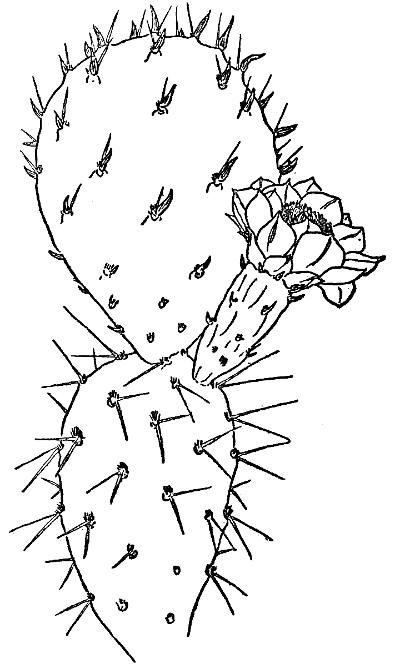
PAPAGO FRUIT CACTUS (Opuntia Blakeana)
Southern Arizona
At altitudes of three to five thousand feet in the sandy and clay loams across southern Arizona one may see a prickly pear called delicata on account of its small size and its slender joints and spines. This baby Opuntia was only recently discovered and is considered a rare find, though [92] little is known about its distribution. The tiny plants are sometimes but three inches high, growing to ten inches in different specimens, with one or several stems, long needlelike spines and large yellow flowers, as usual blooming in the morning and closing up their petals in the afternoon. New and interesting specimens of the cactus clan are discovered now and then, and it gives the botanist and the layman much pleasure to study and classify them, to look up their haunts and habits and place them where they belong, so that all may see and know them.
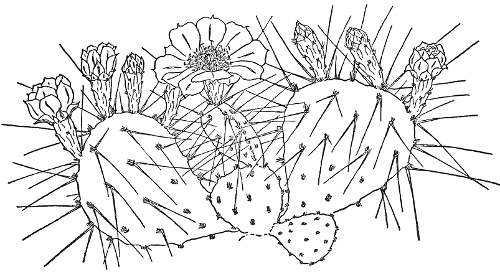
DELICATE PRICKLY PEAR (Opuntia delicata)
Southern Arizona
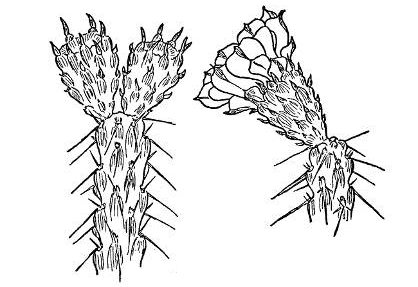
WHIPPLE’S CHOLLA (Opuntia Whipplei)
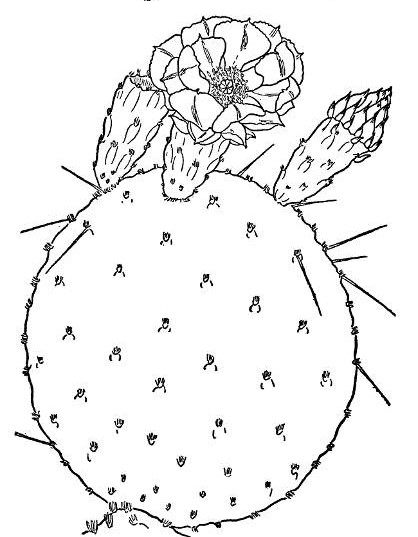
PURPLE PRICKLY PEAR (Opuntia santa rita)
We are approaching the beautiful Santa Rita Mountains not far from Tucson, Arizona, nearing also the end of our long afternoon’s work, for the blue and purple haze that betokens the close of a hot desert day is gathering around the distant peaks and the sun hangs low over the horizon, seeming loath to bid farewell to mountain and desert cañons and to weary mortals here below. A symphony in purple and yellow greets our tired eyes and brightens our jaded spirits as we motor slowly along the highroad; and we stop to get a closer view of this handsomest of all the brilliant Opuntia, the Purple Prickly Pear. A dash of purple in the sepals tones into golden yellow in petals and stamens of the large beautiful blooms, three inches across when full open and nearly four inches in length, the lemon and deep yellow flowers in vivid contrast to the bright purple joints of santa rita in the spring. Then in summer the densely glaucous gray-blue joints form a striking color scheme together with the bright purple fruit. Two to five feet tall, the plants branch from a short thick trunk in numerous stemlike appendages which look like so many “flapjacks” on the desert. They prefer the gravelly or rocky soils at levels of three to five thousand feet, and grow over drab bajadas and somber foothill slopes near the high Santa Ritas, where they were discovered by Dr. David Griffiths and named for this majestic range which towers in sight of these brilliantly beautiful and slender-spined pearlike cacti. These rare plants are finding a place in many gardens throughout the Southwest, and even abroad in England they may be grown satisfactorily in indoor cactus gardens.
Southern Arizona
The Smooth Prickly Pear is a dainty morsel, and how the cattle like to espy it in the few open spaces where it ventures to grow! For this cactus is nearly spineless and clings to the inaccessible cañon slopes where stock cannot prey upon it. In April and May it forms a striking picture on the desert canvas, a great patch of large, showy, lemon-colored blossoms peering forth from the jutting and protecting rocks on all sides of the steep mountain cliffs here in southern Arizona; [95] in July it changes this brilliant coloring with almost kaleidoscopic swiftness to purple and pink splashes of the fine large fruit. Truly the desert is aflame with glory when the prickly pears come forth in bloom! Is it the soul of the Flower trying to find expression in beauty and fragrance, attuned to the soul of the poet and the lover of desert creation, striving to grow in tune with the Universe? Here is a lesson, perchance, that he who runs may read; for those who can pierce the vale of mysteries it is called “in tune with the Infinite.”
Opuntia laevis is three to six feet tall with erect wide-spreading branches ascending from the base. A very few needlelike spicules develop along the stem, crowned by the large striking lemon-colored flowers with orange-red centers, nearly three inches long and as broad, opening in the morning and folding up in late afternoon.
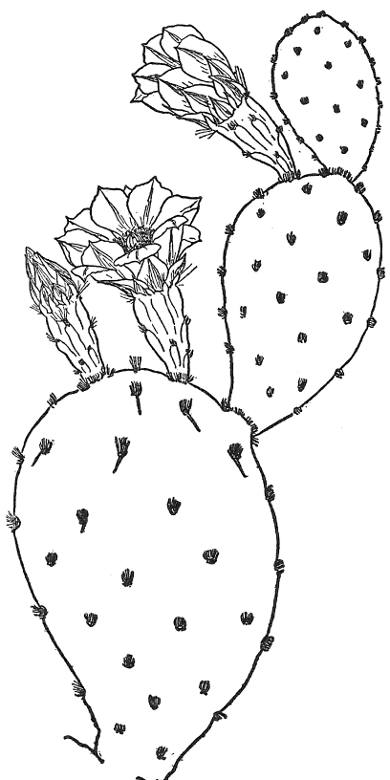
SMOOTH PRICKLY PEAR (Opuntia laevis)
Southern Arizona and Sonora
Opuntia Toumeyi is a most attractive species and a distinctive type among cacti, covering the foothills of southern [96] Arizona mountains with its waxy green joints and pink spines, sometimes brownish white thorns, and bright golden satiny blooms shading into red and orange at their bases and yellow-green toward the margins, suffused with purple-brown, a lovely harmony of color splashing across the painted canvas of brilliant desert flowers. Appearing in loose golden clumps, one and one-half to three feet tall, with the spicules forming a dense pinkish gray fringe about the upper half of the areolas, this prickly pear roams the rocky, gravelly foothills and mountains here in southern Arizona and in Sonora.
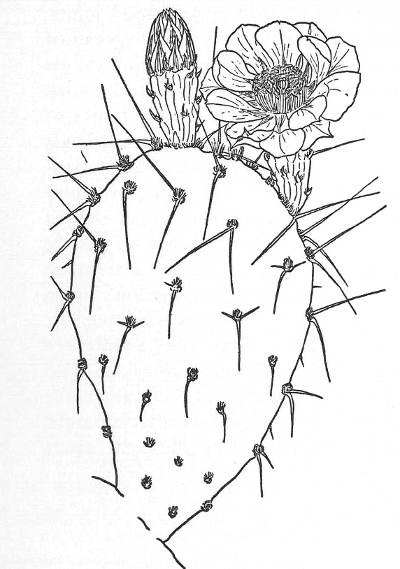
FOOTHILL PRICKLY PEAR (Opuntia Toumeyi)
Southern Texas
We leave the foothills and bajadas of southern Arizona and cross the Rio Grande into the prairie lands of southern Texas in search of a peculiar Prickly Pear growing in the vicinity of San Antonio, Texas; this Opuntia is widely cultivated [97] now in cactus gardens, and one should not miss it even though it takes several hours to reach the destination. A striking plant on account of its long lance-shaped joints, Cow’s Tongue grows three to five feet tall with a spread of three to six feet, in spring covered with great satiny yellow blossoms nearly four inches long, tinted in green and golden shades, and forming in numerous patches, great splashes of gold against the dull brown and grays of desert prairie lands in southern Texas. The fruit is quite tasty (it is commercialized by Mexicans), eaten raw and made into spicy jam or syrup. We note the characteristic tongue-shaped joints, a foot or two long, which give the plant its specific name linguiformis (tongue-shaped), and also its common name Cow’s Tongue. The late afternoon shadows begin to creep over the rolling prairies and the sun is sinking low on the horizon in one last attempt to linger here awhile, ere it sweeps our no man’s land in a vast flood of glory and is no more. Many tourists prefer to travel at this hour and while the desert moon is shining, for the cool and alluring night breezes render motoring delightful over the arid sands during the latter part of May.
Northern Sonora and Southern Arizona
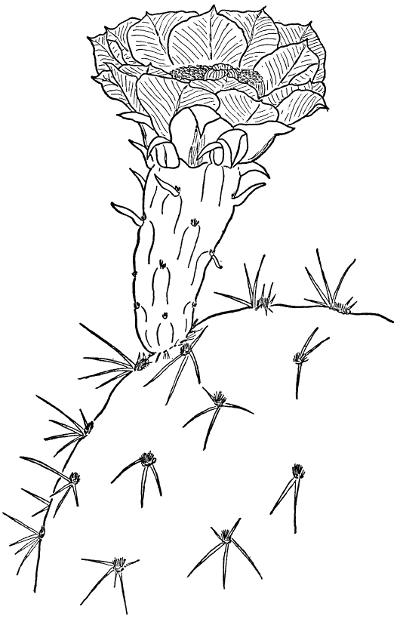
DISCUS PRICKLY PEAR (Opuntia discata)
We have crossed the international border once more, this time driving to Nogales, Arizona, then across the street into Nogales, Sonora, looking for a well-known Prickly Pear growing on the grassy mesas and bajadas of northern Sonora and of southern Arizona. Its name discata refers to the large circular and disklike joints of the stems, nearly a foot in diameter and about half an inch thick, which form the many ascending and spreading branches of this shrub; and it seems to us we could almost use them in throwing the [98] discus in the marvelous Olympiad Games to be held this summer, here in the giant amphitheater of the sun. The beautiful plants grow in large clumps about five feet high and five to ten feet across, standing forth as most striking figures on the desert canvas with their erect spreading pear-like arms and the vivid harmony of color in their large and brilliant blooms; glossy lemon-yellow shading into deep orange, then the yellow-green tints of the sepals and the cream-white suffused with a delicate pinkish cast of the club-like styles. There is a little animal living on the desert known as the trade rat or pack rat which invariably seeks the Opuntia discata for building his home; if the habitat of this little rat is investigated about five bushels of débris will be found including cactus joints, stems, sticks, and even stones, all carefully piled away in and under these plants. This is a sure sign of the pack rat’s nest, for in such a home his needs are all taken care of; the discata gives him protection [99] from wandering coyotes and dogs, water and food in its succulent stems, and still more food in the ripe sweet fruit. The latter is covered with many fine spicules and the Indians skillfully remove these by rubbing, so as not to get the prickers into the fingers; for they are very annoying and irritating if they find their way into the flesh. The ripe fruit is gathered for food by Mexicans and Indians, who make from it a fine syrup, delicious preserves and other delicacies.
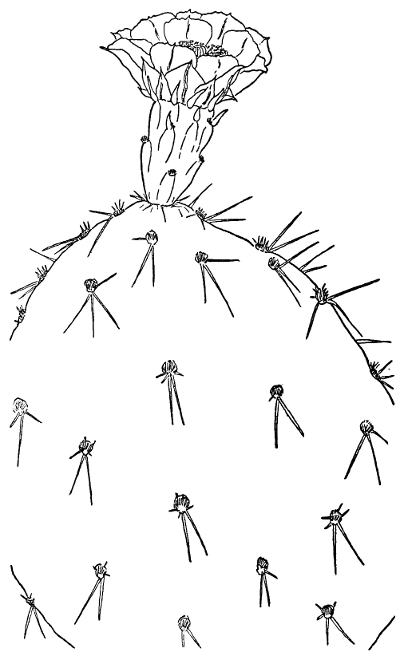
ENGELMANN’S PRICKLY PEAR (Opuntia Engelmannii)
Northern Mexico, Arizona, and Texas
Next in our journey across the land of the burning sun we find Engelmann’s Prickly Pear here in Northern Mexico—a very fine, large Opuntia which grows also in Texas and Arizona. This cactus like several others has been named in honor of Dr. George Engelmann, an early outstanding student of cacti. The plant is a rather large shrub six to [100] twelve feet across and three to five feet tall, with many divergent and ascending branches from the base, these often rooting and forming an impenetrable growth. Its large bluish green joints contrast vividly in the spring with the huge golden or lemon-yellow flowers which appear in great numbers in April and May; while again in July there is another marked contrast to the deep purple or maroon-purple fruit, which is pear-shaped and often three inches long. As many as sixteen fruit are borne on a single joint or pad of the Prickly Pear. These the Mexicans and Indians eat when ripe, and the natives make a most palatable syrup from the jams or conserves.
Northern Mexico, Central Arizona, and Western Texas
The Opuntia macrocentra grows in sandy soil or clay loam at levels of three to five thousand feet. The plants are no more than three feet tall and are called macrocentra in allusion to the long spines, over three inches in length. The large showy blossoms are about three inches long with light yellow petals and bright red or orange-red centers. This flower also opens and closes in the daytime and lasts for one day only. The olive-green joints of the plants, which are suffused with purple or sometimes purple throughout, the dark purple-brown spines, and the yellow bloom create an uncommon sight here on the open desert out over the mesas and bajadas in Northern Mexico.
Southeastern California, Western Arizona, Northern Sonora, Southern Nevada, and Southern Utah
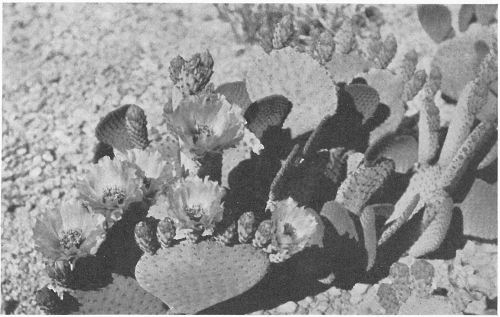
BEAVER TAIL (Opuntia basilaris)
An odd and interesting little Prickly Pear, with its many spicules appearing each like a small fuzzy tail, and called by the natives Beaver Tail.
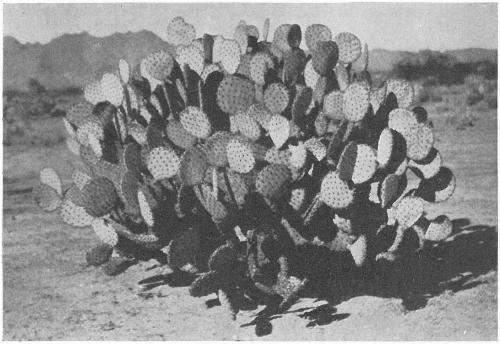
FLAPJACK PRICKLY PEAR (Opuntia chlorotica)
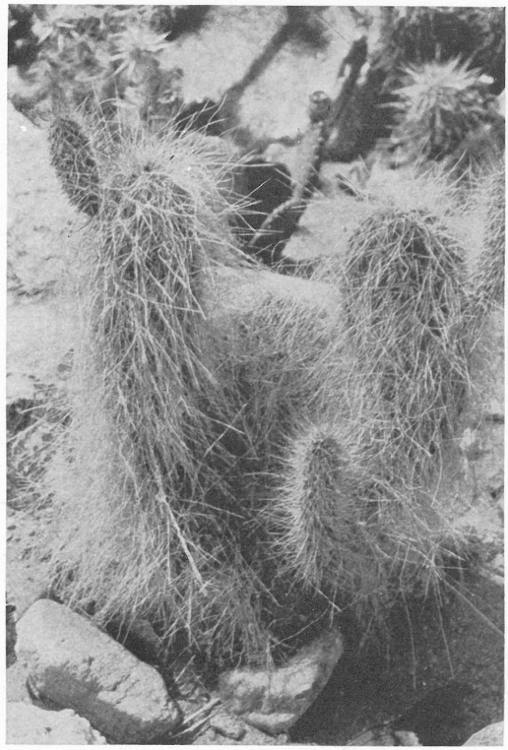
PORCUPINE PRICKLY PEAR (Opuntia hystricina)
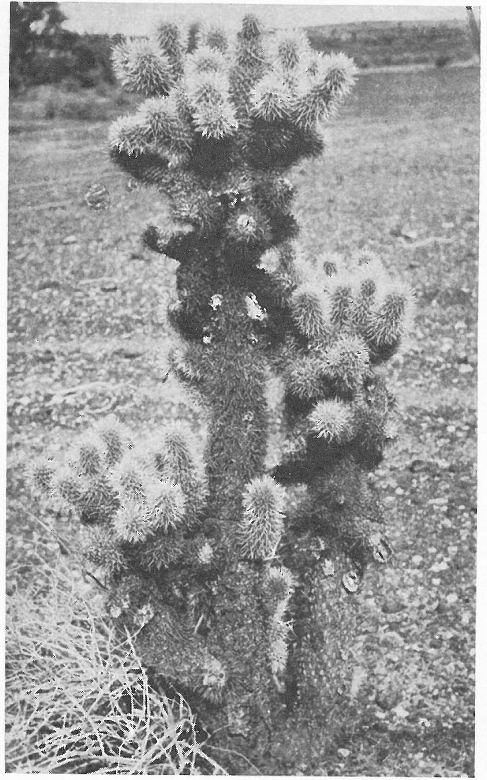
TEDDY BEAR CACTUS (Opuntia Bigelovii)
In southeastern California we run across that odd and interesting little Prickly Pear with its many spicules appearing like a small fuzzy tail, and hence called by the natives Beaver Tail. Because of its habit of growth and its spineless joints of light blue or blue-gray and bright rose-colored flowers, the basilaris is different from all other Prickly Pear cacti. Beaver Tail blooms profusely, and when in blossom the clumps of plants on the mesas are bright rose and purple, the flowers almost completely hiding the shrubs and forming a brilliant splash of hue and tint, a solid, unbroken patch of color on the gray or brown stretches of mesa and foothill.
Basilaris prefers the most arid and sterile sandy or gravelly soil at altitudes of a thousand feet and less, on the bajadas of Nevada, Utah, western Arizona, and here in Southern California. This cactus does not grow very tall, seldom more than a foot, and the spread of the rosettelike growth is about three feet across. The large beautiful blooms, three inches long and nearly as broad, appear in clusters on the margin of a joint, opening in the forenoon and closing as the sunlight fades. There are no spines, and the closely set areolas, crowded with spicules which are easily dislodged, form the chief protection of the shrub; spicules are very small and light and when dried fall off, and carried by the wind are easily caught in one’s clothing or body; they are effective protectors and neither rodents nor grazing animals eat plants where they appear and even man fears them more than cactus thorns because of the difficulty of extracting them and on account of the pain and sores which they cause.
Southern California
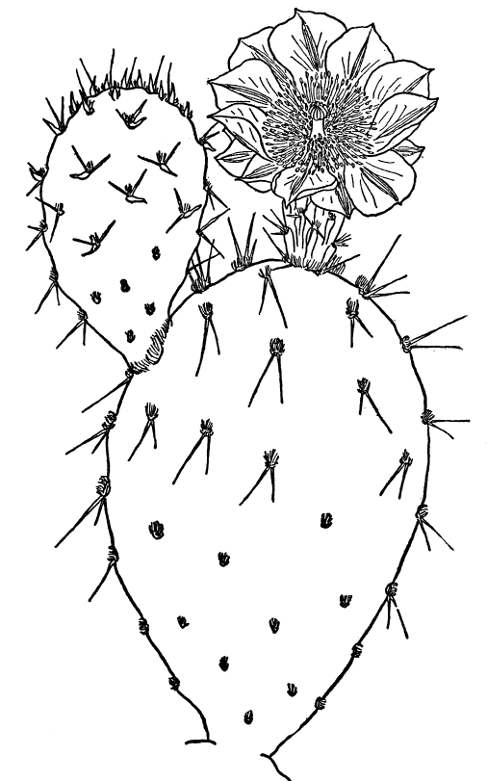
GOLDEN PRICKLY PEAR (Opuntia Covillei)
We are approaching the lovely Santa Monica range in Southern California. Mt. San Bernardino with his crown of snow towers in the distance; Mt. Baldy with his white head bald almost the entire year round, we perceive even farther west; and magnificent old San Gorgonio rears his stately crest far above all the surrounding peaks. This is one of the most beauteous spots in Southern California. The vast depths of that great natural amphitheater near Redlands and Riverside as viewed from Smiley Heights form a panorama gorgeous beyond description, with every color of the rainbow brilliantly present, a marvelous thrilling picture painted against the landscape far and near: marvelous in its splashes of purples and greens and pinks and orange-reds against the somber background of the grand old mountains; thrilling in the vastness of the limitless panorama spread out before us on all sides, as we stand here on Smiley Heights gazing into the great cañons below, which seem to magnetize us against our will and to draw us down into their depths by the sheer force of distance immeasurable. Truly a fit setting for our little Opuntia Covillei, playing his [103] humble part in all this gorgeous portraiture of plant and flower, mountain and valley and rocky cliff; and with the touch of the Master Artist he takes his modest place in the great aurora borealis of the desert. Bright yellow and nearly four inches long are his large beautiful blooms, toning into the green of the stigma lobes in a happy combination of Nature’s making, and forming, over the two- or three-foot stems with their pale blue-green joints or dull green pearlike appendages, a becoming aureole of gold, quite dazzling in the brilliant sunlight. Sometimes he grows in dense thickets several yards across and fringed with thick clusters of inch-long brown and yellowish white spines and spicules, sharp and needlelike, harshly repulsing the daring tourist who presumes to pluck his beautiful blossoms too rashly.
Southern California, Arizona, Lower California, Northern Mexico, New Mexico, and Nevada
We are nearing the end of our long quest for the brilliant Prickly Pears, having crossed the Arizona and California deserts on our way, dipped down into southern Texas and Northern Mexico, and now are intent on finding a distinctive growth here in southwestern California called Opuntia chlorotica. Light purple is the fruit of this typical cactus, the stems yellow or light green; straw-colored and brownish are the slender bristlelike spines, translucent yellow the spicules. Almost a gay rainbow of itself, chlorotica graces the mountain cañons and foothills of six great sections of the vast southwestern desert. A short trunk, half a foot or a foot tall, branches into many jointed “flapjacks” six to ten inches long and about as wide, which combine to form a compact rounded head three to six feet high. The scaly fissured faces of the pearlike basal joints so typical of the prickly pear are [104] light brown and purplish, the others pale green and bluish green; the slender yellowish spicules are not quite half an inch long, the bristling spines a trifle longer. The bloom, as of so many of the prickly pear species, is of a light lemon-yellow with a brilliant orange-red center, about two and one-half inches long and across; like others of this clan it opens early in the morning, closing when the late afternoon shadows begin to spell the end of the hot desert day. Seldom appearing in clumps, generally growing alone, chlorotica delights to cover the foothills and low mountain cañons with her pretty lemon blossoms, her short stout trunks, and their numerous flat pearlike joints.
Northern Arizona, New Mexico, and Nevada
As we approach Los Angeles, California, we recall a peculiar little growth in northern Arizona, Nevada, and New Mexico called Opuntia hystricina; also the Porcupine Prickly Pear, its long slender needlelike spines, reddish or red-brown, giving the plant a shaggy appearance strongly resembling that bristling little animal. In fact the name of the species hystricina comes from the Greek word for “porcupine.” Only a foot or so tall, its thorny stems spread out into loose clumps, the flat hairy joints, five or six inches long, looking just like so many bristling young porcupines; then with a crescent mass of light yellowish spicules an eighth-inch long or less, and six to ten finely grooved white and brownish spines, encircled sometimes with white and brown bands. In lovely contrast appear the beautiful large purple blossoms, three inches long and with as great a spread when fully expanded in April or May, opening but once, then closing in late afternoon never to open again. Thriving in the clay loam and gravelly soils of mountains and rocky cañons in northern Arizona and Nevada, ranging far up from five to seven thousand feet, this hardy cactus will endure temperatures even below zero without the slightest injury.
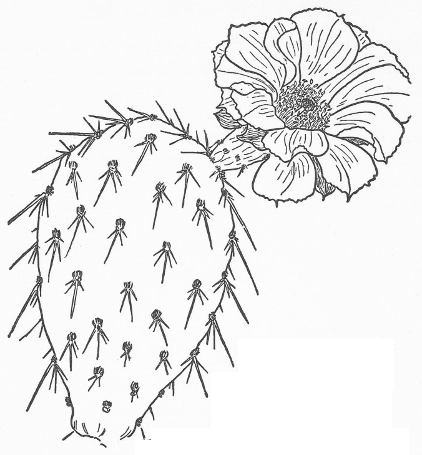
PORCUPINE PRICKLY PEAR (Opuntia hystricina)
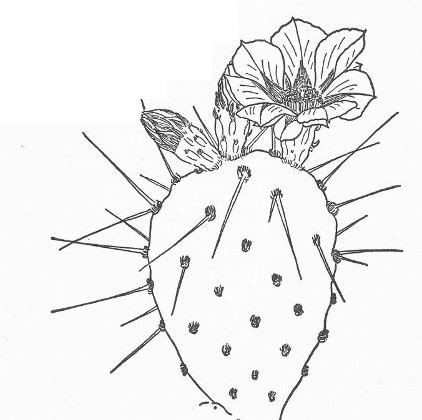
LONG SPINED PRICKLY PEAR (Opuntia macrocentra)
And now the borealis of desert color has passed us by in its rush to the coolness and stillness of the desert night, only to recuperate and renew its gay attire and appear in fresh array of hue and tint in the morrow’s pearly dawn. In ages long gone by, when worlds were in the making, with the swish of the eternal paintbrush the flowers received their colorings, and it is with awe and admiration we have greeted these colorful creations come forth at the touch of the Master Artist; for we find them only here in the land of the burning sun, where they are born to their lonely vigil under the sky and stars, but to live and thrive and to fade and die, only to reappear anon in eternal and varied expressions of the Infinite Mind of Nature. Thus to-day passes into to-morrow, when new fields are waiting to be painted on the glorious canvas of the desert, and so we must take our leave of gorgeous bloom and brilliant filigree alike, and hurry along as the setting sun traces a last fiery pattern across the flaming heavens.
These plants are large or small shrubs, consisting of several jointed stems, the flat platelike joints or branches pear-shaped, elongated, thorny, but not distinctly tubercled, the clumps of joints from one to six or more feet in height, and from two to ten or twelve feet across. Spicules, sometimes called glochidia, are always present. The plants always have scalelike leaves which soon fall off. The Prickly Pears, like the Cholla, have spines of but one kind and of many different [107] sizes, but they are not fierce nor as dangerous as the thorns of the Cholla, and they are never sheathed. The flowers are symmetrical and very beautiful, among the most brilliant of all the gorgeous cactus bloom, large flaming orange or yellow blossoms, usually. They open in the forenoon and close in the late afternoon of the same day, generally, soon falling away from the young fruit. The latter is covered with tubercles and always has spicules, scales, and generally spines, is either fleshy or dry, and is edible, often purple, falling away soon after maturity.
Plants grow readily from cuttings of one or two joints set a few inches deep in moist sandy soil and given enough water to keep the soil moist; the cut surfaces should be allowed to dry thoroughly before planting. If mature cuttings are used and planted in early spring, many species will blossom the same season. Plants can be grown also from seeds planted a half-inch deep in sandy soil out of doors or in flats, with part shade and watered enough to keep the soil moist but not wet; but these develop very slowly and remain a long time in the soil before they germinate. All species grow indoors or out, preferably in a southern exposure.
(Named in honor of Dr. William P. Blake, professor of geology in the University of Arizona and director of the College of Mines)
Blakeana, or the Papago Fruit Cactus, is formed by stems a foot or so high which grow on the desert in clumps eight feet or more in diameter. The branches or joints are pear-shaped, about three inches wide and eight inches long, colored [108] a medium green suffused with beautiful purples. The spicules and spines are very distinctive, the former growing in fringes and easily dislodged. The spine colors are brown or purple and tone off into gray, and the thorns are very sharp and needlelike, dangerous when the plant is not handled cautiously. The flowers—beautiful and also very showy, from two to three inches long, bright satin-yellow with red-brown centers—appear in April and May; the fruit ripens in July and is of a pale pink-purple, quite sweet.
This species will grow outside and is not injured by temperatures as low as twenty-five degrees below freezing. With temperatures lower than this it should be protected or grown indoors. Mature cuttings composed of one joint planted at almost any season, but preferably early in spring, with a half of the cutting covered, grow very readily. They may be planted in any position or simply laid on the surface of moist soil. Very little irrigation is necessary, but watering once a month during the growing season is beneficial. Grown indoors or out.
(Named from its small size and delicate structure)
Delicata, or the Delicate Prickly Pear, is formed by stems three to ten inches long which are thin, wrinkled or dished joints of bluish green and purplish tones. These joints or stems are covered with bright yellowish spicules which seem to be arranged in circular bundles, and with three twisted spines one-fourth inch to three inches long, all three very slender, delicate and whitish. The flowers are two or three inches long and wide, of a bright satiny yellowish hue; the [109] fruit is pear-shaped and slender. This plant has small joints, and with its long weak slender spines and large beautiful flowers is a very attractive species. At the same time it is quite a rare specimen of the Cactacea Family.
Plants grow indoors and out, and are not injured by temperatures of twenty-five or thirty degrees below freezing. With colder weather they require protection. They are difficult to transplant on account of the fleshy spindle-shaped roots, which decay if injured. Plants grow readily from the cuttings of two joints or stems with the lower cutting covered with soil, and prefer a sandy soil. They may be grown also from seeds, but these germinate slowly. The delicata thrives with moderate irrigation and should be watered once a month during its growing season and given good drainage.
(Named from the Santa Rita Mountains near Tucson, Arizona, in the vicinity of which it was discovered)
Santa rita, or the Purple Prickly Pear, is a plant from two to five feet tall composed of jointed compact stems, a foot or less in length and half as wide, forming into a head. These joints are a bluish gray suffused with purple tones and are circular. This characteristic shape distinguishes the species from the ordinary Prickly Pear, which has oblong or elongated joints. The spicules form in a translucent yellowish fringe; there are one or two twisted yellow spines, growing on many specimens to three inches in length. The flowers are about three inches long, and are very showy with their satiny lemon-yellow colorings appearing in April and May. The light green and purple fruit is elliptical. This plant is the [110] handsomest of all the southwestern Prickly Pears, while the purplish circular joints with but a few slender spines make it quite distinctive.
This variety is popular in cactus gardens and grows easily from mature cuttings; if they are set in the ground early in spring, the plants blossom during the same season. Half of the cutting should be covered, and then the plant should be watered lightly during the growing season to keep the soil moist. The plant prefers gravelly or loamy soils. Fine symmetrical plants are grown from seeds, though these germinate slowly. This plant is not injured by zero temperatures, and grows indoors or out.
(The specific name laevis means “smooth”)
The Smooth Prickly Pear is practically devoid of the spines so prevalent in the cactus family. Many specimens reach a height of six feet; the joints or branches are from six to twelve inches long and loosely branched from the base, and are a yellowish green. The spicules are yellow and brown or a mixture of these two colors, while the one or two slender deflexed spines are white or tan. The flowers are large and quite showy, and with their lemon-yellow petals and orange centers present a very beautiful color scheme. The bloom is about three inches long and as broad, blossoming in April and May; the purple fruit ripens in July, and is about the size of a large walnut; its flesh is pink fading into purple.
These plants grow indoors or out and will endure temperatures twenty-five or thirty degrees below freezing without [111] injury. Young plants may be transplanted at any season, or mature cuttings may be planted early in spring. They grow well in any ordinary soil, preferably gravelly loam or rocky soil, and should be watered once a month to keep the soil moist during the growing season. The seeds are slow to germinate.
(Named in honor of James W. Toumey, former professor of botany at the University of Arizona)
The Foothill Prickly Pear is another of the clump-growing variety of the cactus clan, reaching to a height of about three feet. The stems form readily in large clumps along the foothills and low-lying mesas and swales in sunny exposures, where the plants do best. This species has the usual system of spicules and spines, the former a fourth-inch, the latter about three inches long. The spicules are tawny or yellow and brown, while the needlelike crooked spines are white or a light red-brown. In the gathering shadows these thorns give the plant a pinkish gray cast. The bright showy blossoms are about the length and width of a teacup, are a bright yellow with orange centers, and appear in April and May. The elliptical purple fruit ripens in July.
Plants grow indoors and out and are not injured by thirty degrees of frost, but require protection for temperatures below zero. They grow easily from mature cuttings planted at almost any season. Before planting, place cuttings in shade for about two weeks to allow cut to heal. Cover about half of the cutting with soil and plant in rocky or gravelly [112] clay; water lightly during the growing season and in droughty periods.
(All three names refer to the characteristic tongue-shaped joints)
The Cow’s Tongue is an oddly formed Prickly Pear which grows tongue-shaped joints a foot to thirty inches long. These flattened, tongue-shaped joints are about as wide as a man’s hand and a little thinner, covered with well spaced spicules and spines. The edges of the joints are also fringed with needlelike thorns which are dangerous to handle. These light greenish stems or joints form into thickets growing from three to five feet high and creating a very good hedge. The spicules are a light yellowish; some of the spines are a straw color, and it is to be noted that about half of them are a pale purple and brown, not more than two inches long, the spicules about half as long. The flowers are about the diameter of a large cup and are very showy, of a beautiful satiny yellowish hue. The fruit is light purple, the flesh greenish, ripening in July.
This odd-looking cactus may be easily recognized among all other Prickly Pears by its characteristic tongue-shaped joints.
Plants are not injured in outdoor zero temperatures, but for colder weather they should be covered or grown indoors. They grow readily from cuttings set about six inches deep in moist soil and watered lightly bi-weekly during the growing season. Cuttings should remain out of the ground for two [113] weeks in shade before planting, to callus over the cut ends. Almost any kind of soil will answer.
(The names refer to the disk-shaped joints)
The Discus Prickly Pear, or discata, also grows in clumps from three to five feet high and as much as ten feet across, and has numerous ascending and spreading branches. This plant, too, will make an excellent cactus hedge. Its spreading branches are the disk-shaped joints of the stems, nearly a foot in diameter and circular and platelike, of a pale blue-green which in some lights is changeable. These disks are covered with fringes of yellow and brown spicules, needlelike and tough, and the edges also are fringed with them. Placed among the spicules are three or four twisted stout spines, white with yellow tips, and awl-shaped. The large flowers are three or four inches long, and are very showy and conspicuous with their bright satiny yellow tints. They bloom in April and May, and the pear-shaped deep purple fruit, three inches or so long, comes in July.
Plants grow outside and indoors, enduring zero temperatures without injury. Plant mature cuttings of one joint six inches deep in moist soil early in spring and water about once a month to keep the soil lightly moist. They will grow in almost any soil, but best in sandy loam. Plants also grow from seed, but these are slow to germinate.
(Named in honor of Dr. George Engelmann, an early and outstanding student of cacti)
Engelmann’s Prickly Pear is a large spreading shrub six to twelve feet in diameter growing to five feet in height, [114] with distinctive “pancakelike” greenish joints, about the size of a medium-sized meat platter, but somewhat elliptical and ascending from the base. The general color of this plant is greenish. Its spicules are abundant in fringes along the joints, colored orange-yellow or brownish, while the four spines are awl-shaped with purplish and tawny yellow bodies, and slightly banded. The brilliant satiny yellow flowers are large and very showy. They have the curious characteristic of changing to orange in the afternoon and orange-red in the evening, and are a little less than five inches in width and length. The plant blossoms in May and June, and the pear-shaped purple fruit comes in July.
Treat cuttings in all respects as Opuntia discata. Engelmannii are not injured by zero temperatures.
(The name macrocentra refers to the long spines)
The Long Spined Prickly Pear is a plant about three feet tall growing from stems which ascend from the base. These joints are about the size of a man’s hand, circular or egg-shaped, and are of a dull olive-green suffused with purple, sometimes purple throughout. This plant has a system of spicules and spines arranged much in the usual cactus fashion. The spicules are formed in bundles, generally crescent-shaped and red-brown or tawny. The young spines are a deep red-purple, while the older spines are often cross-banded, purple-brown, reddish, or nearly black, three inches long, or longer, fierce and needlelike and sometimes twisted. The flowers, about three inches long and broad, are yellow with bright red or orange-red centers which make them quite attractive. The pink-purple fruit is elliptical and comes in July; the fruit-meat is light greenish.
Plants may be grown in zero temperatures without injury, and thrive outdoors or indoors. They grow easily from mature cuttings set out at almost any time, but preferably early in spring; the cut should be allowed to callus over before planting. They should be watered once a month or so during the growing season to keep the soil slightly moist. Gravelly clay soils are preferred, though the plants grow well in sandy clay or loam.
The Beaver Tail, or Opuntia basilaris, gets both its common and its specific name from the appearance of the joints growing from the base, which are covered with spicules and resemble a beaver’s tail. This plant is usually about a foot tall and two or three feet across the spread of the rosettelike growth, with the fanlike or beaver-tail joints coming from the bases. These joints are about six by nine inches and of a blue-green suffused with purple and covered with fine white hairs. The older joints become crosswise wrinkled. The red-brown spicules are very abundant, short and easily dislodged. There are no spines on the plant. The purple flowers are very numerous, about three inches in width and length. They appear in April and May, and the fruit, which is covered with many fine hairs, comes in July.
Plants are uninjured by temperatures twenty-five degrees below freezing. Transplant at any season; mature cuttings planted early in spring will blossom the same season. Plants may be set in gravelly or sandy soils with good drainage and [116] watered lightly once a month during the growing season or droughty spells.
(Named in honor of Dr. Frederick V. Coville, curator of the National Herbarium, Washington, D. C.)
Covillei, or the Golden Prickly Pear, is a plant two to three feet tall and three to four feet in diameter growing with ascending or spreading branches in jointed form, which are seven to ten inches long and four to six inches across. The general color of the plant is pale blue-green. This plant often forms in thickets during growth and is covered with numerous brown spicules occurring in bundles or growing in a fringe. There are about four spines of light brown and yellow suffused with white, sharp and needlelike. The flowers are very showy and of a bright golden color, about three inches in length and width. The fruit is pear-shaped and purple.
Transplant at any season, or grow from mature cuttings planted five or six inches deep early in spring—they will then blossom the same season. Water about once a month to keep the soil slightly moist. Occasionally used in Southern California as a hedge plant. Plants will endure twenty degrees of frost without injury; for colder temperatures protection is needed. Grown indoors or outside.
(The name chlorotica refers to the light green coloring of the plant)
The Flapjack Prickly Pear grows from three to six feet high from short trunks but a few inches long. The branches [117] are erect, forming a rounded head which is quite attractive. The upper joints look very much like “flapjacks” from six to ten inches long and about as wide. The color of the plant is light yellow-green with sometimes a blue-green cast. The spicules are very conspicuous and are slender and very sharp, about one-quarter inch long, of a translucent yellow and arranged in a crescent form. The four or five spines are a little longer than the spicules, sharp, slender, and bristlelike, yellow and brown. The flowers are nearly three inches in length and width, are light lemon-yellow with orange-red centers, and blossom in May and June.
This Prickly Pear grows indoors or outside and is not injured by temperatures twenty or twenty-five degrees below freezing. It can be transplanted at any season. If mature plants are transplanted early in spring they blossom the same season. Cuttings do not root readily and sometimes remain in the ground a year without growing. They should be planted early in spring in sandy or gravelly clay loam; the plants should be watered about once a month to insure good growth.
(Named from its long reddish or brownish spines)
The Porcupine Prickly Pear is formed of stems a foot or so high covered with finely grooved spines, long and slender and needlelike, up to four inches long, white and brownish red. The spicules occur in a crescent-shaped mass of light brown or yellowish colorings. The flowers are two to three inches long and as broad. They are very showy and bright purple or yellowish; they appear in April and [118] May, while the fruit ripens in July and August. The Porcupine Prickly Pear grows at high altitudes and will endure temperatures below zero without injury.
A popular beauty in gardens, it grows readily from mature cuttings planted at almost any season. If planted in early spring, they should blossom the same season. The cuttings should be dried off first to give the cut time to heal over, planted in gravelly or loamy soil with about one-half of the cutting covered, and watered once a month during the growing season. The species may be grown also from seed in flats or pots in moist soil with partial shade but with dry air. The plants are not injured by temperatures of twenty-five degrees below zero, and hence with proper soil, drainage, and limited irrigation may be grown out of doors in almost any part of the United States or of the temperate zones.
Some of the first inhabitants of the plant kingdom to greet the traveler approaching the desert from almost any direction are most unfriendly, fierce, and strongly armored, as if they would resist intrusion into their own special domain. These fierce cacti are small fortresses of the desert. Out there under burning-hot dry winds, where water is mighty scarce, where the soil is pulverized rock or shale or wastes of alkali sand, life at best is but little more than a fight to survive against yearly drought, seasonal storm, and blazing heat; even the bold woodpeckers, the rodents, and the sly sand foxes play their part in this silent drama Nature stages in the struggle for existence. Among the first greeters of the desert are the Cholla members of the great genus Opuntia, the fighters of the strange Fantastic Clan. Their flower colorings are many and variegated, mostly beautiful yellows and orange-yellows, purples, reds and browns, maroons, orange-reds and lavenders; some species possess nearly all colors of the spectrum and are veritable rainbows of tint and hue, with the desert for a dark and picturesque setting. What could be more beautiful than the desert rim with its towering peaks unrolling into low vistas of bajadas, receding into still lower valleys and swales, piled here and there with rocks of volcanic outcroppings, and then the great splashes of Cholla flowers with their brilliant patchwork of colorings stuck at random on their drab, gray, somber, twisted, thornlike, armored trunks? No artist has painted this glorious desert [120] canvas in all the gorgeous tints and hues, the wonderful shadings and tones of the Great Builder’s masterpiece, save One, the Master Mind who conceived and created all.
Strange as it may seem, these fierce Cholla, called also Cane Cacti, belong to the same genus, Opuntia, with the Prickly Pears. These two groups form the two sections of the genus Opuntia, the Cylindropuntia representing the Cholla, the Platopuntia the Prickly Pears. One sees at a glance that the latter name applies to our platelike “flapjacks” of the desert, while the former name Cylindropuntia applies to the Cholla section because the joints are cylindrical and not flattened as in their cousin Platopuntia. “Opuntia” is derived from the Greek town of Opus, where some plant like the cactus is said to have existed; “cholla” (pronounced chōlya, commonly choya) is of Spanish derivation and means literally “head.” The name was given because a large number of these fierce species form their branches into broad rounded heads. The designation “Cane Cacti” is also applied to the Cholla in allusion to their stems, from which cactus canes are manufactured.
The two cousins in the same genus, so to speak, will be found upon examination to differ greatly in several respects. While the Prickly Pear is built up of thick or flattened platelike joints which sometimes look like pancakes, with the spicules and spikes growing from little clusters over the surface (which by the way are most treacherous), the structure of the Cholla is found to be cylindrical, with very prominent tubercles. Since the Cholla is a very fascinating, mysterious, and unique member of the great cactus clan it will be well to be a little graphic in his description, for he is all that we may say about him, and more. He has as a rule a short main [121] stem or trunk, from which branch many grotesque, weird-looking arms and legs that cause the whole plant to resemble a dwarf tree though it is typically shrubby in habit. A few of these fantastic forms have the joints club-shaped, sometimes quite slender, and these types are intermediate between the Prickly Pears and the Cholla, growing mostly as prostrate shrubs rather than as dwarfed trees. Prickly Pears and Cane Cacti alike have only one kind of spines in the areolas, though these are usually of several lengths, and both bear spicules along with their thorns. In the Cholla the tubercles are arranged spirally on the cylindrical joints, each bearing an areola which in turn has the spines and spicules and also the small, greatly reduced fleshy leaves half an inch long or longer; these always wither and fall off in a few days, showing no doubt that they are but remnants from an earlier age, when possibly the prehistoric cactus bore much larger leaves. Cholla thorns have very thin and transparent sheaths, which persist unless destroyed or rubbed off, thus differing from Prickly Pear thorns. Cholla spines are not messengers of harmony, nor do they welcome the tenderfoot tourist in his journey across the desert, for sheathed Cholla thorns constitute the most treacherous and dangerous of the cactus spines, a formidable fortress of strong, sharp, dangerously recurved spikes; and woe to the careless stranger who is inadvertently stabbed by one of these terrible Cholla swords!
We have noted that the Prickly Pear blooms open in the early morning, closing in late afternoon with one or two exceptions. Among the very unusual Cane Cacti the opening of the flowers seems to be on a sort of schedule, for we observe that they unfold at different times, as at eight o’clock in the morning, at nine, at ten, at one o’clock, at three, and at four, then all close in the evening usually never to open again. So if you are to see this phenomenon you will have [122] to be on time, for Cholla never wait. The flowers open wide very quickly, in the course of fifteen or twenty minutes, especially on bright sunshiny days. An occasional Cholla may bloom for the second day, but this is a very uncommon occurrence.
In speaking of the fruit of Cane Cacti we must tell you that they, too, are very irregular and mysterious and fascinating in their manner of growth; for the Cholla fruit are different, and if you will but follow the fruit cycle you will see that it is grotesque, irregular, and a phenomenon in itself. Can you imagine fruit remaining on a tree for one year or for several years, and for that matter as long as ten years at a time, all hard, green, or ripe or juicy? This is what happens on the Cholla dwarf trees. Most of the fruit stay on the plants for a year or longer without spoiling or softening, and will continue to remain for several seasons, ripe and juicy and unchanged for long periods of time. The chain-store idea did not originate in modern times by any means, for ages ago Nature introduced this plan into her scheme of things by implanting a very interesting peculiarity in some varieties of the Cane Cacti, wherein new fruit and flowers grow out from the ends of old ones or from the tips of old fruit, and in such manner start a chain of some ten or twelve fruit, all fresh, hard, green, or ripe, the first nine or ten years older than the last, while the oldest will become larger, firmer, and perhaps more woody but scarcely less succulent than the later fruit.
Still another interesting phenomenon in the growth cycle of the Cholla is the manner in which he grows on and on in the process of evolution. In some varieties the fruit, falling to the ground, develop roots and grow into new plants immediately, while the seeds within remain unchanged and do not germinate, though viable and capable of growth at [123] some later time. When the Cholla grows to maturity, he sometimes reaches the height of fifteen or twenty feet, with a large defiant trunk on which appear the fantastic arms full of spicules and thorns that defy the intrusion of man, beast, or bird. He is one of the first of the desert greeters to meet the traveler coming to his habitat to get acquainted, and if one arrives in fruit and flower time he will dress up in his best array of color and will be found most interesting and fascinating—if, of course, you keep your distance; for Cholla will not tolerate any intimacy. When he is maturing and getting along in years and the wind is gently blowing, he will nod with little jumps of the lateral branches as if saying “Buenas noches” or “Adiós, señor,” or more characteristically “Fuera!” Begone! This seems to be his usual greeting, and, the natives claim, has given him his unofficial title of the “Jumping Cholla.”
Among the great groups of the cactus clan the Pincushion, the Hedgehog, the Giant Sahuaro, and the Bisnaga, or Barrel Cacti, have retreated before civilization. The first named cannot endure close grazing of the ranges, nor trampling by stock, nor being continually dug up and carried away from their native habitats. They are rapidly disappearing from their original haunts. This, notwithstanding the fact that they are the most highly evolved of all cacti. The Giant Cactus is too proud, too dignified to fight or to offer resistance; only his size saves him from destruction. He reproduces very slowly; from some areas he is clearly disappearing, though in others he is making some progress. Before the inroads of civilization, the Hedgehog and the Bisnaga (Barrel Cacti) though strongly fortified are slowly receding, gradually [124] retreating from their far-flung outposts to their native habitats, where they are better able to defend themselves. Even their strong armor cannot withstand the attacks of man in his efforts to convert them into sordid cash.
But the Opuntia, the Prickly Pears and the Cholla, advance guards of the great cactus invasion from Mexico northward, are the only members of the Fantastic Clan to withstand the inroads of civilization and the only cacti that have prospered and increased in numbers, notwithstanding man’s activities. Man has cut them down, and they have grown up again in greater numbers; he has grazed them with his stock, and they have spread over the prairies, mesas, foothills, and bajadas; he has transplanted them to new environments and transported them across the seas to new lands, and they have driven him out of his own home and taken his fields away from him, and have grown up to his very doorstep, almost closing up his home. On the southwestern deserts his close grazing of the ranges has made impossible prairie fires, the great enemy of the cacti, and this has spread Prickly Pears and Cholla over the ranges and carried them to the uttermost parts of the desert, where they have taken root and created new plants again. As a result of all this the Cholla have increased a hundredfold on the deserts and foothills in less than half a century, and in time they threaten to become a menace to mankind.
The Cholla have never retreated before man. They thrive on trampling and grazing by stock; unlike the Sahuaro or Giant Cactus they are defiant and challenge man! They elbow themselves in where they are not wanted. They ask nothing from man and have little to give in return. With the least disturbance they break into many pieces, each part becoming a new plant. Not only the joints but also the fruit of many varieties upon falling to the ground develop roots and immediately grow anew. Drought has no ill effects on them, for their supply of water will last for over a season. Man and his domestic animals fear Cholla more than any other plant on the desert! For their joints are easily dislodged and the dangerous retrorsely barbed thorns are difficult to remove from the flesh. They are cruel plants, for many an innocent young animal becomes entangled in their spiny meshes, and not being able to free himself dies a horrible death. On the other hand they are veritable fortresses on the desert and are a haven of refuge for such wild life as the rattlesnake, the chuckwalla, an enormous lizard of the desert, and the large cactus wren which lives practically its whole life in the Cholla bush, where the female rears her young in absolute safety and without danger of being disturbed.
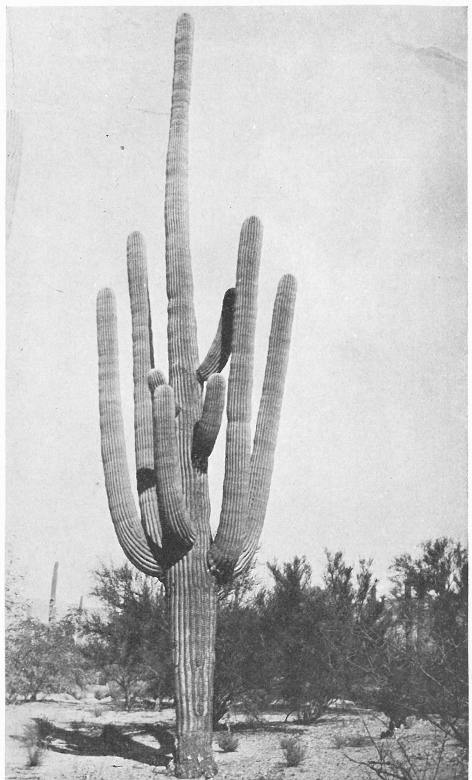
GIANT CACTUS OR SAHUARO (Cereus giganteus)
Steadfast, pillarlike, towering fifty feet into the air, he gives a sense of power to all who behold him, some certain realization of the grandeur and mystery of God’s creations here on earth.
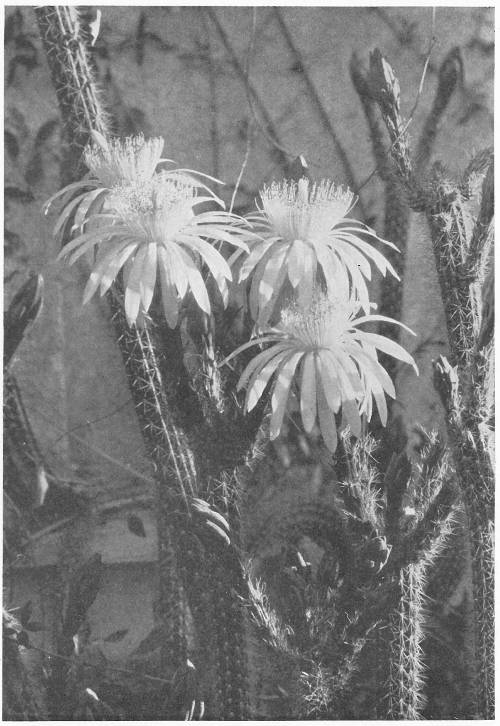
MEXICAN NIGHT BLOOMING CEREUS; SERPENT CACTUS; REINA DE NOCHE (Cereus serpentinus)
A weird striking growth, any one of its long sinuous tentacles, the six to fifteen entangled stems, might easily remind one of the twisted body of a serpent springing at its intended victim.
Cholla never relinquishes his right to land that he has acquired, for when he dies of old age or even before that, a host of young Cane Cacti, his children, spring up to take his place. Thus it is that the Cholla prospers and multiplies in the face of adversity, and even the hand of man cannot stay his progress.
Cholla and Prickly Pears have advanced farther north in the great cactus invasion from Mexico than any other group of cacti, and Prickly Pears have extended farther north than Cholla. Vast areas in Colorado, Kansas, Nebraska, and even South Dakota are grown over with Prickly Pears; some of these species have spread east to the Atlantic Ocean and northward far into Canada, and it is said of one small species that it has penetrated to within a short distance of the Arctic Circle.
From Los Angeles during the early part of June we start on yet another trek over the California-Arizona desert. Have our long travel across the great amphitheater of the sun through trackless wastes of torrid heat and blazing rays of [126] sunlight, our parched throats and fierce thirst for cool clear springs of water, been worth our while, in the joy of new and surprising finds, in the marvelous thrills, the awe and admiration of beauty unsurpassed, in the wonderful changing kaleidoscope of the brilliant painted desert? It must be that we adjudge the majesty of the grand old mountains and deep cañon recesses, the lure of fantastic growth and wonderful flower creations, the magical charm of the desert which never stops its calling—the call that brings you back—as balancing the scales and tipping them just far enough to bring us back again for further exploration in the fantastic realm of cactus land. And so we travel along.
Southern California
The first member of the dangerous Cholla clan to greet us is the California Cholla, growing in the interior arid valleys of Southern California, seeking the gravelly or rocky soils of mesa and cañon, and thriving along the lower mountain levels. It is named in honor of Dr. C. C. Parry who first collected it in 1851. The sharp stout thorns, a half-inch to an inch or so long, yellow mellowing to brown with age and covered with thin light yellow sheaths, appear in thick spreading clusters over this two- to four-foot plant, forming an impenetrable defense against animal or humankind. We also note the dense semicircular mass of light-colored spicules, a sixteenth- to an eighth-inch long, near the top of the areola. The flowers, which have long since disappeared, are generally yellow-green suffused with pink above, and the petals are nearly an inch long, golden with light red tips. The fruit becomes dry after ripening, and like many a [127] Cholla fruit remains green upon the plant for a year or even longer.
Southern California, Arizona, Texas, and Northern Mexico
The Desert Christmas Cactus is a flaming Cholla shrub with its mass of bright red fruit in winter a brilliant sight on the desert. The sprays of ripe fruit, sometimes used for Christmas decoration, would undoubtedly be in great demand were it not for the many fine reddish brown spicules which dry and in falling become lodged in the clothing and flesh. One of the writers has seen bushes on the desert several feet in height, as one solid mass of brilliant carmine in winter, and some of the ripe fruit stays on the plants practically all the time. A very peculiar phenomenon has been observed from time to time: a fruit or short branch will sometimes appear growing directly out of another fruit on this fantastic Opuntia leptocaulis, and thus Nature impregnates her seeming freaks of fancy in thoughtful system and design upon these strange Cactaceæ. This miniature fortress, leptocaulis, is covered with sheathed Cholla thorns which are sharp and pointed, tan with translucent yellow tips and loose whitish sheaths. The inch-long flowers are pale yellowish or greenish yellow, and these lazy blossoms have a bad habit of opening their greenish yellow eyes at three o’clock in the afternoon, then closing their petals towards evening.
Southern California, Western and Central Arizona, Southern Utah, Northern Mexico, and Southern Nevada
Fierce and thorny cacti are Opuntia acanthocarpa, sometimes appearing on the broad desert land as dwarf trees four to six feet tall, again growing as densely spiny shrubs, impregnable fortresses defying man and beast. Over the arid sandy or gravelly soils of the southwestern desert, this fierce Cholla has fought his way and proved his right to existence, asking nothing from the hand of man and having little to give. Yet we cannot help admiring his sturdy race, their courage and their challenge, standing up to man and even laying down the law in some instances where they have spread over the ranges, elbowing in unwanted and unasked, never relinquishing to mankind their right to land they have once acquired. “Buckhorn Cholla” is surely a good name for this aggressive fellow. He has two dozen or so sharp red-brown thorns only partly sheathed, greenish yellow blossoms a couple of inches long, tipped with light red and suffused with purplish tints, extremely spiny fruit which become dry at maturity when they fall to the ground. The stems have each a woody core or cylinder from which cactus canes are made to some extent, but the species has no economic use and is regarded as worthless on the range.
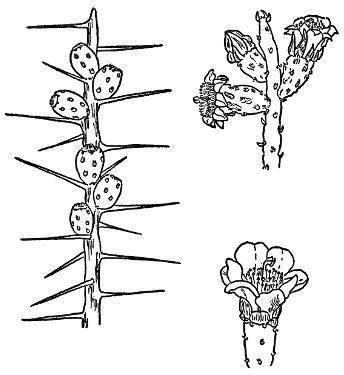
DESERT CHRISTMAS CACTUS; TASAJILLO (Opuntia leptocaulis)
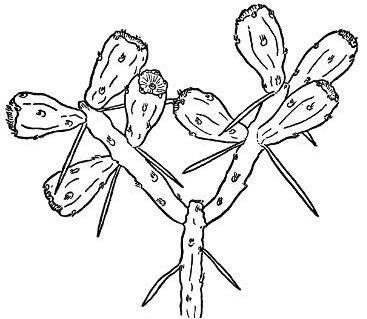
PROLIFIC TREE CHOLLA (Opuntia arbuscula)
Southern and Western Arizona, Northern Sonora, Lower California, and Southern Nevada
We are approaching one of the hottest parts of the California deserts, Death Valley, in search of perhaps the spiniest and most dangerous of all the Cholla, the Golden Spined Jumping Cholla. Four to eight feet tall, with numerous stout fantastic arms seemingly pointed at each tenderfoot tourist hurrying across the desert, like unholy messengers of evil omen, this remarkable cactus is very conspicuous in its rocky habitats. It grows luxuriantly in all the hottest locations on our American desert, Coachella and Imperial valleys in Southern California, southwestern Arizona, as well as here before us in the sweltering heat of that great cañon so aptly designated as our “Death Valley” of the Southland. With [130] his dense armor of interlocking thorns Bigelovii is immune to grazing animals or rodents, nor is he injured by the extreme heat or light of the hottest desert lands; all the spines, an inch and a half long or longer, are light golden-yellow, glistening in the brilliant sunlight of cactus land and easily recognized from afar. Loose, papery, straw-colored sheaths cover them and the stout sharp thorns are nearly always broken off in a strong wind, or with the slightest disturbance, and stick to one’s clothing as readily as burrs; then once they get lodged in the flesh are difficult and exceedingly painful to extract. They form a golden shield for the lovely blossoms, an inch or more in length, pale green or yellow-green suffused with tints of purple. This member of the Cholla clan reproduces himself very readily, for the loosely attached young joints, falling to the ground, take root and grow into new young plants. The Golden Spined Jumping Cholla and also the common Jumping Cholla are sanctuaries where the desert wren can build her nest and rear her young undisturbed among the thorns; there, too, the chuckwalla, a large lizard, can rest in peace, safe from attack of animal enemy and protected from the burning heat and fierce desert winds that sometimes sweep across the mesas and down the mountain cañons, in the great amphitheater of the sun.
Western and Southern Arizona and Northern Mexico
A spectrum of coloring is Opuntia versicolor, with green or dull purple joints, green-yellow, red, purple, or deep maroon blossoms, not so very showy but a maze of tints and hues. The countless flowers give the landscape a rich tone in April and May, and the plants in their armament of mottled spines, brown, gray, and purple, are a picturesque sight at any season. The stems grow six to twelve feet tall, with a trunk two or three feet high from which appear many fantastic arms intricately branched to form a broad rounded head, five to ten feet across. This dwarf tree is adequately protected from the hot sun and animal marauder by sharp sheathed thorns about a half-inch long, encasing its entire body in an impenetrable suit of armor far more effective than any coat of mail donned by warrior of old. The flowers cluster at the tips of the brightly colored joints, which are two to ten inches long; the small fruit remain green on the plant for about a year. Versicolor is a good name for this bright Cholla since it means “variegated or diversified in color.”
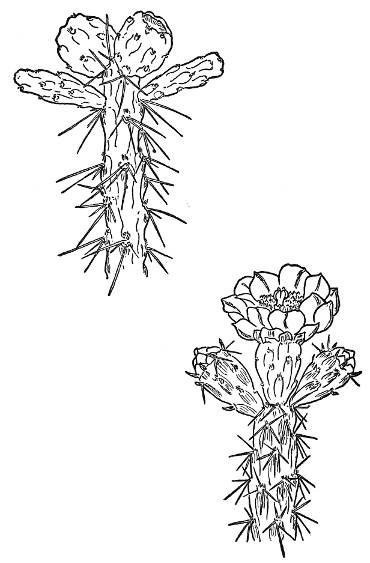
MANY COLORED TREE CHOLLA (Opuntia versicolor)
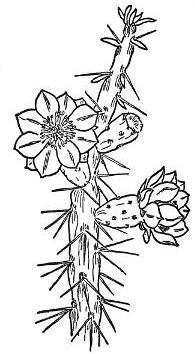
POPULAR CHOLLA (Opuntia tetracantha)
Southern Arizona
This slender little Cholla is interesting because of its inch-long purple-brown and yellow flowers, unfolding once in the afternoon, then closing at night never to open again. Many of them seem to sulk on their heavy moisture-laden stems during the hot dry hours of the desert day, and then swiftly to unfold themselves and parade in evanescent beauty when the long shadows of a departing day begin to paint the mountain slopes, bidding the day to hurry and beckoning night to approach for the fashion show of the desert flowers. Tetracantha is a very popular addition to a cactus garden, and many are the tourists who carry one or more of these smallest of the Cholla back to their homes to preserve as relics from the land of the burning sun. The bloom, yellow-green suffused with purple, reminds one of a small old-fashioned dahlia; May and June is blossoming time, and only a few minutes is required for a flower to open in full. A rare and attractive species is this matchless little beauty, spreading over the sandy desert mesas and in gravelly or rocky foothills in southern Arizona. The name tetracantha alludes to the four reddish brown thorns enclosed in loose straw-colored sheaths.
Southern Arizona
This Cholla in southern Arizona is considered very valuable as stock feed in time of drought. Arbuscula (the name means “a small tree”) will produce from sixty to seventy pounds of fruit in a season from one single tree, this fruit remaining on the plant in good condition for over two years; in fact if the trees are not grazed annually they break down under their enormous loads of fruit. Like others of this fantastic genus, the fruit upon falling to the ground develop roots and grow into new plants; almost like the earthworm in this habit, which if cut in two reproduces itself again and again. Blossoms, also, are produced from the ends of this prolific fruit of last season’s growth, and the green and yellow and red blooms grow, too, in dense clusters at the tips of the gray-green joints. There is another color combination to be seen in April or May when these glossy flowers come forth into bloom, red-brown and orange-brown sepals and petals appearing on bright green joints. The Papago Indians prepare a most palatable salad from the young flower-buds of this Cane Cactus. The unopened buds are gathered and plunged into hot water for a few minutes, allowed to dry in the sun and stored in ollas until winter; then they are shaken in a sack or stirred briskly in a pan to dislodge the fine spicules, cooked, and served with dressing, a tasty dish served to the many tourists who travel across the desert during vacation and pleasure time, in search of the various new and interesting plant creations to be found in this fantastic cactus land.
Southern Arizona
Opuntia Thornberi is quite distinct among Cane Cacti in having long tubercles and long angular joints, the latter a [134] foot to two feet in length. Two to four feet tall, this Cholla covers the arid, sandy, or gravelly and rocky soils along the foothills and broad desert mesas in south central Arizona, a striking characteristic shrub, his fantastic arms irregularly whorled and appearing angular because of the long, prominent tubercles; the tri-colored flowers, yellow and green and purple-red, nearly three inches in length, receive boundless protection from the sharp sheathed thorns encircled with bright bands of yellow-brown and tan. Though so beautifully mottled, these are spines of which to beware. For so cruel are the spikes of Cholla and so painful the process of removing them from the flesh, if one is unfortunate enough to become entangled in their meshes, that medical advice is to leave the thorns in hand or body and allow them gradually to work their way out, rather than to risk laceration by extraction. Opuntia Thornberi has been described only very recently; it is named in honor of Professor J. J. Thornber, botanist of the University of Arizona and one of the authors of this book, for his outstanding work on desert plants and flowers.
Northern Mexico, New Mexico, and Southern Arizona
We go south into the rocky foothills and bajadas of Northern Mexico, then up to altitudes from three to five thousand feet to find this brilliant and beautiful cactus, the Spiny Cholla, called also Tasajo by the natives; and given the specific title of spinosior, meaning “more spiny.” Six to fifteen feet, spinosior towers into the air, crowned by a brilliant rainbow of color, the large lovely blooms, almost three inches long and nearly as wide, clustering around the tips of his thorny arms, bright harmonies of white, orange, red, copper color, maroon, and shadings of purple, brown, pink, with tints of lavender and brownish purple, a glorious color combination among these largest of the Cholla blossoms, blooming all through May and occasionally a month earlier; and replaced in July by the light yellow fruit, which remains on the trees for a year or even longer.
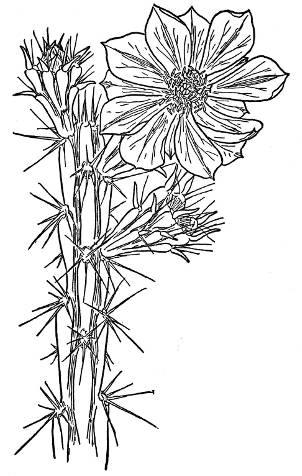
THORNBER’S CHOLLA (Opuntia Thornberi)
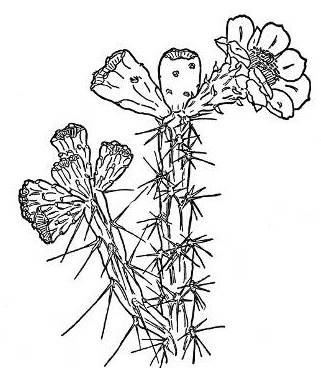
MANY COLORED TREE CHOLLA (Opuntia versicolor)
Northern Mexico and Southern Arizona
Along the highway in Northern Mexico here and there dwarf trees appear, five to fifteen feet high, with stout woody trunks branching quite near their bases into many spreading candelabralike arms, covered with striking rose-purple bloom. A handsome tree Cholla, Opuntia fulgida is called also the “Jumping Cholla” from the sharp spiny joints which are very loosely attached, so that one can scarcely walk among the plants without some of the joints “jumping forth” as it were and becoming attached to the clothing; a strong wind will carry them, too, for some distance or the least disturbance will dislodge them, and woe to the human or animal caught by these cruel thorns; difficulty and extreme pain are experienced in extracting a spine from the flesh, and it leaves its mark behind, a wound which turns blackish and later a sickly greenish hue. The pear-shaped young fruit and also flowers grow from the tips of old fruit! thus forming broomlike growths or chains of ten to fifteen fruit which remain on the plants for several years unchanged, sometimes weighing two or three hundred pounds. Fruit that fall to the ground grow into new plants, as do the spiny joints.
The Jumping Cholla are among the most abundant and characteristic Cane Cacti on the ranges of southern Arizona, often excluding all other growth and spreading rapidly over the broad grazing grounds. They are a beautiful sight on the desert with their translucent white spines covered with loose silvery sheaths glistening in the bright sunshine, and a sight that will not easily be forgotten. The plants blossom from June to September and in Mexico are known as “Vela de Cojote” because of the shining spines; in the noonday rays of the sun at a distance of a mile or more, a forest of these plants on a hot day resembles a wavering, glistening white sheet of light, because of the tremendous heat vibrations of the vertical rays of the sun.
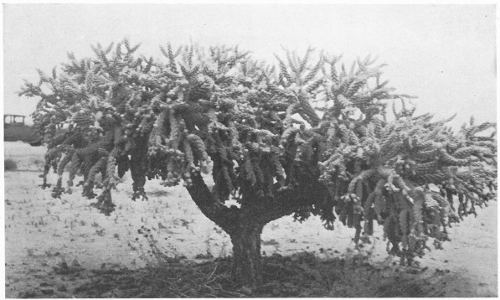
JUMPING CHOLLA (Opuntia fulgida)
One can scarcely walk among these plants without some of the joints “jumping forth” as it were and becoming attached to the clothing; a strong wind will dislodge them, and woe to the human or animal caught by these cruel thorns.
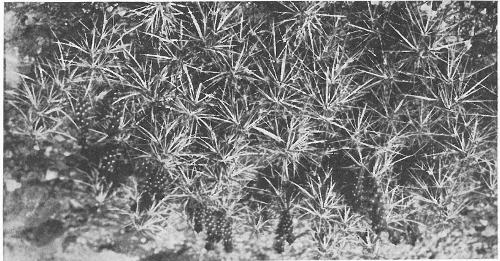
CURSED CHOLLA; DEVIL CACTUS (Opuntia Stanlyi)
A creeping crawling mass of rough hairy spines and sheaths, stout sharp swords, dangerous and effective in harshly repulsing advance of animal or ignorant human, is the Devil Cactus or Cursed Cholla, a veritable fortress on the desert.
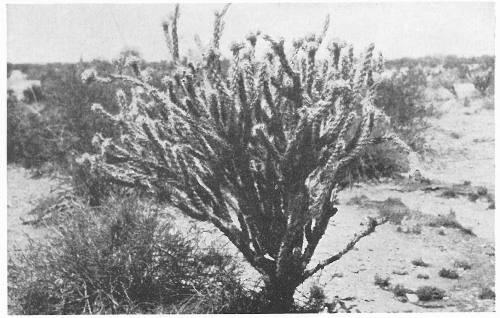
BUCKHORN CHOLLA (Opuntia acanthocarpa)
Over the arid sandy or gravelly soils of the southwestern desert, this fierce Cholla has fought his way and proved his right to existence, asking nothing from the hand of man and having little to give.
Northern Mexico, Southern Arizona, and New Mexico
Prostrate stems worming their way in impenetrable patches of six to twelve feet across the sandy soils of southern Arizona and Northern Mexico, a creeping, crawling mass of rough hairy spines and sheaths, stout sharp swords dangerous and effective in harshly repulsing advance of animal or ignorant human, is the Devil Cactus or Cursed Cholla, a veritable fortress on the desert. A welcome retreat for small rodents, snakes, and lizards, this terrible growth, Opuntia Stanlyi, is an object of fear to man and beast alike! spreading over the grazing lands and creating impenetrable areas dangerous and worthless for stock. One shudders when he sees the awful thing, repellent yet strangely magnetic, and generally tourists are glad to turn from it and retrace their steps to the highway.
Northern Arizona, New Mexico, Western Colorado, and Southern Utah
One more of the fierce Cholla group must claim our attention, bringing to a close our search for these cruel, relentless growths, awful to contemplate in many instances yet strangely enticing as well. It is a cultivated specimen of a low and typical Cane Cactus which grows wild in northern Arizona, New Mexico, and spreads north even into southern Utah and Colorado, thriving at altitudes from five to seven thousand feet in loamy soils of oak, juniper, and pine formations and high grassy lands. This is the “farthest north” for a Cholla to grow. One to two feet high, the shrubs form in rather pretty clumps of silvery glossy slender spines, golden flowers suffused with pink and green tinting, and purple joints on greenish stems. A characteristic cactus of more northern parts and named for Lieutenant A. W. Whipple, in charge of the Whipple Expedition of 1853 and 1854. This ends our long trek over sultry desert lands as we cross the boundary line into southeastern Arizona at the customs in Nogales, Mexico.
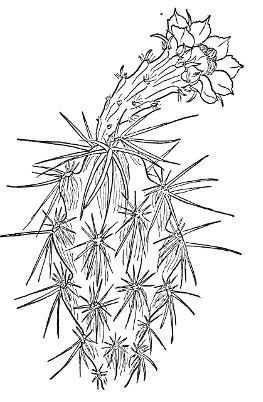
CURSED CHOLLA; DEVIL CHOLLA (Opuntia Stanlyi)
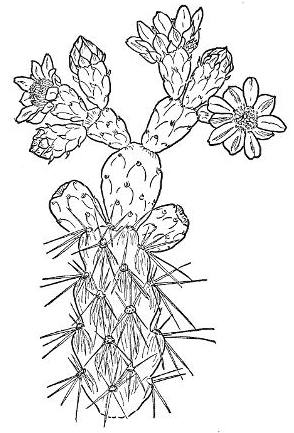
JUMPING CHOLLA (Opuntia fulgida)
And so the greeters of the desert, advance guard of the cactus invasion from Mexico, see us depart now for a time from the mysterious land of the Fantastic Clan, wherein we have learned of the charm of color, and the strange devices of Nature in her scheme of Cholla growth; and where the fierce, uninviting heat of the desert fails to keep us from entering that domain of silence where the midday sun burns all to a crisp under the relentless bombardment of its energy, which after all gives alluring beauty to the wondrous cactus flowers; and where the cooler shades of evening loose the mild zephyrs that kiss our parched brows and gently lull us to sleep at night with moonbeams playing at random among the cañon shadows, gossamerlike and eerie in the ghostly light of the stars. And once again in fancy we behold these armored Cholla, silent fortresses of the desert, looming against the mountain sides, with their beautiful rainbows of gorgeous hue blossoming forth but to fade and die, never to appear anew in their shimmering colorful sheens of glory against [140] background of sheaths and terrible thorns, the swords of the fierce Cholla group.
Then comes the dawn. Slowly the eastern rim of the landscape is bathed in soft pearly light, haloed over the mountains. The night has passed and another day is on, and we, too, have passed on and left the strange alluring land of the weird Cholla group; but the beauty we have found out there among fierce relentless growths lingers on in the background of our conscious minds, and we wonder how it came there and why it is; after all is it not part of the glory that God has given us to use and to try to understand?
The Cholla has a fierce armor of thorns, long and stout, sharp and dangerous, a group of Cholla on the mesas comprising a veritable fortress of the desert. These spines are of one kind but of different sizes, and they are sheathed. On account of their sheathed thorns the Cholla are the most dangerous of all the cactus groups, and feared most of all Cactaceæ. The spines vary from an inch or less to three inches or more in length, and occasionally are half an inch or more through. The stems of these species are cylindrical, from a foot or less to fifteen feet tall, the branches generally forming into a broad rounded head. They are not ridged or fluted, but are covered with tubercles arranged spirally. The plants are often grotesque and generally resemble dwarf trees, though typically shrubby in habit. The leaves are scalelike and soon fall off. Spicules are always present, generally half an inch or so in length, easily dislodged, so easily blown off by the wind that two species of this genus are called “Jumping Cholla.” The flowers are showy and very conspicuous, large, and of all colors of the rainbow in many instances; opening and closing on the same day and at different hours in different species, rarely appearing the second day. A peculiar phenomenon is observed: the flower buds sometimes grow out from mature fruit, thus producing chains of fruit lasting for years. The fruit varies in character and is found to be tubercled or smooth or shiny, but always bearing the customary spicules. It is sometimes dry, sometimes fleshy, often remaining unchanged and edible for several years on the plants. Another curious fact is that the fruits of many species when planted in soft moist soil, or even falling to the ground, develop roots and grow into new plants, the seeds within remaining viable and capable of growth later on.
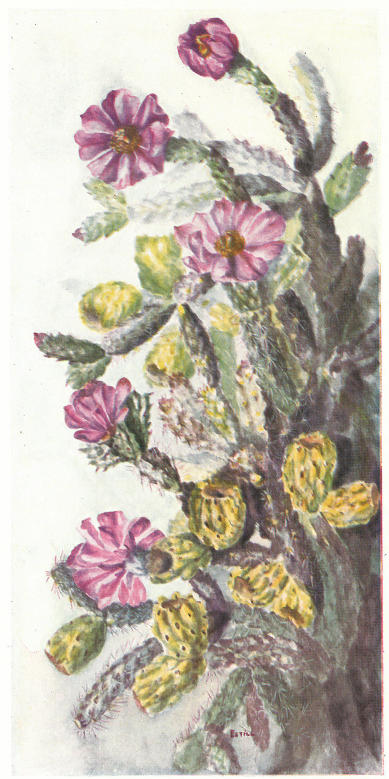
SPINY TREE CHOLLA (Opuntia spinosior)
Most species grow readily from cuttings of one to several joints set a few inches deep in sandy soil and given enough water to keep the soil moist; it is better to allow the cut surfaces time to dry before planting. Plants can be grown also from seed planted a half-inch deep in sandy soil out of doors or in flats, with part shade and watered enough to keep the soil moist but not wet. Also, the fruits of many species when planted in moist soil develop roots and grow into plants. Cuttings or plants grow indoors or outside. A south exposure is preferable.
(Named in honor of Dr. C. C. Parry, who first collected it in 1851)
The California Cholla is a very interesting and fascinating plant and grows as several stems two to four feet tall, [142] branching from the base and quite erect. These stems are cylindrical yellow-green joints six to twenty-four inches long and an inch thick. They bear the usual cactuslike spicules and spines. The spicules are a light yellow semicircular mass, while the five to twenty sharp, slender needlelike spines are crowded together, a half-inch to an inch long in many instances. These are yellow but turn brown with age and have thin light yellow sheaths. The flowers are yellow tinged with red and are an inch or more in diameter and length. The fruit is tubercled and very spiny, less than an inch long, and has the peculiar characteristic of becoming quite dry when ripe. This Cholla grows best in gravelly or rocky soils in the hot interior valleys of Southern California.
Though not very attractive, this Cholla is occasionally grown in cactus collections because of its rather fascinating and peculiar characteristics noted above. Young plants may be transplanted at any season; also the species can be grown from cuttings and planted in the spring in moist soil. The plants thrive in sandy or gravelly soil and may be given a light irrigation once a month during droughty periods; they grow inside or outdoors and are not injured by temperatures twenty degrees below freezing.
Leptocaulis, or the Desert Christmas Cactus, is a plant growing as a dense low shrub only a foot high in many instances with numerous stems or joints ascending from the base, and in clumps three or four feet across. The little joints are sometimes only an inch long, growing to four [143] inches in many cases, and are gray-green covered by numerous brown spicules forming in bundles. One sharp, slender, flattened, bent spine is present, a half-inch to two inches long, with a tan body and a yellow tip, covered with a white sheath which soon falls off. The flowers are a pale yellow and quite small, while the fruit forms in clusters near the ends of the branches, elliptical, about one inch long and scarlet. A fantastic phenomenon is sometimes noticed in this species: that of a branch growing directly out from a fruit.
Transplant at any season. Joints broken off and partly covered with soil grow at once into new plants. Young plants also grow quite easily from seed, and ripe fruit can be gathered from the plant almost the year round. The plant has a very wide distribution, grown indoors and out of doors in almost any kind of soil with no care except to water monthly during dry periods. It is not injured by temperatures as low as zero, and with protection in winter can be grown in much colder climates.
(Named acanthocarpa from its very spiny fruit)
The Buckhorn Cholla is a dwarf tree or shrub composed of many stems ascending from the base and forming into a compact head of dangerously thorny branches, very woody in appearance. These branches or joints are four inches or more in length, cylindrical and yellow-green. They are tubercled and have a fringe of yellowish or red-brown spicules, very short and sharp, and many loose clusters of fierce red-brown thorns about an inch long, partly sheathed. The flowers are two inches or more in length, greenish yellow with [144] the tips suffused with red. The fruit is pear-shaped and very thorny, and has the peculiarity noted quite often among Cholla of becoming dry when fully ripe. This species bears its fruit in June and July.
Young plants grow readily if set out in the spring in rocky or gravelly soil with occasional watering to moisten the soil until the plants become established. Cuttings grow quite easily if planted in spring, and also the plant can be grown from seed sown in sandy soil in pots or flats. This species is not injured by a temperature of twenty degrees below freezing and grows readily outside or indoors.
(Named for Dr. J. M. Bigelow, an early enthusiastic student of southwestern botany)
The Golden Spined Jumping Cholla, or Teddy Bear Cactus, is a very conspicuous and attractive plant among the Cholla species, and is the spiniest of all this clan, growing as high as twelve feet, and with a very tough stout main trunk sometimes eight feet tall and three or four inches in diameter, from which appear numerous ascending branches forming a dense rounded head. The joints or branches are three to six inches long and are yellow-green. There is a dense armor of light golden-yellow spines, dark at their tips, eleven to fifteen of them interlocking, an inch of more in length and covered with paperlike sheaths which are somewhat loosely placed. The spicules are straw-colored and appear in the form of bundles. The flowers of this Cholla are borne at the tips of the joints and are pale green suffused with purple. [145] The fruit is covered with tubercles or knobs and is yellowish green. This plant grows best in the most arid parts of the Southwest and in the hottest southern exposures of rocky foothills and slopes.
Young plants may be transplanted at any season, or joints may be planted in gravelly rocky soils. The plants should be watered once a month during the growing season until well established, after that less frequently. They will grow indoors and out, and are not injured by a temperature of twenty degrees below freezing. With colder temperatures they require protection.
(Named from the many colors of its joints and flowers)
The Many Colored Tree Cholla, or Opuntia versicolor, grows as a main trunk two or three feet high, with many ascending intricate branches which form a broad rounded head from five to ten feet across at the widest part and six to twelve feet high. The bark is coarse and fissured, gray or tan, latterly scaling off. The joints or branches are from two to ten inches long, are green or brown and tubercled. The spicules form in a flattened mass and are yellow or brown. The spines, five to fifteen, are awl-shaped and about three-fourths of an inch long with brownish bases. The body is of gray-brown or purplish hues covered with close-fitting thin light yellowish sheaths. The flowers form in clusters at the tips of the joints and are a yellow-green suffused with red, pink, orange, or sometimes a deep maroon. The fruit is also yellowish green suffused with purple and is pear-shaped. Sometimes one fruit is found growing out from the [146] end of another on this fantastic growth, all fruit remaining on the plant for a year or longer.
Plants may be transplanted at any season, or joints may be planted in gravelly rocky soils. The plants should be watered once a month during the growing season until well established, after that less frequently. They will grow indoors and out and are not injured by a temperature of twenty degrees below freezing. With colder temperatures they require protection.
(Named tetracantha from the four spines commonly present)
The Popular Cholla is a loose irregular growth about four feet tall with several stems coming from the base, but not jointed. The brownish spicules are formed in bundles. There are from one to four spines, all less than an inch long, slender and stiff and brownish or light brownish gray, with one spine longer and stouter than the others, and covered with thin straw-colored sheaths. The flowers are of a pale yellow-green suffused with purplish tints, and open in the afternoon. The fruit is about one inch long and smooth, elliptical, and orange-red.
This species may be transplanted at any season, or cuttings may be planted early in spring, in sandy or gravelly soil and watered monthly with light irrigation. The cuttings are less certain to grow. Plants grow also quite readily from seed. They are not injured by twenty-five degrees of frost and grow [147] outdoors or in; in colder weather than this they should be given protection outside.
(The name arbuscula means “a small tree”)
Arbuscula, or the Prolific Tree Cholla, grows from three to eight feet tall and has a short stout trunk three to six inches in diameter. There are several branches which are intricately arranged, forming a rounded head from six to ten feet across; the gray-brown bark is coarse and fissured. The branch-joints are from two to ten inches long or longer, and are bright green. The light brownish spicules form as a small tuft. Usually only one or two spines are present, sometimes none at all, less than two inches long when they occur, bent, slender, needlelike, and a dull straw or brown. The thorns are covered with thin, amber, or brownish, loose, translucent sheaths. The flowers are a greenish yellow suffused with red and appear in dense clusters at the tips of the joints; they are produced at the ends of last year’s fruit. This often forms a chainlike cycle. The fruit is bright green and nearly smooth. This dwarf tree or shrub grows in the sandy desert areas and flood plains of southern Arizona and adjacent Mexico.
This cactus spreads from the roots. Young plants may be planted at any season, or branches consisting of several joints maybe planted early in spring; from these, plants grow readily. Also the fleshy fruit develop roots and grow into plants. They thrive best in heavy clay loam with light irrigation once a month until well established. They are not injured by a temperature of twenty-five degrees below freezing and grow both outdoors and in; but with zero weather they require protection.
(Named in honor of Professor J. J. Thornber, botanist of the University of Arizona and one of the authors of this book)
Thornber’s Cholla is a shrub growing from two to four feet tall, with fantastic branches irregularly whorled and long angular joints six to twenty-four inches in length and yellowish green. It appears waxy, is densely covered with long tubercles or knobs, and has short light-colored spicules. The spines are three to twelve, one-quarter inch or less in length, and very sharp. They are covered with thin straw-colored or brownish yellow sheaths. The flowers of this Cholla are of yellowish and red shadings, appearing mostly at the tips of the branches. The fruit is quite dry when matured and is distinctly tubercled.
Young plants may be set out at any season, also cuttings in spring; they thrive best in rocky or gravelly soil, watered once a month until the plants are established. They grow outdoors or indoors and are not injured by twenty-five degrees of freezing; but at zero they need protection.
(The name spinosior means “more spiny,” referring to the many spines of the joints of this species)
The Spiny Tree Cholla grows to a height of fifteen feet and has a woody trunk several feet long with ascending [149] branches forming into a broad irregular open head, and with tubercled joints three to nine inches long, which are set in spiral rows. They are gray-green suffused with yellow and purple. The straw-colored spicules are formed in bundles, while the six to fifteen spines are gray suffused with pink or brown; this produces a characteristic grayish pink coloring. These thorns are covered with thin yellowish sheaths. The flowers are very showy and appear in abundance at the tips of the joints, which are three to nine inches in length. The fruit is light yellow, broadly elliptical, tubercled and firm, with thick walls, and it remains on the plant for a year or longer. This Cholla grows in the rocky foothills and bajadas and in the sandy desert areas of the southern part of New Mexico and Arizona at fifteen hundred to five thousand feet.
Set out young plants at any season or plant cuttings in spring in sandy or gravelly clay soil and water once a month to keep the soil slightly moist until the plants are well established. They grow very easily from cuttings. This Cholla is not injured by zero temperature and grows well outdoors or in the house; but with temperatures below zero it requires protection.
(Named fulgida from the silvery sheathed spines, which glisten in the strong desert sunlight)
The Jumping Cholla is a handsome dwarf tree growing as high as fifteen feet, deeply fissured, with a stout woody trunk as much as four feet long, and with candelabralike branches of blackish or brownish bark. These branches form the broadly rounded head of the tree. The joints are [150] three to six inches long, succulent and easily broken off, and covered with tubercles in a spiral arrangement. The spicules are white and are formed in tufts, while the spines, seven to thirteen, are usually bent and less than two inches long. They are slender and needlelike with loose papery sheaths, silvery-white and glistening, giving the species its specific name. The flowers are of a bright rose-purple with yellow and pinkish tinges. The fruit is pear-shaped and green. It will be noted that both the fruit and the flowers grow out from the tips of old fruit, thus forming chains of ten to fifteen fruit. The Jumping Cholla grows well in sandy or gravelly clay soils in the low rocky foothills of southern Arizona and Northern Mexico.
Plants can be transplanted at any season, or the joints or even fruit may be planted or laid on the surface of the ground, covered partly with soil and watered occasionally, whereupon they grow into new plants, making a few inches’ growth the first season. Plants grow best in clay or gravelly clay soil and may be given light irrigation monthly until well established. They are not injured by temperatures of twenty or twenty-five degrees below freezing, and grow indoors and out; in zero weather they require protection.
(Named for J. M. Stanly, artist of the Mexican Boundary Survey)
The Cursed Cholla, or Devil Cholla, is very appropriately named. Plants grow with prostrate and creeping stems, forming impenetrable masses several feet across. The stems are from a common center with the tips ascending, and the [151] joints, which are as much as six inches long, are club-shaped and tubercled. The spines are very numerous and stout, also very sharp and swordlike, and will cause grief unless one is very careful. They grow a little more than two inches long, are a light yellow, and have short sheaths over their tips. The flowers are about three inches long and are yellow, and the fruit, which is club-shaped and about three inches long, is covered with white cottony hairs and needlelike spicules. These plants grow in the sandy soils of the desert areas of southern New Mexico and southern Arizona and adjacent old Mexico.
Either prostrate rooted stems or joints planted at any season grow into plants. The seed sown in moist sandy soil grow easily. The plants grow in sandy or gravelly clay soils and should be watered monthly until well established. Temperatures as low as zero do not injure the plants, but with lower temperatures they should be protected. They grow outdoors or indoors.
(Named after Lieutenant Whipple, in charge of the Whipple Expedition of 1853 and 1854)
Whipple’s Cholla grows farther north than any other species of Cholla, and reaches three feet in height, composed of several stems that form a low compact clump. The joints are two to ten inches long, are a light green suffused with purple, and are covered with tubercles arranged in spirals. The tan spicules are very short, about an eighth of an inch long and appear in tufts. The two to five spines are a half-inch to an inch long, one of them longer than the others. [152] The thorns have yellowish tips and light red-brown bodies covered with loose papery sheaths of a silvery sheen. The beautiful yellow flowers are very showy, about two inches long, appearing from April to June; the fruit is about two inches long with prominent tubercles. Whipplei grows in northern Arizona, southern Utah, New Mexico, and western Colorado, and will be found in loamy, gravelly soils in oak, juniper, pine, and prairie-grass lands between altitudes of five and seven thousand feet.
Transplant rooted plants at any season. Cuttings or joints may be planted in the spring in sandy or clay loam, and given enough water to keep the soil moderately moist. This Cholla endures weather twenty-five degrees below zero without, injury and hence may be grown in cactus gardens over a large part of our country both out of doors and in the house. It is an attractive cactus and well worth cultivation.
In the blue ending of a desert day with the sun in the setting and the somber shadows creeping over the desert hills and down into the lowlands and swales, we would if we could build a dream-city story of a ghostly desert village, spectral and silent and lonely with only the dismal howl of the coyote to punctuate our tale. Since we are on a trek into the forbidden land of thorns and spikes and spines, we have but to add the Song of the Desert and the setting of our story is complete.
It is near the sunset time, when the cooling of the desert wind begins and we can view the horizon pierced by the distant mountains and perhaps the many trees on the mountain slopes, while out on the mesas and down in the valleys Nature has painted the floor of the desert with lacework of many kinds of brush, filigree of strange fantastic plants, tall and shaftlike or sinuous and creepy, covered with countless spikes and thorns, armed with innumerable spines or darts; all this is the desert, hot and dry and dusty by day, delightfully cool and alluring when the sun has gone and the moonbeams flit about among the strangely weird fantastic clan. It is the beckoning call to spend the twilight in meditation and rest, and then to sleep in comfort. Here then is the amphitheater of the sun, and ere the Goddess of Night bids adieu to the day, she takes up her baton and the music of a soft desert night begins. It comes rushing in over yonder rim of mountain peaks and down through the trees with a great crescendo [154] till it reaches the mesas and valleys. Then lightly, gently, comes the fading diminuendo, dimming the tones of the desert song, faintly and sweetly with the swish of the evening zephyrs, and the land of the cacti is again at peace.
We are once more on our way to the desert land of flower mysteries and weird plant phenomena. Along the dusty highway one may notice from time to time many curious-looking mounds which seem almost like monuments standing out in the great alone, in silent eulogy to some departed world perhaps. In the hot dry heat of a desert day they are just some more of Nature’s plants and flowers, but in the dusk of the desert twilight these fantastic growths look like some immense graveyard, and we might fancy that we can even read the epitaphs on their beautiful spiny shafts. For in this fancied graveyard of the desert there are many wonders, and now we shall invade their tomblike resting place and get acquainted with still another group of the weird Fantastic Clan. This is the Visnaga Cactus or Bisnaga, meaning “barrel,” commonly known as the Barrel Cactus, friend of the Indian or the lost traveler on the desert. Science gives him the name Echinocactus (derived from the Greek echinos, “hedgehog,” and kaktos, a kind of spiny plant) followed by some less pretentious appendage to denote his species.
The genus Echinocactus is thought to have originated on the great arid plateaus of Mexico and to have extended northward to the southwestern borders of the United States, where as many as forty species are known to grow. The group is a large one, including as many as one hundred forty species in the two countries where they are most abundant. There are no varieties in Central America, but a number in [155] the driest parts of South America, thriving always in the gravelly or stony soils along the foothills and bajadas and out on the broad desert mesas. The plants are globular or cylindric and strongly ribbed with sharp stout thorns, suggesting at once a barrel in size and shape, with its numerous nails protruding from the circular staves. They grow singly or in groups of two to four or more, from a foot to three or four feet in height, sometimes reaching nine feet. The central spines are the strongest and stoutest, usually one or more hooked, the radial spines also stout; the radial bristles or threads if present are at times rather firm and sometimes quite weak in texture. The Echinocacti have no spines on the ovaries or fruit—a characteristic which differentiates them from the Echinocereus Cactus.
In this great field of Bisnaga, the Barrel Cacti, or Visnagita, the little fellows, we have selected about fifteen typical species although there are many other varieties. It is early in the morning of a hot June day in southeastern Arizona that we start on our sixth and last trek across the desert, armed with notebooks and other paraphernalia of the student or tourist, having selected our locale late the preceding day.
Southeastern Arizona, Southwestern Texas, and Northern Mexico
Echinocactus intertextus, the Interlacing Spine Cactus, signals our attention first, a rare and brightly flowered little fellow. It is interesting to note that the name intertextus refers to the numerous radial interlacing spines covering this Visnagita in two or three whorls, and on the older plants forming a dense lacework over the entire plant. Only an inch and a half tall in many cases, sometimes reaching the [156] height of six inches, his stems are deeply ridged in spirals a half-inch or so apart, of a dull green or yellow-green and scurfy. The thorns are stout and awl-shaped, abruptly pointed, and translucent pink-yellow with darker tips, becoming dull gray or black near the base of the plant; twenty or thirty spines radiating like the spokes of a wheel and interlocking with others, four or five centrals, dull gray with reddish brown tips. Intertextus thrives in rocky, gravelly soils at altitudes of four or five thousand feet; his bright and beautiful bloom may be glimpsed from quite a distance, light purplish flowers with yellow stamens, growing in clusters near the centers or tops of the stems. The blossoms of Echinocactus nearly always appear in a circle around the head of the plant, just above the young spine-bearing areolas, the flowers continuing to develop on the inside of the circle in areolas that are continuously forming by further growth of the plant.
Southeastern Arizona
Purple Spined Visnagita is a gayly tinted beauty which grows only in limited areas. Indeed not only is it rare and beautiful but the species is fast disappearing; indicative perhaps that Nature in her wise prescience of coming events is already taking care of the problem of overproduction. The flowers are white or flesh-color diffused with pink, most delicately shaded sometimes with a hint of lavender, and are very lovely and fragrant though they do not open fully; they come in clusters surmounting the stem, opening in the forenoon and closing in the afternoon, for four or five days in April and May. It is not strange that the deeper-tinted blossoms appear on the plants with the more brightly hued [157] spines. The latter form a dense, almost impenetrable coat over the entire plant, giving a dull rose-purple effect which can be seen unmistakably for two or three hundred feet or farther in its arid rocky habitat. Purple Spined Visnagita is much in demand by collectors, being easily recognized at a distance by the eighteen or so brightly colored thorns; because of these gayly hued spines it is one of the handsomest of all our smaller cacti, sometimes compared to that beautiful splash of color, the Rainbow Cactus, near which it is often found growing.
Southern and Western Arizona, and Sonora
The Traveler’s Friend! This name sounds rather interesting, and upon examination Echinocactus Covillei is found to merit his friendly title. If one gingerly cuts off the top of the plant, crushing the fleshy part into a pulpy mass with a handy stick, cool refreshing water is revealed, fit for drinking and sufficient for one person. This Bisnaga has proven a good friend to the desert wanderer, but it is Nature, the marvelous architect, who is our real friend, by providing an ingenious structure which enables this cactus to store water in its fleshy-ribbed stems which grow from one to five feet tall and a foot or so in diameter; thereby permitting it to thrive and blossom in the terrible heat of the desert, and during the long, long seasons of drought to save many an Indian and other desert traveler from dying of starvation or thirst out on the broad mesas in this land of blazing sunlight. Also, if you are in cactus country and should ever become lost on the desert, look for Covillei, for he always leans toward the southwest and when other signs fail you can depend upon him to guide you in the right direction. Many a lost Indian or Mexican has obtained water and directions [158] from Covillei, the Traveler’s Compass, and thus has saved his life through knowledge of desert lore, while a stranger schooled in books but lacking the wisdom which comes from long association with desert life could easily lose himself in the arid wastes, only to perish anon.
This Traveler’s Friend is a handsome fellow; the crimson and orange-red hues of the brilliant blossoms shade into the yellow and purple-red tints of the style and its branches, harmonizing with eight or nine pink and reddish spines and their translucent yellow tips, a splash of gay rainbow hues against the drab background of rocky, gravelly soil along the foothills of southern and western Arizona and out on the mesas of Northern Mexico. In old Mexico the natives still utilize this Bisnaga by making from it the delicious cactus candy which is so prized by tourists, and seized upon with delight as one of their first discoveries in the land of the cactus clan.
Southern Arizona, Northern Mexico, and Western Texas
This species grows sparingly in arid, rocky, or stony soil of slopes and hillsides from western Texas to southern Arizona and adjacent Mexico. It differs from others of its kind in the coloring of the blossoms, which are the most delicately tinted of all the cactus flowers, pale rose to deep pink suffused with lavender hues, and in the light blue-green of the stems, which are nearly a foot high and about half as wide; also in the spiny characteristics, the stout twisted, awl-shaped thorns converging toward the tip of the plant. The flowers are large for the species, two and one-half inches long or more and nearly as broad when fully open, blossoming for but one day and only in the very brightest of sunshine. Horizonthalonius looks quite like a Turk’s head when in flower, with [159] the pinkish purple tassel at the tip of his head in a dense mass of long, tangled, cream-white wool.
Southern Arizona, Northern Mexico, and Western Texas
The stems of this peculiar growth are used largely in making the highly priced cactus candy, the fleshy part sliced and soaked in water overnight, then cooked until tender in a strong sugar solution and allowed to harden and crystallize. A most tasty delicacy is produced which is sold all over the world as “cactus candy,” and so popular is this rare sweet both in the East and abroad as well as among tourists to the desert that the industry threatens to eradicate Wislizeni and several other species of the Barrel Cacti. “Nigger Head” is another designation for the Candy Barrel Cactus, since this unique desert growth with its fringe of a dozen or so needlelike bristles resembles an affrighted southern “nigger” with his hair all standing on end. The young plants are globose and the older ones cylindric, from one to seven feet tall and a foot or two in diameter; the threadlike bristles are light gray and resemble an insect’s antennæ, the four or five stout central thorns rose-pink and yellowish mottled, the lower one longest and strongly hooked, one to five inches long. Ferocactus Wislizeni or Fishhook Cactus, as this Bisnaga is also called, is one of the most striking cacti of the desert areas, and its presence always inspires considerable interest; the spines are densely fine hairy, a characteristic rarely noted among cacti.
The Candy Cactus, also, goes under the name of “Traveler’s Friend” or “Compass Cactus,” and like Covillei it invariably leans toward the southwest and will direct aright a lost traveler who is versed in desert lore and can read the signs of the land. Then too, if the top of stem or trunk is removed [160] with a sharp knife or machete and the fleshy part is crushed, or pommeled into a pulp, a considerable amount of water can be secured for drinking from this friendly cactus, which though a little saline and not very palatable is a life-saver in time of stress. Wislizeni grows well in the sandy loamy clay soils of the desert bajadas and along the foothills. The name of the species honors Dr. A. Wislizenus, who was in charge of a botanical expedition to the Southwest in 1848.
Western Arizona, Southern Utah, Southern Nevada, Southern California, Lower California, and Sonora
This species, also, is given the name “Nigger Head” because the spines and bristles are curled and bent down closely against its trunk like a “nigger’s head” with coarse curly hair. To be sure, one never has seen a negro with pink hair, but this Nigger Head Cactus has a coat of interlocking densely fine hairy spines of lovely pink and mottled rose shades, some pointing upward, some downward, some laterally, and a fringe of ten to fourteen grayish threadlike radial bristles; such an impenetrable coat affords much-needed protection against heat and cold, and hungry rodents or range animals. Echinocactus Le Contei is among the most attractive of the Barrel group with its bright roseate spines, and its deep yellow blossoms with purple-red centers, creating the impression of a purple bloom within an orange-red flower. The flowers come forth in April and May, the fruit matures in July. The plant grows nearly always on a single stem, rarely two or more in a clump, from one to seven feet tall and about eighteen inches in diameter, with twenty to twenty-four ridges encircling trunk and stems. The latter are utilized by Mexicans and Indians for the making of cactus candy.
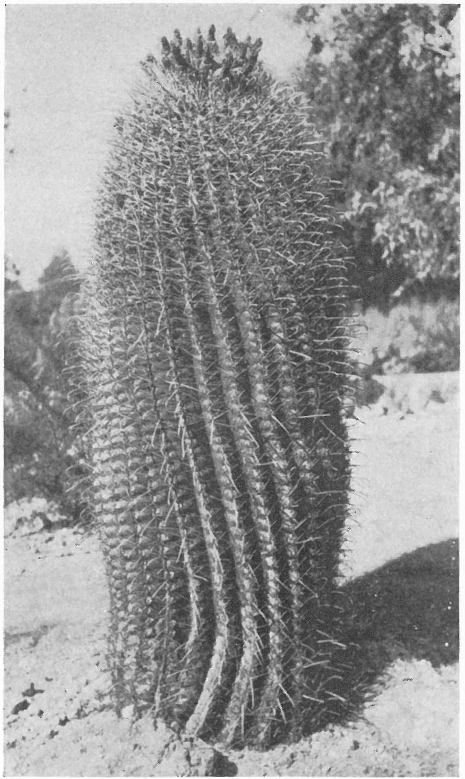
CANDY BARREL CACTUS; FISHHOOK CACTUS (Echinocactus Wislizeni)
The stems of this peculiar growth are used in making the famed “cactus candy,” the fleshy part sliced and soaked in water over night, then cooked until tender and allowed to harden and crystallize, a most delicious delicacy.
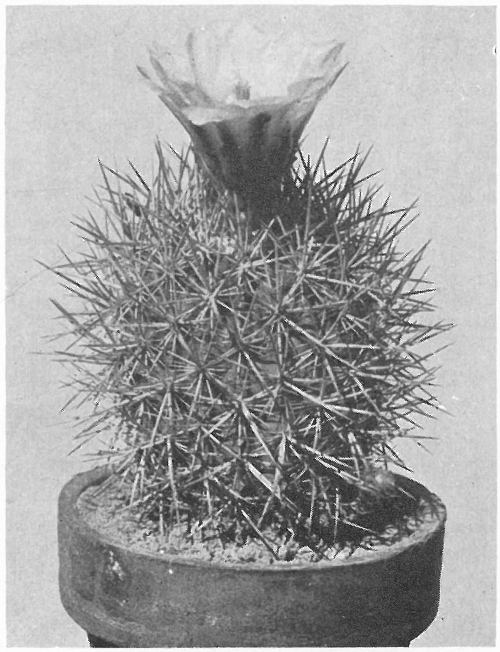
PINK FLOWERED VISNAGITA (Echinocactus Johnsonii)
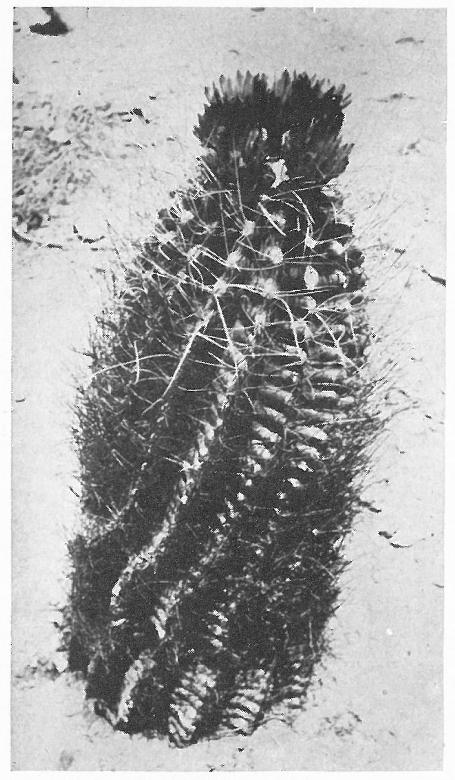
MEXICAN FRUIT CACTUS (Echinocactus hamatacanthus)
The dried fruit of this cactus, sweet and very sugary, is considered a rare delicacy by hundreds of thousands of tourists.
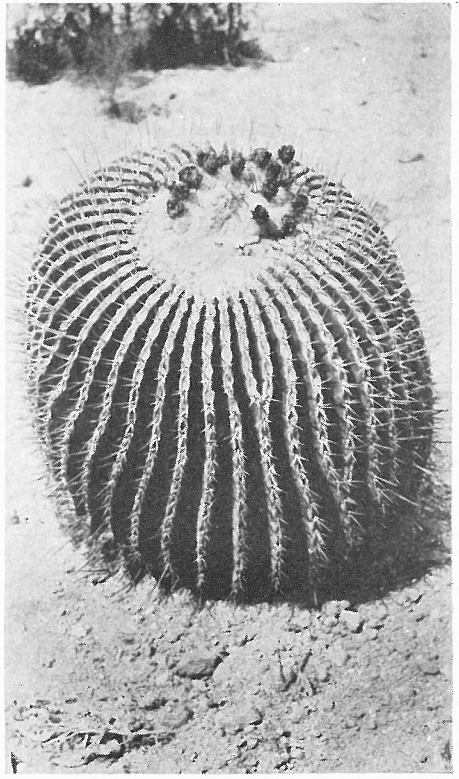
GIANT VISNAGA; GIANT BARREL CACTUS (Echinocactus Visnaga). (Baby specimen)
A monster growth, six to nine feet tall in mature specimens, three to four feet in diameter, weighing over four thousand pounds and estimated by scientists to attain the age of a thousand years!
This growth was named by scientists for Dr. John Le Conte, who discovered it in the lower Gila River country of Arizona. It is a very interesting specimen and has the following names, any and all of which seem to fit: Echinocactus Le Contei, Ferocactus Le Contei, Barrel Cactus, Nigger Head Cactus, and Candy Cactus. It prefers the arid rocky or gravelly desert lands, bajadas and foothill slopes, and seeks always the hottest exposures with very little rainfall.
Eastern California, Northwestern Arizona, Western Utah, and Southern Nevada
This very attractive and interesting Visnagita rarely grows in any abundance. It is quite outstanding because of its symphony of color radiating rose and gray and purple hues from the thorns, and the large deep pink blooms two and one-half inches long and broad, bell-shaped panicles clustering in a mass of cream-white hairs. The erect ascending spines grow straight or slightly curved, in dense layers, and sharp. Johnsonii likes the sunny exposures and seeks the arid rocky or gravelly soils. The species is named for Joseph Ellis Johnson, an amateur botanist of southern Utah.
Southeastern California, Western Arizona, and Lower California
Echinocactus Rostii, or the beautiful Golden Spined Barrel Cactus, with its bright yellow stamens and petals tinged with red, when in bloom, and the striking golden-yellow spines, [162] appears at a distance like a bundle of straw. The flowers, an inch or so long and about as broad, are borne in a circle clustering around the tops of the stems, which grow singly or in clumps of two to ten, four to nine feet high according to age; the spine clusters are about an inch apart, golden and straw-yellow suffused with pink near the bases, sometimes pink banded with the tips growing straight or curved, all spines very fine hairy. The species is named for E. P. Rost, who discovered it, and is found in a very restricted area among the arid, gravelly or rocky foothills and bajadas or mesalike mountain slopes and cañons. The plant is a striking object against the landscape in its dense spiny armament, rendered impenetrable by the beautifully mottled stout spines extending in every direction; then in April come the golden blossoms encircling the tips of the stems in a flashing aureole of light.
Southeastern California, Lower California, and Southern Nevada
The California Barrel Cactus, Echinocactus acanthodes, grows in arid, gravelly or rocky foothills and arroyos on the deserts of southeastern California in the Imperial Valley, and in northern Lower California. This species grew formerly in great abundance on the rocky, gravelly mesas of the Coachella Desert near Palm Springs, California; now, however, many of the fine large specimens have been removed, and the sticky pulp of the stems utilized for cactus candy manufacture. The name acanthodes refers to its many spines, a gray-yellow fringe of seven or eight stout needlelike bristles, and eight or nine pink and yellow banded radial [163] and central thorns one to two inches long, the lowest one sharply hooked. The plants grow nine feet tall at times, occasionally only a foot or so in height, generally with single stems seven to twelve inches in diameter according to age; the flowers are bell-shaped, blossoms of rare beauty giving a lovely golden cast to the landscape in April and May; the fruit is borne in a circle of greenish yellow suffused with purple, around the tops of the stems, and matures in July.
Southeastern California, Western Arizona, and Southern Nevada
The meaning of polyancistrus is “many fishhooks”; but why should there be fishhooks on the desert? Echinocactus polyancistrus is a very interesting and showy Visnagita growing on mesas and deserts; though widely distributed, it never appears in abundance, and is rather rare. It is densely and conspicuously spiny, covered with sharp needlelike thorns placed radially, a half-inch long or longer, dangerously hooked, spreading, and very formidable; resembling the common fishhook and far more fearful. This cactus is most conspicuous and attractive in its white shining armor of spines. The blossoms are large and showy and remain open for several days. At first rose-purple, they change to a deep crimson, while the throat of the flower is broad and covered with yellow stamens; the styles are bright red, and even the mature fruit is a brilliant red. The flowers grow in clusters from near the tops of the plants and create a splash of fiery crimson over the mesas, beautiful to behold, flaming against the dark background of mesquite and sagebrush and other desert cacti.
Southern California and Lower California
Echinocactus viridescens is a small Bisnaga growing in the vicinity of San Diego, California, and is found along the beaches there, and in the dry ridges and hills of Lower California. It gets its name from the greenish flowers and stems (viridescens is Latin for “growing green”). The stems grow a little over a foot high; the numerous stout sharp thorns are finely hairy, encircling the plants in red and yellow and rose-pink bands of coloring; while the blossoms form a bright halo of gold and purple tints around their tips, the margins of petals and sepals yellow and the thickened midribs yellow or purple-red, the whole producing a strongly greenish cast in flower and plant. The fruit can be eaten, and has a slightly acid taste like that of the common gooseberry.
Southern California, Western Arizona, Nevada, and Utah
The many-headed Barrel Cacti are composed of the older stems, a couple of feet or so in height, each surrounded by twenty to forty smaller ones, and we might give this group the name “Harem Cactus.” These many-stemmed Barrel Cacti form large hemispherical mounds three to five feet across with the largest stems or trunks in the center. Hence the suggestion of an old man and his many wives; hence also the designation “Mound Cactus.” The group thrives well on stony and gravelly hills of our hottest southwestern deserts where the rainfall is three inches or less. Clad in an impenetrable armor of silver-gray spikes and spines, banded in pink and pinkish gray zones of color and in a densely fine fuzzy growth, polycephalus blossoms in many showy attractive [165] blooms, bright yellow petals and stamens in striking contrast to the purple-red sepals and scales. The clusters of flowers are hidden among the dense masses of stout ascending or incurved spines and rarely open in full, both fruit and blossoms deriving protection against the ravages of sun and storm, rodents and other desert animals from their strong armament of thorns and spikes. This cactus is interesting because it is so different from any of its relatives.
Northern Mexico, Southern Texas, and New Mexico
This quite odd little Barrel Cactus is highly prized by the Mexicans and Indians who know it for its fine fruit, which is slender, two or three inches long, and very sweet with many dark brown seeds. The ripe fruit gradually dries, and is eaten as a sweetmeat without any sort of treatment; firm and sweet and very sugary, it is considered a rare delicacy by the hundreds of thousands of tourists who journey to the Southwest in quest of unique desert growths. It is used very largely as a food product by the natives; from the appearance of the thorns the species is named hamatacanthus (“hooked spine”). We note that the flowers are rather large, about three inches long and two inches or more across, golden or yellow suffused with red, and appear in clusters at the ends of the stems, which are generally two or three feet high; the spines harmonizing in reds, purples, and tans.
Central Mexico (Coahuila)
And here is the Mexican Lime Cactus, which is used for a refreshing drink that is similar to the well-known limeade, [166] and often called the Lemonade Cactus. A little Mexican cactus juice, some sugar and ice-water, a hot day, and you have a cool delightful drink. This species is made striking by its great size, mature plants reaching a height of nine feet, with several stems forming in clumps or growing singly, and by the light red hooked spines which give the stems a reddish coloring when seen at a distance. The blossoms are group flowers of orange-yellow, having the appearance of red on the outside and golden within, and clustering in a circle around the tops of the stems. This fine Fruit Cactus is native to the foothills and mountains of Central Mexico in the Mexican states of Coahuila and Zacatecas.
Central Mexico (San Luis Potosí)
It is late on a sultry day in June and we are speeding along the dusty highways of Central Mexico, intent on our quest for a certain queer specimen of the weird Fantastic Clan, when the long low shadows of the afternoon begin to slant over the singular cactus growths for which we have been searching, and the blue haze of a waning day is seen to gather over the distant mountains. We pause in our hurried flight across the Mexican bajadas, as a strange and lurid spectacle comes into view. It is a forest of the Giant Visnaga, greenish monsters of the desert, appearing to rise out of the ground in front of us, towering on their fantastic yellow-green bodies and leaning toward us, like some strange messengers of a departed world come back to us in this graveyard of the desert. The Giant Barrel is the cactus in search of which we have traveled all the way from Southern California to San Luis Potosí, in Central Mexico, a monster growth six to nine feet tall, three to four feet in diameter, weighing over four thousand pounds; and estimated by [167] scientists to attain the age of a thousand years! One of these Giant Bisnaga has been growing in the University of Arizona gardens for thirty-five years, is only about two feet tall and eighteen inches through, even after the lapse of a third of a century. It is in the highlands of San Luis Potosí that we have discovered this giant, just as our long hot trek is drawing to a close. We see that his trunk is single and unbranched, cylindrical, and greenish or yellow-green. The four straight sharp stout thorns are all brownish central spines; no radials are present. The flowers are bright yellow and showy, and the tops of the plants where they appear are covered with dense layers of long woolly cream-yellow hairs. The large blossoms, two and one-half inches long and as broad, come forth in early June, spreading wide open in the forenoon and closing in late afternoon.
Northern Arizona, Northern Utah, Western Colorado, and New Mexico
But one more growth of this strange cactus land must claim our attention ere the sun completes his journey across the western skies and the goddess of Evening draws the mantle of night over the land of the burning sun. It is a Bisnaga native to the foothills and high mesas of northern Arizona and Utah, western Colorado, and New Mexico, but we cannot take the time on this trip to study in northern parts. Science tells us that Whipple’s Visnagita is one of the smaller of the cactus clan and is generally to be seen peering out from under other desert shrubs. Little is known about this very interesting but tiny growth. It is far removed from all of its near relatives in distribution, and is to be found as far north as Pleasant Valley near Great Salt Lake in Utah. The ashy-white thorns are half an inch long or [168] longer, many of them dangerously recurved and hooked; its large bell-shaped blossoms form a halo of rose and purple about the tips of this diminutive cactus, quite pretty with the lavender filaments and reddish styles; the styles are finely hairy their entire length, a very rare characteristic among cacti.
And now the trek of a long desert day is done. Tired and thirsty, we jot down our notes for future study and reference, and sit down in the shade of some desert rock or hummock, to gaze out over the receding panorama before us, wondering if, after all, it doesn’t look like a great desert graveyard, the big and little Visnaga strangely enigmatic monuments of some buried past, standing by till Time shall obliterate all.
Small or large plants that are globular or cylindric and strongly ribbed with sharp stout thorns, suggesting a barrel in size and shape, from a foot to three or four feet high, sometimes reaching nine feet, growing singly or in groups of two to four or more. The central spines are the strongest, usually one or more hooked; the radial spines also are stout, the radial bristles or threads if present are somewhat firm or rather weak in texture. The ridges run lengthwise over the whole plant body, and are covered with a dense lacework of thorns which are often cross-ridged and of several kinds, forming in clusters, a network over the entire plant. This lacework of spines is rather similar to the network of thorns covering the Hedgehog Cactus. But the Echinocactus can be identified by its barrel shape. The stems are mostly simple. [169] There are no leaves nor spicules. The flowers are of medium size and are borne toward the tips of the plants, opening in the forenoon and closing in the afternoon of the same day. The blossoms persist on the mature fruit, which is shallowly tubercled, and scaly. The Echinocacti have no spines on the ovaries or fruit, which differentiates them from the Echinocereus Cacti. The stems of some species contain a fluid which, though a little saline, is palatable on the desert.
The plants are grown from seed sown a quarter- to a half-inch deep in sandy soil mixed with a small amount of powdered charcoal and leaf mold in flats or pots, in part shade and given enough water to keep the soil moist but not wet. When a half-inch high or so the seedling plants should be planted in small pots. A south exposure is preferable for growing these species. They will thrive outside or indoors.
(Named from the numerous interlacing or overlapping radial spines)
The Interlacing Spine Cactus looks very much like a flattened cylinder, growing from one and one-half to six inches high and to four inches in diameter. It has thirteen spiral ribs spaced about three-quarters of an inch apart, obtuse and sometimes rounded. The ridges of these are dull green and scurfy. The areolas are very short and crowded close together. There are from twenty to thirty radial spines, a half-inch long, which radiate much like the spokes of a wheel. All these spines are interlocking with one another [170] and incurving. The four central spines do not appear till after the plant has begun to flower; usually three turn upward while the other one grows outward. They are a dull gray suffused with red or brown, or in some instances are brownish. The flowers form in a cluster at the top of the plant and are about an inch and a half long, having light purple sepals and from eighteen to twenty petals, the latter oblanceolate with a white center that changes to light pink or purple. The style of the flower is a pale yellow-green suffused with purple. The fruit is very small and is covered with scales which are colorless. These plants grow singly in coarse gravelly or sandy soils at altitudes of four or five thousand feet, and their blossoms come forth in May.
Set out plants at any season, preferably in the spring, in sandy or gravelly clay loam in part shade and give some irrigation monthly to keep the soil moist. They may be grown from seed in sandy loam in flats with sufficient water to keep the soil moist. The flats should be in part shade. The plants grow indoors and out and are not injured by zero temperatures. In colder climates they can be grown in dry sunny conservatories or indoor rock gardens.
(Named erectocentrus from the erect central spines)
The stems of the Purple Spined Visnagita grow singly and to the height of nine inches, are conical or cylindrical, and have twenty or more ridges which are spirally arranged. The areolas are set closely together and are gray-green. There are as many as sixteen radial spines, less than an inch [171] long, which rotate like the spokes of a wheel. The central spines, of which there are only one or two, are less than one inch long and erect. All of the spines have thickened bases, are a dull light rose-purple, and are covered with a fine gray scurf. The flowers form at the tops of the stems and are about two inches in length and breadth, white suffused with pink or lavender, and have a delicate fragrance. The flower is composed of twenty petals which are oblanceolate. The fruit is quite small, less than an inch, and is oblong, yellowish green, thin-walled; it dries very soon after maturity in June. These plants thrive best in rocky or limestone ridges and slopes. They are a handsome species, and are easily seen in the distance when coming into blossom in April and May.
Transplant early in spring in rocky or gravelly soil, using care not to injure the roots and watering monthly to keep the soil moist. The seeds grow readily if planted in May or June in sandy loam in flats in part shade with enough water to keep the soil slightly moist. The plants grow indoors and out and are not injured by zero temperatures.
(Named in honor of Dr. F. V. Coville, curator of the National Herbarium, Washington, D. C.)
The Traveler’s Compass has a peculiarity which helps to identify it, usually leaning toward the southwest, and this gives it the common name. The plants grow as solitary stems to the height of about five feet and the diameter of a foot and a half. The plants are globose when young, gradually [172] becoming cylindrical and having as many as thirty ribs, two inches high and three inches apart. The rib crests are obtuse and are constricted between the areolas. There are from six to eight radial spines, an inch or two long, which are stout and straight with cross ridges, and spreading. They are gray, or dull red and pink, with the tips a translucent yellow. The central spines are much stronger than the radials, as long as three inches, extending outward and not hooked; but the tips are curved. The flowers, which are bell-shaped, are about three inches long and have forty petals and twenty sepals. The petals have acute tips and are oblanceolate. The colors vary from yellow to crimson and red shadings with the margins of a lighter red. The fruit is elliptical, about two inches long and a dull yellow.
Transplant in sandy gravelly or rocky soil at any season, with enough water to keep the soil moist during the growing season. Plants grow easily from seed in flats in sandy loam with part shade, watered occasionally to keep the soil slightly moist. The plants grow inside and outdoors and are not injured by temperatures twenty-five degrees below freezing; in colder weather they should be protected.
(The specific name horizonthalonius is of unknown origin but no doubt refers to the position of the spines)
The Turk’s Head has as many as eight radial spines, three to five of which grow directly upward and two to four extend laterally. Many of them grow to one and one-half inches long. The central spines are much stouter and longer, extending outward, also, and downward, about two inches in length. All the thorns are quite stout, are strongly cross-ridged [173] and curved, and in many instances are twisted. Near the lower ends they are grayish and tone off to a dull brown at the tips. This plant is of the solitary-stem variety and grows to about one foot high and six inches or less in diameter. It is cylindrical and usually is found with eight spiral ridges less than an inch high and two inches apart, which are rounded and light gray or light blue-green. The areolas are rather well crowded together. The flowers are about two inches long and have a delicate deep pink to rose-pink coloring, opening only in the bright sunshine and for just one day. The flower is composed of thirty-eight spatulate petals and fourteen sepals. The style is a bright pink. The fruit is oblong and has a dense woolly growth of long cream-white hairs; when ripe it is red. These plants grow well in the arid rocky or stony soils of the open desert and foothills, never in great abundance.
Set plants in the spring in gravelly or stony soil in sunny locations with good drainage, and give enough irrigation to retain the moisture in the soil during the growing season. Plants grow readily from seed in pots or flats in sandy loam, in part shade, with enough water to keep the soil lightly moist. The plants grow outside and inside and are not injured by a temperature of twenty-five degrees below freezing.
(Named in honor of Dr. A. Wislizenus, who was in charge of a botanical expedition to the Southwest in 1848)
The Candy Barrel Cactus is a very fine plant which grows as high as seven feet and has twenty to thirty ridges running [174] lengthwise. The lower half of the areola is fringed with a dozen or so threadlike bristles about two inches long. Along the ridges are grouped the spines, and in each group it will be noticed that the lowest spine is the longest and has a good strong hook at the tip. The four to eight radials are cross-ridged and stout, one or two inches long. The centrals are from three to five inches long. The upper spine is quite erect, and the central pair no more than two inches long. All the spines are light pink or gray-pink with translucent tips. The flowers are from two to three inches long and half as wide, and have forty or more petals and twenty sepals, the colors being yellow to orange-red. They are formed in a circle at the top of the plant, blooming from July to September. The fruit is elliptical, yellowish, and covered with fan-shaped scales. The plants grow best in sandy or gravelly clay loam of desert areas and the bajadas and foothills.
Transplant at any season in sandy or gravelly clay loam, give enough water to keep the soil moist during the growing season. The seed grow readily in sandy loam in pots or flats, planted in May or June, in part shade with just enough water to keep the soil lightly moist. The plants grow indoors and out and are not injured at twenty-five degrees below freezing, but in zero weather they require some protection.
(Named in honor of Dr. John Lawrence Le Conte, who discovered it on the lower Gila River in Arizona)
The Nigger Head Cactus has spines or bristles which interlock and form an impenetrable coat. The plant grows from [175] a single stalk or stem, a foot and a half in diameter, as high as seven feet, and with twenty to twenty-four ridges. The ten to fourteen grouped bristles are placed radially, are about two inches long and are white or mottled much like a negro’s fuzzy hair. There are also from nine to twelve radial spines one and one-half inches long, while the three or four centrals are larger and stouter than the others, about two and one-half inches long. All the central and radial spines are cross-ridged in mottled pink or light rose shadings, and have yellow tips. The flowers, which open in April and May, are yellow, and the midribs of the petals and sepals are a reddish purple on the outside. The blossoms are about the length and breadth of an egg and very rarely open in full. The fruit matures in July. This species grows best in rocky soils and in the hottest and dryest exposures.
Set out plants preferably early in spring in gravelly or rocky clay loam with good drainage and sunny exposures, giving just enough irrigation to keep the soil moist during the growing season. Plants grow easily from seed in sandy loam in flats or pots in part shade. Keep the soil lightly moist, never wet. The plants grow indoors and out and are not injured by a temperature of twenty-five degrees below freezing; in zero weather they require protection.
(Named in honor of Joseph Ellis Johnson, an amateur botanist of southern Utah)
The Pink Flowered Visnagita grows from single cylindrical stems one foot tall or less and three to four inches in [176] diameter, with its ribs of pale green well hidden by the dense layer of interlaced spines which are so prevalent in the Ferocactus group. These dense spines are a gray rose-purple, or a light yellow. The bell-shaped flowers are about three inches long and are composed of quite small oblong petals, deep pink or red. This blending of colors in blossoms and spines gives the plant a very pleasing appearance. It grows best in sandy or gravelly soils and sunny exposures.
Plant this Visnagita in sandy or gravelly soil, preferably early in spring in sunny exposures, water enough to keep the soil moist during the growing period. Sow the seed in May or June in a sandy loam in flats or pots with part shade, and water occasionally to keep the soil moist. The plants grow indoors or out and tolerate a temperature of twenty-five degrees below freezing; in zero weather they should be grown in dry sunny greenhouses or conservatories.
(Named Rostii in honor of E. P. Rost, who discovered the plant)
The Golden Spined Barrel Cactus grows singly or in small clumps, from four to nine feet high with stems as much as ten inches in diameter. Their fifteen to twenty-two ridges are about two inches apart. The spines are grouped in clusters about an inch apart, with six to nine radial bristles an inch and a half long which are cream-colored. There are five to seven radial spines which are cross-ridged, nearly two inches long and a light yellow. The four central spines are also cross-ridged, with the upper ones incurved and erect [177] while the lower ones are spreading. All of these centrals are golden-yellow suffused with pink at their bases. The flowers form in a circle at the top of the plant. The petals are yellow, and the sepals are suffused with red. It will be noticed that this arrangement makes the blossoms appear golden-yellow in a reddish cup.
Transplant early in spring in gravelly or rocky soil in sunny exposures, and give light irrigation monthly to keep the soil moist during the growing season. Plants grow readily from seed in moist sandy loam in flats or pots and with part shade. This species is grown indoors and out and is hardy to fifteen or twenty degrees of frost, but with zero weather it requires protection.
(The specific name means “thorny”)
The stems of the California Barrel Cactus generally grow singly, as high as nine feet, and one foot in diameter, with seven or more grouped radial bristles, which are very sharp and needlelike, fringing the twenty-seven to thirty ridges along the stems. These bristles are about two inches long and a grayish yellow. In the spine system there are four to six radials that are stout, and four central spines that are wide-spreading and slightly hooked and cross-ridged, with beautiful rose-pink and yellow shadings. The flowers are bell-shaped and form in a circle around the tops of the stems; they are yellow and about two inches in length and breadth, opening in spring. The fruit comes on in July. Acanthodes grows best in gravelly, sandy, or rocky soils.
Plant out early in spring in sandy or gravelly soil and give enough water to keep the soil lightly moist. Plants grow easily from seed in a sandy loam in flats, with part shade and with enough water to keep the soil slightly moist. Sow the seed preferably in May or June. The plants are not hurt by fifteen or twenty degrees of frost, and grow indoors or outside. This species grows best in sunny exposures.
(The name polyancistrus means “many fishhooks”)
The Many Hooked Visnagita, or Fishhook Cactus, grows from single stems as high as one foot, and four inches in diameter. The plant has from thirteen to seventeen ribs, on which twenty or more sharp needlelike radial spines appear, white, and a half-inch or so long. The central spines number six to ten, from one to five inches long, and are flattened with the lower thorns a brownish purple. All the spines are dangerously hooked and formidable, resembling a common fishhook. The flowers form in a central cluster and are about three inches in length and breadth, rose-purple changing to a beautiful rose-red. The petals are oblong; the pistils are a crimson shade. The fruit pods are covered with a few scales; they are bright rose-red. The flowers remain open for several days.
Set plants in sandy or gravelly soil in sunny exposures, and give enough water to keep the soil moist. Sow the seed in June in sandy loam with enough water to keep the soil lightly [179] moist, and give part shade. The plants grow indoors and out and will endure zero weather without injury. In colder weather they may be grown in dry sunny conservatories and indoor rock gardens.
(Viridescens means “growing green”)
The Green Stemmed Visnaga is another of the single growths, from five to fifteen inches high and a foot or so in diameter, and with thirteen to twenty ribs of glossy deep green or medium green, wavy-crested, and fringed with eight to twenty grouped radial spines about three-quarters of an inch long, very stout and sharp; these radials are slightly curved, with translucent yellow tips and reddish bodies. The four central spines are a dull gray-pink, sometimes yellowish. The flowers are about an inch and a half in length and breadth, form a circle around the tops of the stems, and are bell-shaped with yellow petals which have a reddish purple midrib. The reddish green fruit is less than an inch long and has a pleasant acid taste. This plant grows along the beaches and foothills of Southern California and blossoms in May and June.
Transplant at almost any season in sandy or loamy soil, and give moderate irrigation to keep the soil well moistened. Plants grow readily from seed sown in flats in sandy loam, with part shade and with enough irrigation to keep the soil moist. They grow outside and indoors and are not injured by twenty degrees of frost; in colder climates they may be grown in conservatories or given protection out of doors.
(Named polycephalus from the many heads or stems of the plant)
The Harem Cactus is so called because on the desert these plants grow in great clumps or colonies, one in the group much taller than all the others. These large clumps have forty or more stems in mounds five feet or so across, and from six to eighteen inches tall, with one or more large stems in the center of each mound. Some of these stems are as much as eight inches in diameter. On them appear twelve to eighteen ridges whose crests are sharp and waxy. The main body of the plant is almost hidden by its dense stout coat of spines, of which there are four to eight radials and four centrals. All thorns are cross-ridged and a grayish pink with occasional bands of a deeper color. The flowers form in a cluster in the center of the stem heads and are about two and one-half inches long. Each flower is composed of nearly one hundred petals and sepals, together, bright yellow and purple-red. These blossoms are partly hidden by the long sharp stout spines. The fruit is elliptical and covered with dense woolly creamy white hairs. This plant grows in stony or rocky soils with plenty of exposure.
Set out plants early in spring in rocky or stony soil with sunny exposures, and give enough irrigation to keep the soil moist. Sow the seed in fine sandy loam in flats or pots in part shade, and water enough to keep the soil lightly moist. The plants grow indoors and out and are not injured by twenty degrees of frost; in colder weather they require protection.
(Named hamatacanthus from the hooked spines)
This species grows with solitary stems, only occasionally two to three together, a foot or so high, nearly a foot through and cylindrical. Along the stems run thirteen to seventeen quite prominent ribs covered with coarse tubercles, and a dozen or so two-inch radial spines and one to four central thorns, three to six inches long. These grooved spines are all crooked and twisted, also quite slender and brittle, sometimes breaking or splitting lengthwise. The radials are purplish, the centrals gray or tan. The flowers are three inches long, yellow tinged with tans and reds. The fruit is oblong, sweet, and edible. From it the dried sweetmeats are made.
Transplant at any season, preferably in the spring, in sandy or gravelly clay loam in sunny exposures, with enough irrigation to keep the soil moist. The plants grow readily from seed sown in sandy loam in flats with part shade and watered sufficiently to keep the soil lightly moist. They grow inside and out and are uninjured by zero temperature, but with colder weather they should have protection.
(Named in honor of C. G. Pringle, botanist and collector of southwestern plants)
The stems of this species grow singly or occasionally in clumps of a few. They are three to nine feet tall, something [182] over a foot in diameter. Their ribs are quite prominent. The spines form in a marginal fringe of white bristlelike inch-long hairs that are bent and twisted, four to eight radials and four centrals, two inches long or less, cross-ridged and light red and yellow at their bases. The flowers encircle the tips of the stems in an orange-yellow cluster of twenty petals and sepals, each one an inch or so long and broad, and formed like a bell. The fruit is elliptical, orange or red, and is filled with a colorless limelike juice from which delicious lemonade is made; hence the common name, Lime Cactus. The plants thrive in the loamy soil of foothills and mountains in Central Mexico.
Set out in spring in loamy soil or sandy loam in a sunny exposure with moderate irrigation. The seed may be sown in June in sandy loam, in flats in part shade and with enough irrigation to keep the soil moist. The plants thrive either out of doors or within and are not injured at twenty-five degrees below freezing; but with zero weather they require some protection.
(“Visnaga” is the Mexican name of the plant)
These are giant barrel plants, greenish monsters growing to nine feet in height, a single trunk often four feet through, cylindrical, the top broadly rounded with the center somewhat sunken. Along this stem run thirty to forty inch-high glossy green ribs with wavy crests, and a dense mass of long tan woolly areolas. There are four straight, stout, sharp one- or two-inch thorns with smooth surfaces, creamy yellow or translucent with brownish tips. The bright yellow flowers [183] are quite narrow, a little less than three inches in length, and covered with a dense layer of cream-yellow hairs. These great plants grow singly on the highlands of San Luis Potosí, Central Mexico, and often attain an age of a thousand years and a weight of over five thousand pounds.
This rare cactus grows very slowly. It thrives in sandy or gravelly clay loam with sunny exposures, and with occasional irrigation to moisten the soil during dry periods and during the growing season. The plants will grow out of doors or indoors and are not injured by a temperature twenty-five degrees below freezing; from zero weather they should be given protection.
(Named in honor of Lieutenant A. W. Whipple, in charge of the Whipple Expedition in 1853-1854, when this plant was discovered)
This little cactus grows only three to six inches tall, and about the same in diameter, singly or occasionally in clumps. It is generally to be seen growing in the protection of shrubs at about five thousand feet. The stem is lined with thirteen to fifteen prominent spiraled ribs, and seven to eleven white radial spines. There are also four black and white central thorns which turn red and finally ash-colored, and the lowest of these spines is sharply hooked. The flowers cluster at the top of the plant, bell-shaped blossoms purplish or rose-tinged, with a reddish style hairy its full length. The reddish fruit is oblong and has colorless scales, each of which bears a tuft of hairs in the axil.
Transplant at almost any season but preferably in spring in clay loam or clay soil with part shade, and give enough water to keep the soil moist. Plants can be grown easily from seed sown in sandy loam in pots or flats with part shade, and watered enough to retain moisture in the soil. This Visnagita grows outdoors or inside and endures a temperature of twenty degrees below zero; hence it can be grown in cactus gardens throughout a large part of our country.
Finis cannot be written to any story which deals with the desert; for the desert call is a charm, it will etch away the heart of you until it brings you back; back to the long trek across burning arid wastes where you wondered first how any living thing could exist and where you found life and beauty and music, back to the giant amphitheater of the desert where the moonbeams flit about at night among the weird Fantastic Clan and the sun boils everything up by day, defying you then to tarry long. But you take the dare and come again if you can, and yet again, wending your way farther each time across the foothills and mountains, ever in search of that evanescent something called the desert-spell or the thing that calls you back.
In our domestic lives we work hard for the few little things we have; many homes are devoid of the animation and color and the thrill of flower creations; for to have the beauty of plants and blossoms is to work for them and then to keep them, by dint of much effort and labor of love. But how different it is on the desert! There the flowers just grow and blossom and keep on blooming without care or cultivation from the hand of man. It seems never to rain in that great natural amphitheater of the sun, but the plants Nature has placed there, so carelessly, we fancy, just bloom and thrive and bloom again. Yet there is no confusion in their placement and pattern; they are filigree and patchwork, scroll and lacework; they represent all that is beautiful and [186] symmetrical in Nature’s handiwork in this realm of desert bloom.
Man comes and goes through life, dancing in and out of the Great Scheme, but he has missed much of the picture and the skein of life if he has not gone out to see the desert. For it is there on the broad high mesas of these vast arid stretches that life begins and ends; it is this desert land of plants and flowers, the great dry region of the earth, that haunts us, fascinates us, beckons us, allures us, just as it did the ancient pueblo and cave dweller, in ages long gone by.
We have finished our long trip into the mysterious realm of the Fantastic Clan, and we hope that you have gone with us in fancy along all the devious and rocky paths into the habitats of the cactus plants, and sensed something of their strange and matchless growth, and much of their beauty and charm. For you have not seen Life in all its many and varied forms till you have viewed at least once the wondrous parade of the brilliant cactus flowers, and surveyed the gorgeous painted canvas flung far out over the burning mesas on the Great American Desert. And remember, too, the words of the poet:
“If you have not, then I could not tell,
For you could not understand.”
(Madge Morris: “Lure of the Desert”)
[A] [B] [C] [D] [E] [F] [G] [H] [I] [J] [K] [L] [M] [N] [O] [P] [Q] [R] [T] [U] [V] [W] [X] [Y] [Z]
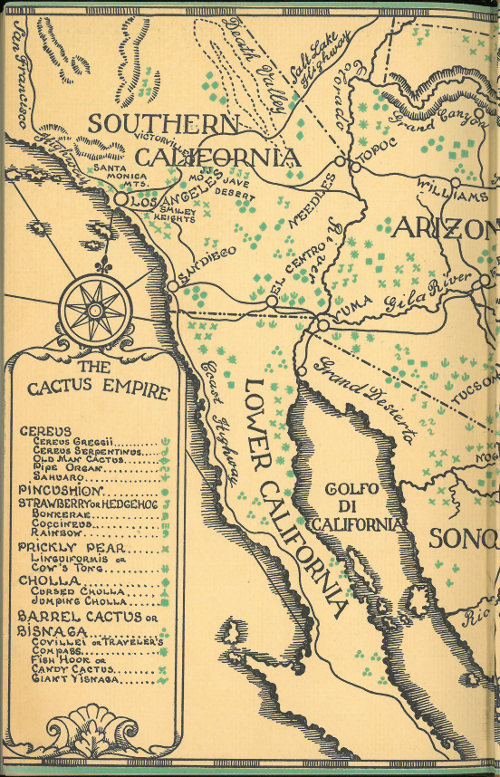
Distribution Map, West
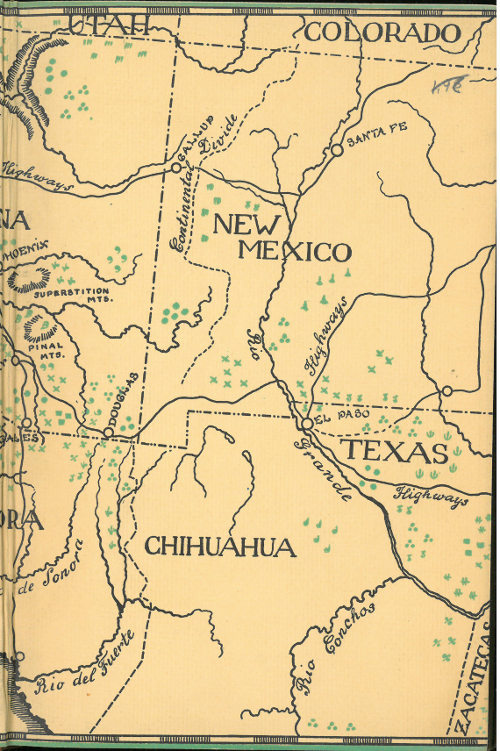
Distribution Map, East
End of the Project Gutenberg EBook of The Fantastic Clan, by
John James Thornber and Frances Bonker
*** END OF THIS PROJECT GUTENBERG EBOOK THE FANTASTIC CLAN ***
***** This file should be named 46155-h.htm or 46155-h.zip *****
This and all associated files of various formats will be found in:
http://www.gutenberg.org/4/6/1/5/46155/
Produced by Stephen Hutcheson, Chris Curnow and the Online
Distributed Proofreading Team at http://www.pgdp.net
Updated editions will replace the previous one--the old editions
will be renamed.
Creating the works from public domain print editions means that no
one owns a United States copyright in these works, so the Foundation
(and you!) can copy and distribute it in the United States without
permission and without paying copyright royalties. Special rules,
set forth in the General Terms of Use part of this license, apply to
copying and distributing Project Gutenberg-tm electronic works to
protect the PROJECT GUTENBERG-tm concept and trademark. Project
Gutenberg is a registered trademark, and may not be used if you
charge for the eBooks, unless you receive specific permission. If you
do not charge anything for copies of this eBook, complying with the
rules is very easy. You may use this eBook for nearly any purpose
such as creation of derivative works, reports, performances and
research. They may be modified and printed and given away--you may do
practically ANYTHING with public domain eBooks. Redistribution is
subject to the trademark license, especially commercial
redistribution.
*** START: FULL LICENSE ***
THE FULL PROJECT GUTENBERG LICENSE
PLEASE READ THIS BEFORE YOU DISTRIBUTE OR USE THIS WORK
To protect the Project Gutenberg-tm mission of promoting the free
distribution of electronic works, by using or distributing this work
(or any other work associated in any way with the phrase "Project
Gutenberg"), you agree to comply with all the terms of the Full Project
Gutenberg-tm License available with this file or online at
www.gutenberg.org/license.
Section 1. General Terms of Use and Redistributing Project Gutenberg-tm
electronic works
1.A. By reading or using any part of this Project Gutenberg-tm
electronic work, you indicate that you have read, understand, agree to
and accept all the terms of this license and intellectual property
(trademark/copyright) agreement. If you do not agree to abide by all
the terms of this agreement, you must cease using and return or destroy
all copies of Project Gutenberg-tm electronic works in your possession.
If you paid a fee for obtaining a copy of or access to a Project
Gutenberg-tm electronic work and you do not agree to be bound by the
terms of this agreement, you may obtain a refund from the person or
entity to whom you paid the fee as set forth in paragraph 1.E.8.
1.B. "Project Gutenberg" is a registered trademark. It may only be
used on or associated in any way with an electronic work by people who
agree to be bound by the terms of this agreement. There are a few
things that you can do with most Project Gutenberg-tm electronic works
even without complying with the full terms of this agreement. See
paragraph 1.C below. There are a lot of things you can do with Project
Gutenberg-tm electronic works if you follow the terms of this agreement
and help preserve free future access to Project Gutenberg-tm electronic
works. See paragraph 1.E below.
1.C. The Project Gutenberg Literary Archive Foundation ("the Foundation"
or PGLAF), owns a compilation copyright in the collection of Project
Gutenberg-tm electronic works. Nearly all the individual works in the
collection are in the public domain in the United States. If an
individual work is in the public domain in the United States and you are
located in the United States, we do not claim a right to prevent you from
copying, distributing, performing, displaying or creating derivative
works based on the work as long as all references to Project Gutenberg
are removed. Of course, we hope that you will support the Project
Gutenberg-tm mission of promoting free access to electronic works by
freely sharing Project Gutenberg-tm works in compliance with the terms of
this agreement for keeping the Project Gutenberg-tm name associated with
the work. You can easily comply with the terms of this agreement by
keeping this work in the same format with its attached full Project
Gutenberg-tm License when you share it without charge with others.
1.D. The copyright laws of the place where you are located also govern
what you can do with this work. Copyright laws in most countries are in
a constant state of change. If you are outside the United States, check
the laws of your country in addition to the terms of this agreement
before downloading, copying, displaying, performing, distributing or
creating derivative works based on this work or any other Project
Gutenberg-tm work. The Foundation makes no representations concerning
the copyright status of any work in any country outside the United
States.
1.E. Unless you have removed all references to Project Gutenberg:
1.E.1. The following sentence, with active links to, or other immediate
access to, the full Project Gutenberg-tm License must appear prominently
whenever any copy of a Project Gutenberg-tm work (any work on which the
phrase "Project Gutenberg" appears, or with which the phrase "Project
Gutenberg" is associated) is accessed, displayed, performed, viewed,
copied or distributed:
This eBook is for the use of anyone anywhere at no cost and with
almost no restrictions whatsoever. You may copy it, give it away or
re-use it under the terms of the Project Gutenberg License included
with this eBook or online at www.gutenberg.org
1.E.2. If an individual Project Gutenberg-tm electronic work is derived
from the public domain (does not contain a notice indicating that it is
posted with permission of the copyright holder), the work can be copied
and distributed to anyone in the United States without paying any fees
or charges. If you are redistributing or providing access to a work
with the phrase "Project Gutenberg" associated with or appearing on the
work, you must comply either with the requirements of paragraphs 1.E.1
through 1.E.7 or obtain permission for the use of the work and the
Project Gutenberg-tm trademark as set forth in paragraphs 1.E.8 or
1.E.9.
1.E.3. If an individual Project Gutenberg-tm electronic work is posted
with the permission of the copyright holder, your use and distribution
must comply with both paragraphs 1.E.1 through 1.E.7 and any additional
terms imposed by the copyright holder. Additional terms will be linked
to the Project Gutenberg-tm License for all works posted with the
permission of the copyright holder found at the beginning of this work.
1.E.4. Do not unlink or detach or remove the full Project Gutenberg-tm
License terms from this work, or any files containing a part of this
work or any other work associated with Project Gutenberg-tm.
1.E.5. Do not copy, display, perform, distribute or redistribute this
electronic work, or any part of this electronic work, without
prominently displaying the sentence set forth in paragraph 1.E.1 with
active links or immediate access to the full terms of the Project
Gutenberg-tm License.
1.E.6. You may convert to and distribute this work in any binary,
compressed, marked up, nonproprietary or proprietary form, including any
word processing or hypertext form. However, if you provide access to or
distribute copies of a Project Gutenberg-tm work in a format other than
"Plain Vanilla ASCII" or other format used in the official version
posted on the official Project Gutenberg-tm web site (www.gutenberg.org),
you must, at no additional cost, fee or expense to the user, provide a
copy, a means of exporting a copy, or a means of obtaining a copy upon
request, of the work in its original "Plain Vanilla ASCII" or other
form. Any alternate format must include the full Project Gutenberg-tm
License as specified in paragraph 1.E.1.
1.E.7. Do not charge a fee for access to, viewing, displaying,
performing, copying or distributing any Project Gutenberg-tm works
unless you comply with paragraph 1.E.8 or 1.E.9.
1.E.8. You may charge a reasonable fee for copies of or providing
access to or distributing Project Gutenberg-tm electronic works provided
that
- You pay a royalty fee of 20% of the gross profits you derive from
the use of Project Gutenberg-tm works calculated using the method
you already use to calculate your applicable taxes. The fee is
owed to the owner of the Project Gutenberg-tm trademark, but he
has agreed to donate royalties under this paragraph to the
Project Gutenberg Literary Archive Foundation. Royalty payments
must be paid within 60 days following each date on which you
prepare (or are legally required to prepare) your periodic tax
returns. Royalty payments should be clearly marked as such and
sent to the Project Gutenberg Literary Archive Foundation at the
address specified in Section 4, "Information about donations to
the Project Gutenberg Literary Archive Foundation."
- You provide a full refund of any money paid by a user who notifies
you in writing (or by e-mail) within 30 days of receipt that s/he
does not agree to the terms of the full Project Gutenberg-tm
License. You must require such a user to return or
destroy all copies of the works possessed in a physical medium
and discontinue all use of and all access to other copies of
Project Gutenberg-tm works.
- You provide, in accordance with paragraph 1.F.3, a full refund of any
money paid for a work or a replacement copy, if a defect in the
electronic work is discovered and reported to you within 90 days
of receipt of the work.
- You comply with all other terms of this agreement for free
distribution of Project Gutenberg-tm works.
1.E.9. If you wish to charge a fee or distribute a Project Gutenberg-tm
electronic work or group of works on different terms than are set
forth in this agreement, you must obtain permission in writing from
both the Project Gutenberg Literary Archive Foundation and Michael
Hart, the owner of the Project Gutenberg-tm trademark. Contact the
Foundation as set forth in Section 3 below.
1.F.
1.F.1. Project Gutenberg volunteers and employees expend considerable
effort to identify, do copyright research on, transcribe and proofread
public domain works in creating the Project Gutenberg-tm
collection. Despite these efforts, Project Gutenberg-tm electronic
works, and the medium on which they may be stored, may contain
"Defects," such as, but not limited to, incomplete, inaccurate or
corrupt data, transcription errors, a copyright or other intellectual
property infringement, a defective or damaged disk or other medium, a
computer virus, or computer codes that damage or cannot be read by
your equipment.
1.F.2. LIMITED WARRANTY, DISCLAIMER OF DAMAGES - Except for the "Right
of Replacement or Refund" described in paragraph 1.F.3, the Project
Gutenberg Literary Archive Foundation, the owner of the Project
Gutenberg-tm trademark, and any other party distributing a Project
Gutenberg-tm electronic work under this agreement, disclaim all
liability to you for damages, costs and expenses, including legal
fees. YOU AGREE THAT YOU HAVE NO REMEDIES FOR NEGLIGENCE, STRICT
LIABILITY, BREACH OF WARRANTY OR BREACH OF CONTRACT EXCEPT THOSE
PROVIDED IN PARAGRAPH 1.F.3. YOU AGREE THAT THE FOUNDATION, THE
TRADEMARK OWNER, AND ANY DISTRIBUTOR UNDER THIS AGREEMENT WILL NOT BE
LIABLE TO YOU FOR ACTUAL, DIRECT, INDIRECT, CONSEQUENTIAL, PUNITIVE OR
INCIDENTAL DAMAGES EVEN IF YOU GIVE NOTICE OF THE POSSIBILITY OF SUCH
DAMAGE.
1.F.3. LIMITED RIGHT OF REPLACEMENT OR REFUND - If you discover a
defect in this electronic work within 90 days of receiving it, you can
receive a refund of the money (if any) you paid for it by sending a
written explanation to the person you received the work from. If you
received the work on a physical medium, you must return the medium with
your written explanation. The person or entity that provided you with
the defective work may elect to provide a replacement copy in lieu of a
refund. If you received the work electronically, the person or entity
providing it to you may choose to give you a second opportunity to
receive the work electronically in lieu of a refund. If the second copy
is also defective, you may demand a refund in writing without further
opportunities to fix the problem.
1.F.4. Except for the limited right of replacement or refund set forth
in paragraph 1.F.3, this work is provided to you 'AS-IS', WITH NO OTHER
WARRANTIES OF ANY KIND, EXPRESS OR IMPLIED, INCLUDING BUT NOT LIMITED TO
WARRANTIES OF MERCHANTABILITY OR FITNESS FOR ANY PURPOSE.
1.F.5. Some states do not allow disclaimers of certain implied
warranties or the exclusion or limitation of certain types of damages.
If any disclaimer or limitation set forth in this agreement violates the
law of the state applicable to this agreement, the agreement shall be
interpreted to make the maximum disclaimer or limitation permitted by
the applicable state law. The invalidity or unenforceability of any
provision of this agreement shall not void the remaining provisions.
1.F.6. INDEMNITY - You agree to indemnify and hold the Foundation, the
trademark owner, any agent or employee of the Foundation, anyone
providing copies of Project Gutenberg-tm electronic works in accordance
with this agreement, and any volunteers associated with the production,
promotion and distribution of Project Gutenberg-tm electronic works,
harmless from all liability, costs and expenses, including legal fees,
that arise directly or indirectly from any of the following which you do
or cause to occur: (a) distribution of this or any Project Gutenberg-tm
work, (b) alteration, modification, or additions or deletions to any
Project Gutenberg-tm work, and (c) any Defect you cause.
Section 2. Information about the Mission of Project Gutenberg-tm
Project Gutenberg-tm is synonymous with the free distribution of
electronic works in formats readable by the widest variety of computers
including obsolete, old, middle-aged and new computers. It exists
because of the efforts of hundreds of volunteers and donations from
people in all walks of life.
Volunteers and financial support to provide volunteers with the
assistance they need are critical to reaching Project Gutenberg-tm's
goals and ensuring that the Project Gutenberg-tm collection will
remain freely available for generations to come. In 2001, the Project
Gutenberg Literary Archive Foundation was created to provide a secure
and permanent future for Project Gutenberg-tm and future generations.
To learn more about the Project Gutenberg Literary Archive Foundation
and how your efforts and donations can help, see Sections 3 and 4
and the Foundation information page at www.gutenberg.org
Section 3. Information about the Project Gutenberg Literary Archive
Foundation
The Project Gutenberg Literary Archive Foundation is a non profit
501(c)(3) educational corporation organized under the laws of the
state of Mississippi and granted tax exempt status by the Internal
Revenue Service. The Foundation's EIN or federal tax identification
number is 64-6221541. Contributions to the Project Gutenberg
Literary Archive Foundation are tax deductible to the full extent
permitted by U.S. federal laws and your state's laws.
The Foundation's principal office is located at 4557 Melan Dr. S.
Fairbanks, AK, 99712., but its volunteers and employees are scattered
throughout numerous locations. Its business office is located at 809
North 1500 West, Salt Lake City, UT 84116, (801) 596-1887. Email
contact links and up to date contact information can be found at the
Foundation's web site and official page at www.gutenberg.org/contact
For additional contact information:
Dr. Gregory B. Newby
Chief Executive and Director
gbnewby@pglaf.org
Section 4. Information about Donations to the Project Gutenberg
Literary Archive Foundation
Project Gutenberg-tm depends upon and cannot survive without wide
spread public support and donations to carry out its mission of
increasing the number of public domain and licensed works that can be
freely distributed in machine readable form accessible by the widest
array of equipment including outdated equipment. Many small donations
($1 to $5,000) are particularly important to maintaining tax exempt
status with the IRS.
The Foundation is committed to complying with the laws regulating
charities and charitable donations in all 50 states of the United
States. Compliance requirements are not uniform and it takes a
considerable effort, much paperwork and many fees to meet and keep up
with these requirements. We do not solicit donations in locations
where we have not received written confirmation of compliance. To
SEND DONATIONS or determine the status of compliance for any
particular state visit www.gutenberg.org/donate
While we cannot and do not solicit contributions from states where we
have not met the solicitation requirements, we know of no prohibition
against accepting unsolicited donations from donors in such states who
approach us with offers to donate.
International donations are gratefully accepted, but we cannot make
any statements concerning tax treatment of donations received from
outside the United States. U.S. laws alone swamp our small staff.
Please check the Project Gutenberg Web pages for current donation
methods and addresses. Donations are accepted in a number of other
ways including checks, online payments and credit card donations.
To donate, please visit: www.gutenberg.org/donate
Section 5. General Information About Project Gutenberg-tm electronic
works.
Professor Michael S. Hart was the originator of the Project Gutenberg-tm
concept of a library of electronic works that could be freely shared
with anyone. For forty years, he produced and distributed Project
Gutenberg-tm eBooks with only a loose network of volunteer support.
Project Gutenberg-tm eBooks are often created from several printed
editions, all of which are confirmed as Public Domain in the U.S.
unless a copyright notice is included. Thus, we do not necessarily
keep eBooks in compliance with any particular paper edition.
Most people start at our Web site which has the main PG search facility:
www.gutenberg.org
This Web site includes information about Project Gutenberg-tm,
including how to make donations to the Project Gutenberg Literary
Archive Foundation, how to help produce our new eBooks, and how to
subscribe to our email newsletter to hear about new eBooks.